







It’s what we do
Tom Foster - Editor
y the time this issue hits the newsstands just about everything that can be possibly be said about the 2016 Dakar will have been written, broadcast, rewritten, poached and found its way on to web forums in one form or another. That’s great. As long as everyone’s talking about it, it can only be good for Toby Price and for adventure riding in general.
Australians are understandably excited about an Aussie finally winning the world’s toughest motorcycle race, and while I’ve never been a hard-core Dakar fan – I’m not good at navigation and I have nightmares about having to ride the fesh fesh – this year I sat glued to the SBS highlights every night and couldn’t wait to get to the computer each morning to see what’d happened while was sleeping.
Price won. That’s an obvious highlight for all of us.
But there were other things that struck me as at the heart of adventure riding, and as I sit here glowing with happiness at the result, I’m also filled with respect and awe for some of the other things I saw.
The first is Sylvain Espinasse. The 46-yearold Frenchman successfully completed the 2016 Dakar on a 125cc two-stroke. To me it underlined that there’s no such
“Adventure is in the heart of the rider. Sylvain must have a heart the size of Tasmania (and ’nads like a stud bull).”
thing as ‘adventure bike’. Adventure is in the heart of the rider. Sylvain must have a heart the size of Tasmania (and ’nads like a stud bull).
Another aspect of the Dakar found uplifting was the support from the South American public.
I’ve never competed in, or spectated at,
a Dakar, but it seems the spectators get a huge kick out of helping competitors. feel there’s hope for the human race when I see a bunch of people jump in to help someone who must seem like he’s from another world, but who’s obviously in trouble. It’s even more uplifting to see how much some of those competitors are genuinely humbled by, and grateful for, that help when it’s offered. Finally – because I don’t want to bore everyone by going on and on – my heart goes out to the Malle Moto competitors. Surely that’s the spirit of competitive bike adventure at its most extreme? There’s nothing so heartbreaking as the sight of the boxes with the big crosses on them, or the tearful faces of riders who are so close to the end of their endurance that they can barely speak. They’re long past the normal boundary of physical exhaustion and tears are the only outlet for their overwrought emotions and devastated hopes. only saw it on TV and I feel I need a year to prepare for the next one.
I’ll hold those thoughts close next time I feel things are tough. Maybe it’ll evoke enough of the Dakar spirit to pull me through whatever piss-ant situation I think is causing me a problem.



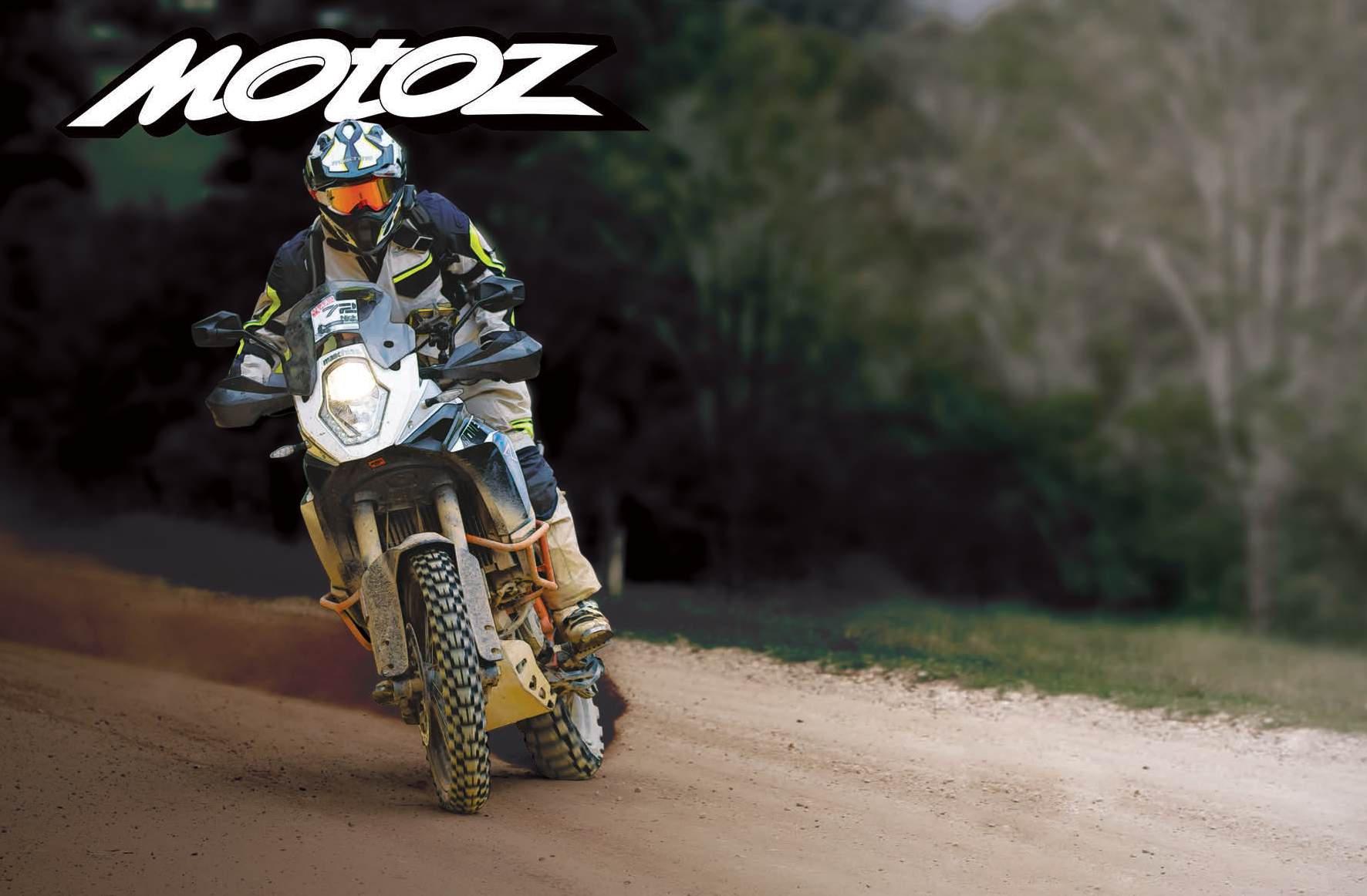
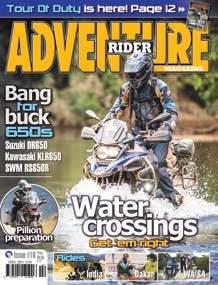


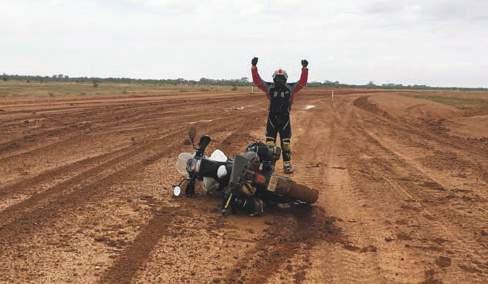
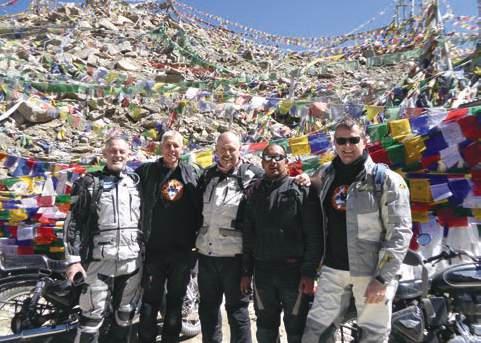

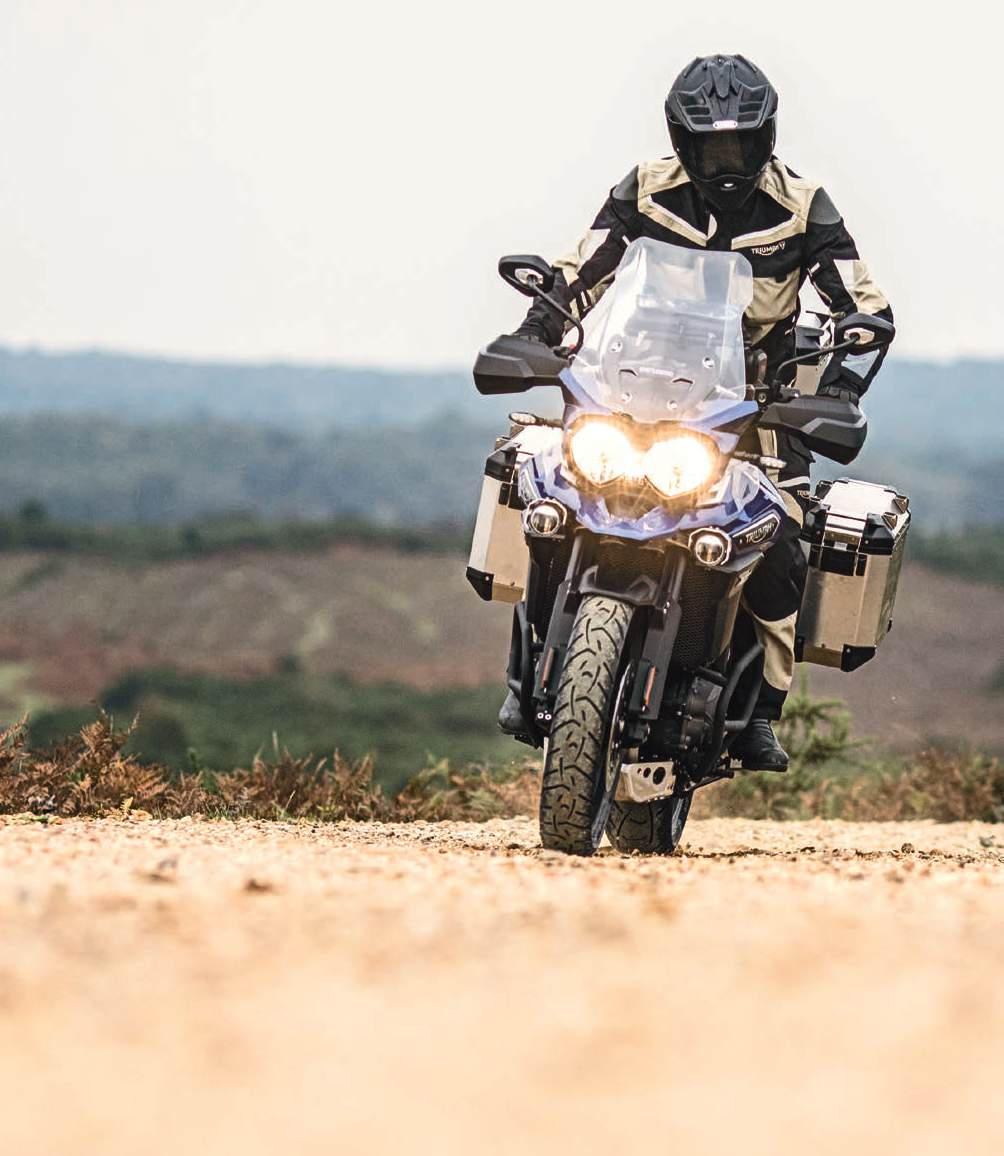

Adventure Rider Magazine is published bi-monthly by Mayne Media Group Pty Ltd
Publisher Kurt M Quambusch
Editor Tom Foster tom@maynemedia.com.au
Sales Director
Marcus Hucker marcus@maynemedia.com.au
Advertising Sales
Ditch Newell mitch@maynemedia.com.au
Phone: (02) 9452 4517 Mobile: 0402 202 870
Design Danny Bourke art@maynemedia.com.au
Subscriptions (02) 8355 6841
Accounts
Jeewan Gnawali jeewan@maynemedia.com.au ISSN 2201-1218
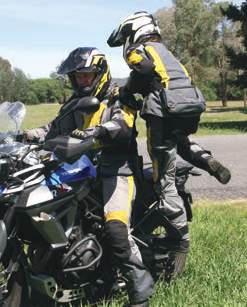
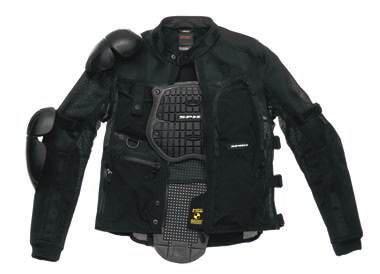
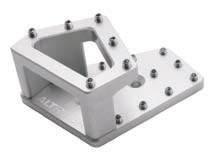

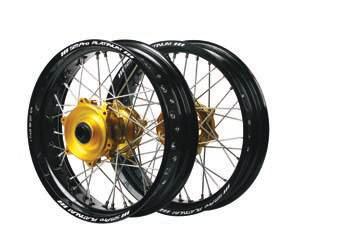
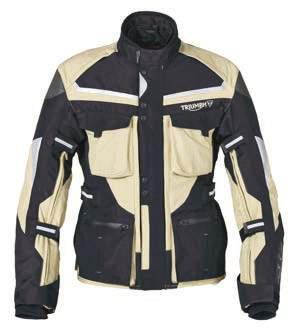
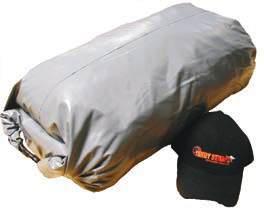

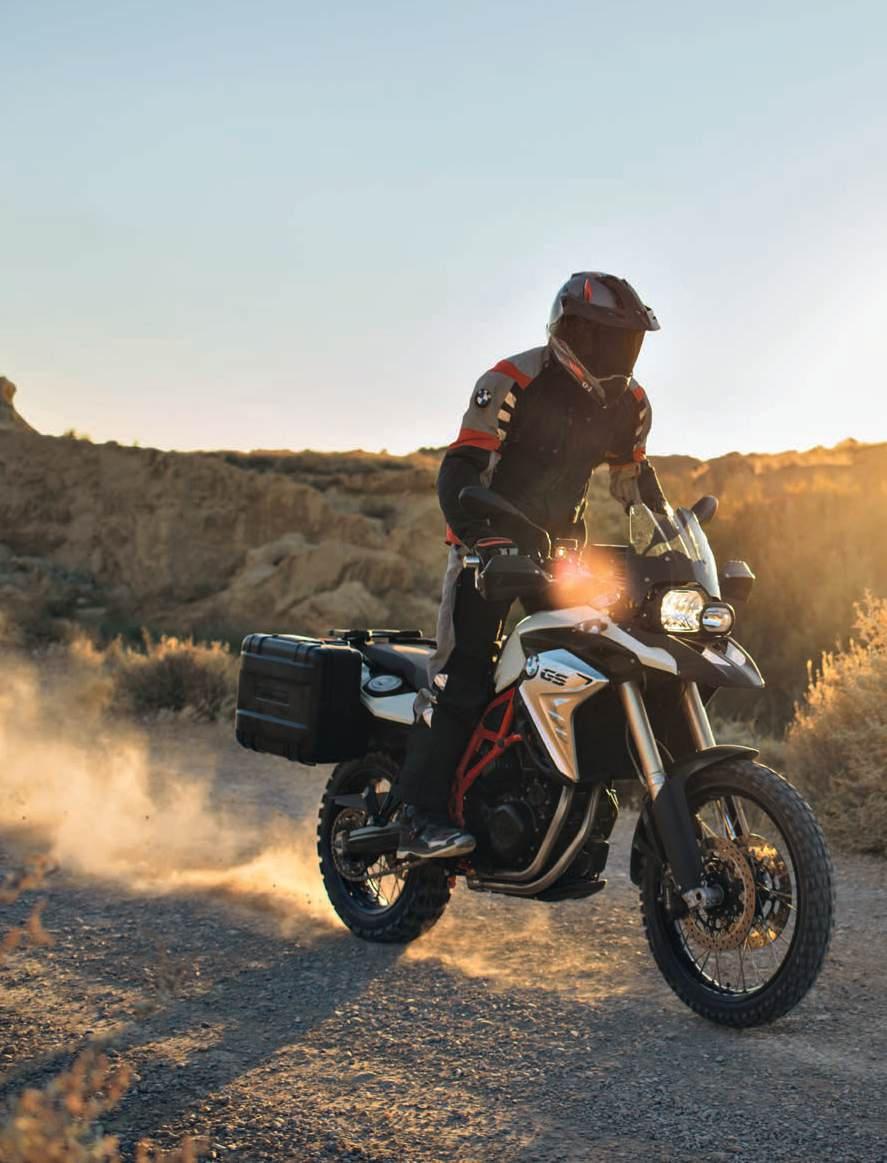


























































































































































Ad-man Mitch Newell has taken over the magazine’s tough-asa-boot KLR650, and he’s giving it a workout.
RideADV runs great events, so when the BBB three-day was scheduled to run just up the road from the office, editor TF and ad manager Mitch Newell signed up, lined up and gave work the wind up.
Everything was going so well until, late on the second day, a slippery corner and an oncoming 4WD had the mighty shop bike in a spot of bother.
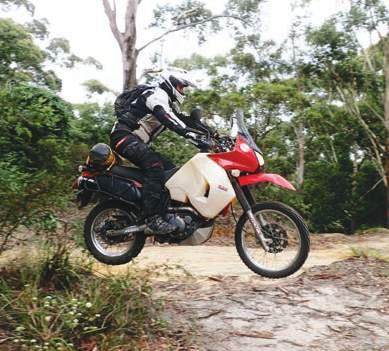
1. 2.
at:
picture to enter the competition
So did Mitch, but he had to put up with everyone changing his name to ‘Ditch’.
It’ll take a while to live that one down (if we have anything to do with it)!
Fortunately, now Mitch has started riding adventure, his friendless motocross days are behind him, and it was a goodhumoured bunch that dragged him from what could’ve been a very ugly position. As usual, the KLR was dusted off, set back on its wheels and finished the event as though nothing had happened.
A big thanks to the RideADV, AdventureMoto and Yamaha guys for running a great ride with recovery and logistics well sorted. And special thanks to Mitch’s new mates Scott, Greg and Bruce for much-appreciated assistance.




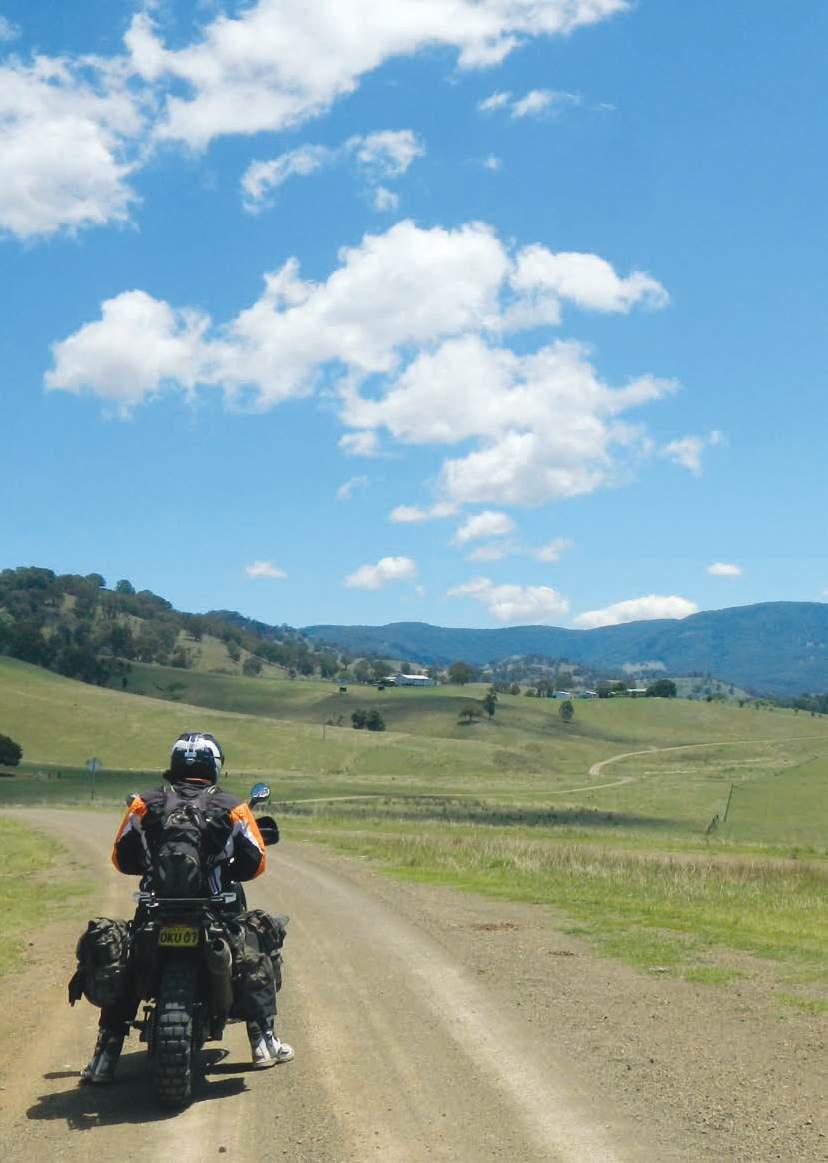
The


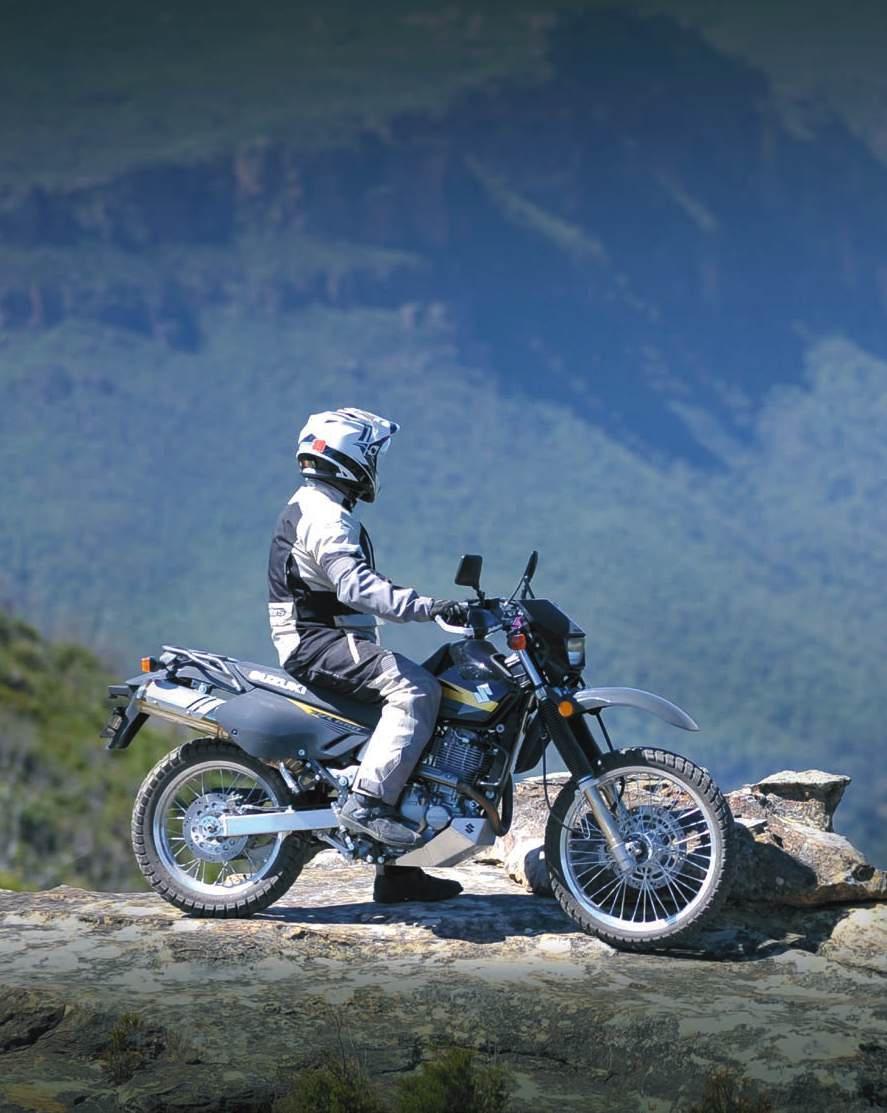







Kurt Quambusch (the publisher of Adventure Rider Magazine) and I (Darin Rowley, owner of Adventure Motorcycle Equipment) were discussing important issues. We decided: KTM orange is a great colour; if every motorcycle sounded like a KTM 990 with an Akrapovic pipe, we’d still never get sick of the sound; single-cylinder adventure motorcycles could get you a lot of places; and there are a lot of people taking up adventure riding. With all this worldly information processed, Kurt looked at me between bites of his bacon-and-egg roll and slurps of strong coffee and I could see a penny had dropped.
He’d had an idea!
He managed to expel snippets of his concept and food that translated to, “Let’s provide quality four-day adventure rides that new adventurers can simply put into their GPS and follow!”
“Hell, yes,” was my response. “There might be an afterlife, but I’m riding now!”
After a couple of quick phone calls and a few kilometres we found ourselves at Moonan Flat’s Victoria Hotel on a perfect mild-blue-sky day. It was all organised a good 12 hours in advance.
Meet and greet
The pleasantries were exchanged with Kurt explaining his glorious run from Wisemans Ferry, through the Watagans, past Singleton and over the western side of Barrington Tops. I recounted my run from Canberra, rerouting due to flooded rivers and camping on a sensational hilltop near Muswellbrook. This dialogue was completed, along with the obligatory handshake, in a minute or so without Kurt removing his earplugs. It was obvious he was being seduced by his 990. The burble of the lumpy twin with new horizons unfolding in front and a roost of dust viewed in his mirrors had him wanting more, so we fired up our trusty steeds and headed north.
We enjoyed the smooth, easy dirt roads to Ellerston, a Packer family property that runs cattle and sheep and hosts some of Australia’s best polo playing fields. It’s also home to a golf course designed by Greg Norman and Bob Harrison. The thing that caught my eye was the motard/kart track. I’d like to have pointed the pint-size WR250R around it, but I suspected the
u
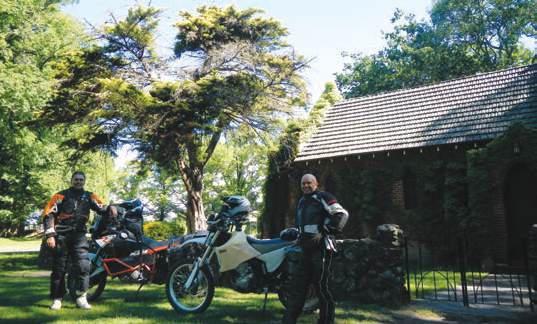


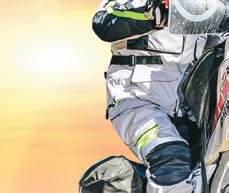
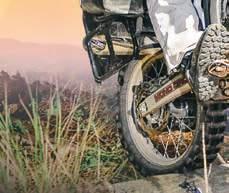


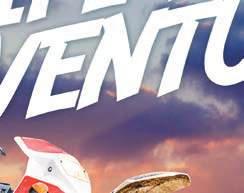
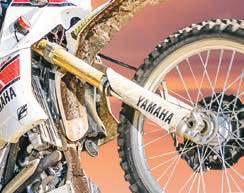
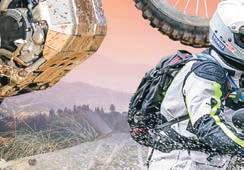








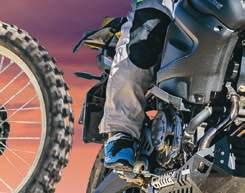
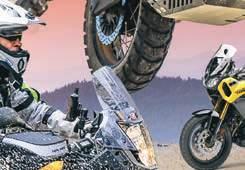



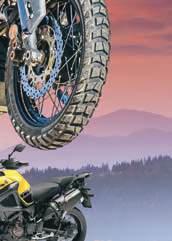








Above: Publisher Kurt giving thumbs up at the Victoria Hotel, Moonan Flat. Adventure-rider fever had taken hold.
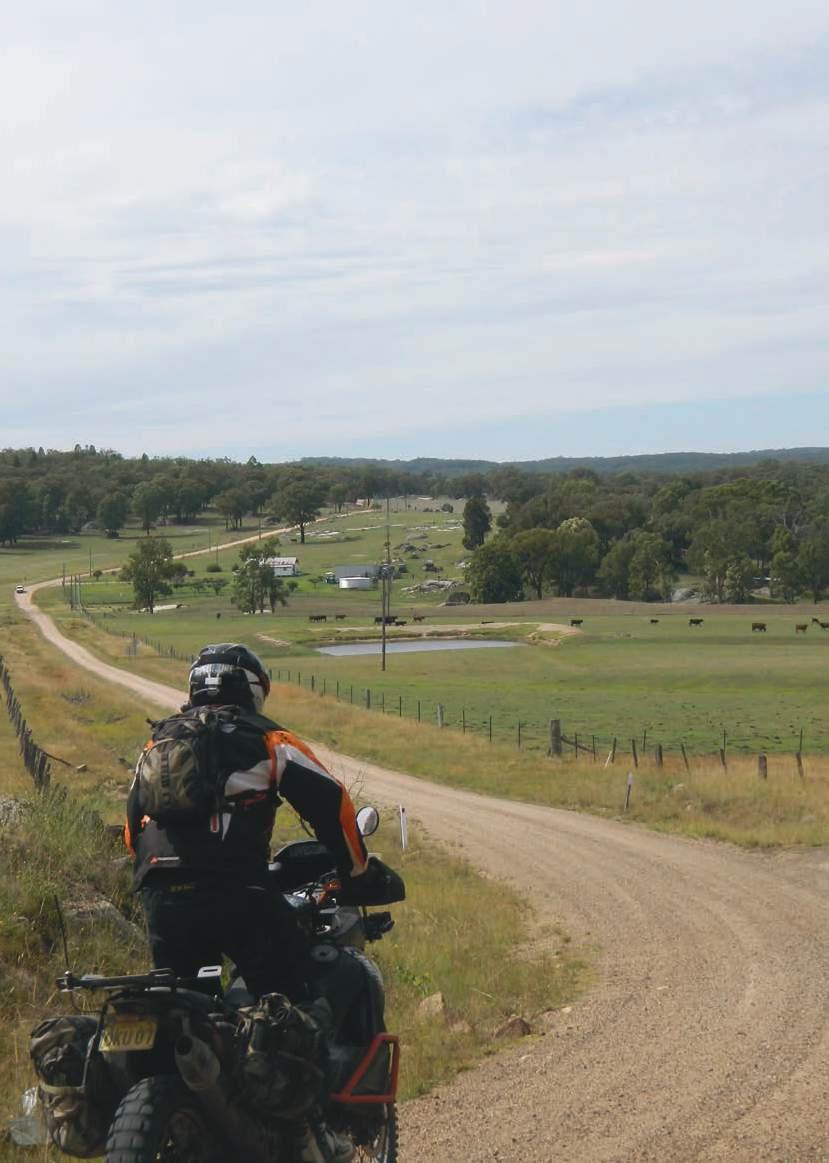

security team would’ve swung into action. Kurt and I were stopping for photos and trying to capture the feeling of what we were experiencing. A brief discussion over who should be the pin-up man for this story quickly arrived at the decision to leave our helmets on whenever possible (to make the photos look good). We pointed our front wheels towards Timor, flowing through rolling green hills under a blue sky and feeling the countryside as we passed through was very relaxing. Kurt and I discussed this feeling and we understood this was what adventure riders craved. For us, it was decompression from a hectic domestic existence and a required outlet to keep day-to-day life on an even keel.
From Timor we motored north on Crawney Road to Nundle and were absorbed in the countryside. Basalt gave way to limestone and before we knew it we were at Nundle. We refuelled, got a room at the Peel Inn – built in 1860 – and enjoyed a cold beer or two on the pub balcony, followed by a hearty meal. It was a nice way to finish the day with about 400 relaxing kilometres covered from Wisemans Ferry.


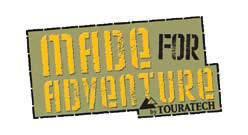
Nundle is an 1850s gold-mining town. It’s interesting to consider the goldfield yielded a reported eight tons of alluvial gold and two tons of reef gold. At today’s value of $1580 per ounce that gives about half-a-billion dollars pulled out of this area. Imagine what wasn’t reported? If it’s like any of the goldfields I’ve seen, there’ll be some colourful history around this town, so it may be worth having a look around the old gold-mining areas.
Fire down below
We were up well past the crack of dawn and off north to Walcha through a network of soothing dirt roads. The not-so-early morning air was refreshing and the near misses with kangaroos sobering. I did need a spatula to remove my bum from my seat after I puckered down a little, tightly braking for a ’roo and then getting on the gas thinking I was going to hit it.
The roads traversed State forests, giving way to open agricultural land and providing a great start to the day. From Walcha we pointed our distinctly different bikes north, taking the backroads to Gostwyck. I thought I’d have some fun and pitched the little WR250R into a standing-start drag race with Kurt’s 990. Needless to say, the 990 sounded
Below: Flowing, smooth, riding heading south from Bundarra to Bendemeer. u

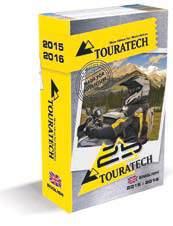

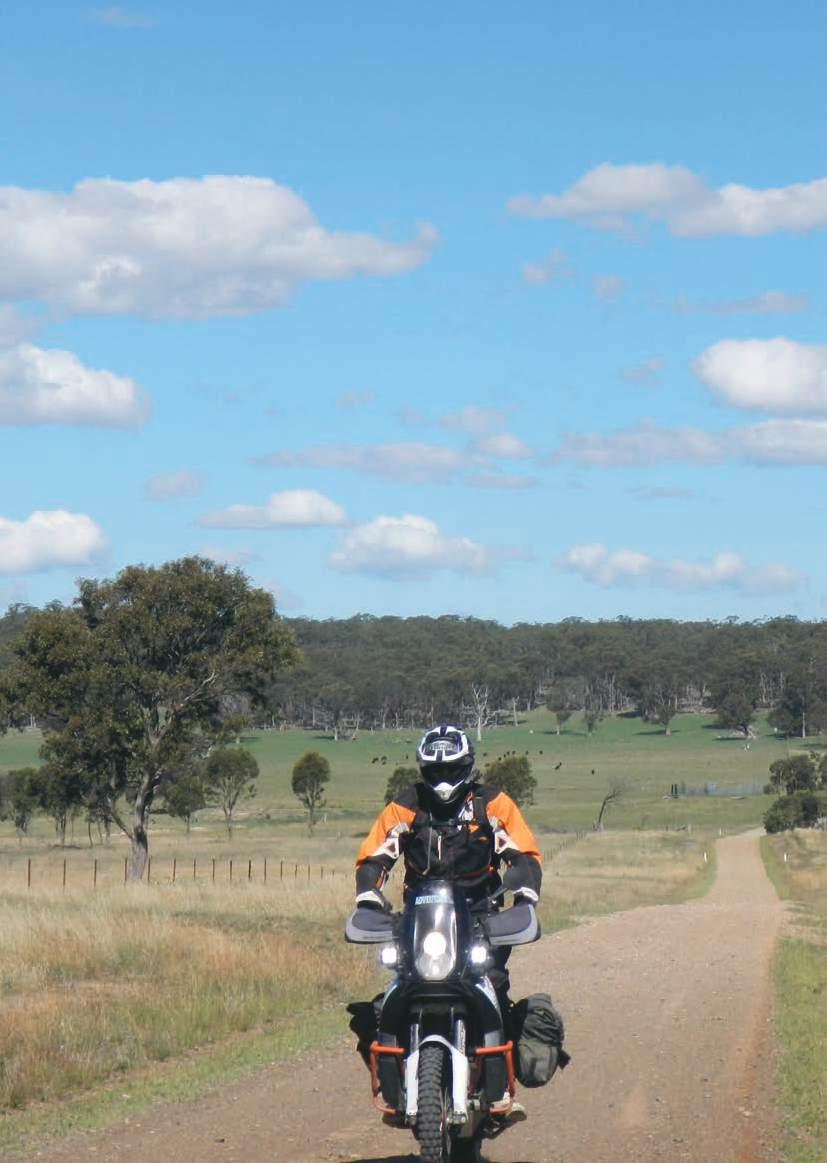

awesome and went past me in a shower of rocks at about the 90kph mark. I had to grin! It was good to see Adventure Rider Magazine’s publisher with a bit of fire in his belly.
After traversing the Salisbury plains, where there are a number of large shearing sheds as a testament to sheep farming in the area since the 1830s, we stopped in at the Gostwyck Chapel. This chapel was built with bricks fired on Gostwyck station in 1921, and stands in memory of Major Clive Collingwood Dangar, who lost his life during the first world war. Two hundred elms imported specifically from England provide a magnificent tree-lined avenue and the chapel is covered in Virginia creeper. It’s a relaxing, shady place in summer that yields beautiful colours in autumn.
Fish tale
From Gostwyck it was into Armidale, a buzzing, modern, metro hub. We refuelled, rewatered and stocked up with refreshments (Coopers Pale Ale and a tasty shiraz) for our evening at the unique Moredun Ponds property, home of the Adventure Rider Magazine annual Congregation. We followed a series of pleasant, predominantly dirt roads, feeling rather lucky to be in this part of the world.
At Moredun Ponds we were greeted by Jo and AJ who offered we could camp or cabin it, and that hot showers were available either way.
Being a little soft and having ridden on a standard WR250R seat for a number of days – which made me feel like I had a little white bike hanging out my bum at times – we chose the cabins.
We recounted the day over a cold beer, listened to the laconic, dry, country humour of AJ, and I think we even worked out the velocity of light in miles and kilometres per second. We’d overdone the latte stops and only covered 268km, so next time we’re up near Moredun Ponds we vowed to find an extra 50km to 100km of country to explore.
Moredun Ponds is a breeding farm for Murray cod and has a working piggery. You may be able to talk with Jo or AJ and organise a Murray cod feeding or possibly fishing for other species. It’s a very relaxing, affordable location away from it all.
With the sun well above the horizon we headed for Tingha, a town centred on an historic mid- to late-1800s alluvial tin-mining area. This was the most northern location of our ride and we hadn’t really thought about
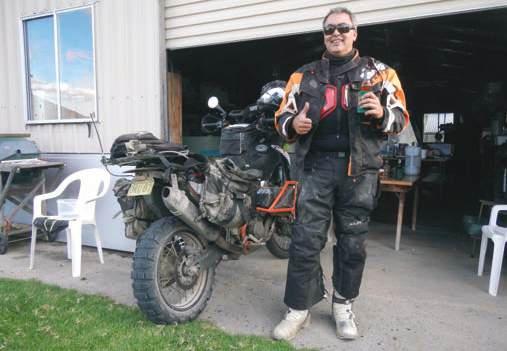
Above: Rehydrating at Moredun Ponds. Below: Kurt ‘Fire In The Belly’ Quambusch enjoying the Salisbury plains.

The world has no boundaries. Over any distance, over any terrain, the new Ducati Multistrada 1200 Enduro is designed to conquer with all new levels of style, performance and technology.
With the 160hp Ducati Testastretta DVT engine, 30 litre fuel tank, 19" front and 17” rear spoked wheels and 200mm wheel travel, it's time to follow the adventure wherever it takes you with no limits.
New Ducati Multistrada 1200 Enduro. We’ve given it everything. Except boundaries.




the best way back, so we pulled up and had a chat. Our collective wisdom was, “Let’s head south on dirt roads we don’t know and make sure we don’t run out of fuel”.
With this flexible mandate we turned south and I laughed at our freedom. We followed a series of smooth country backroads into Bundarra where we refueled. Kurt overcame his caffeine withdrawals with a strong coffee and was thus able to communicate with other humans.
From Bundarra we headed west along the Barraba-Bundarra Road before turning south to Bendemeer along a nice network of farm-access backroads. We felt like we were floating through the scenery without a care in the world. A number of photo stops had us yabbering like a pair of teenagers and, before we knew it, we were in Bendemeer having a pie for smoko at the general store.
You bet
From Bendemeer we plotted a loose route to Nundle and discovered some spectacular riding. It was a very scenic and enjoyable way to head back to Nundle’s Peel Inn. My little WR250R arrived with 800ml of fuel left in the tank. I’d cut that one a bit fine...again. In the wash up, while enjoying a frothy chop at the Peel Inn, we recounted the tranquility and the good-quality roads covered while exploring the 341km of countryside we’d covered that day. It was bloody beautiful! Interestingly, a nugget of a truck driver stopped at the pub, pulled up a stool and raved about his horse and how it was winning races. He also explained he kept horse testicles in his freezer...but that’s another story. He gave us the name of his racehorse and it paid $8 a few days later at the Sale races. In true form, I completely forgot to put on a bet.
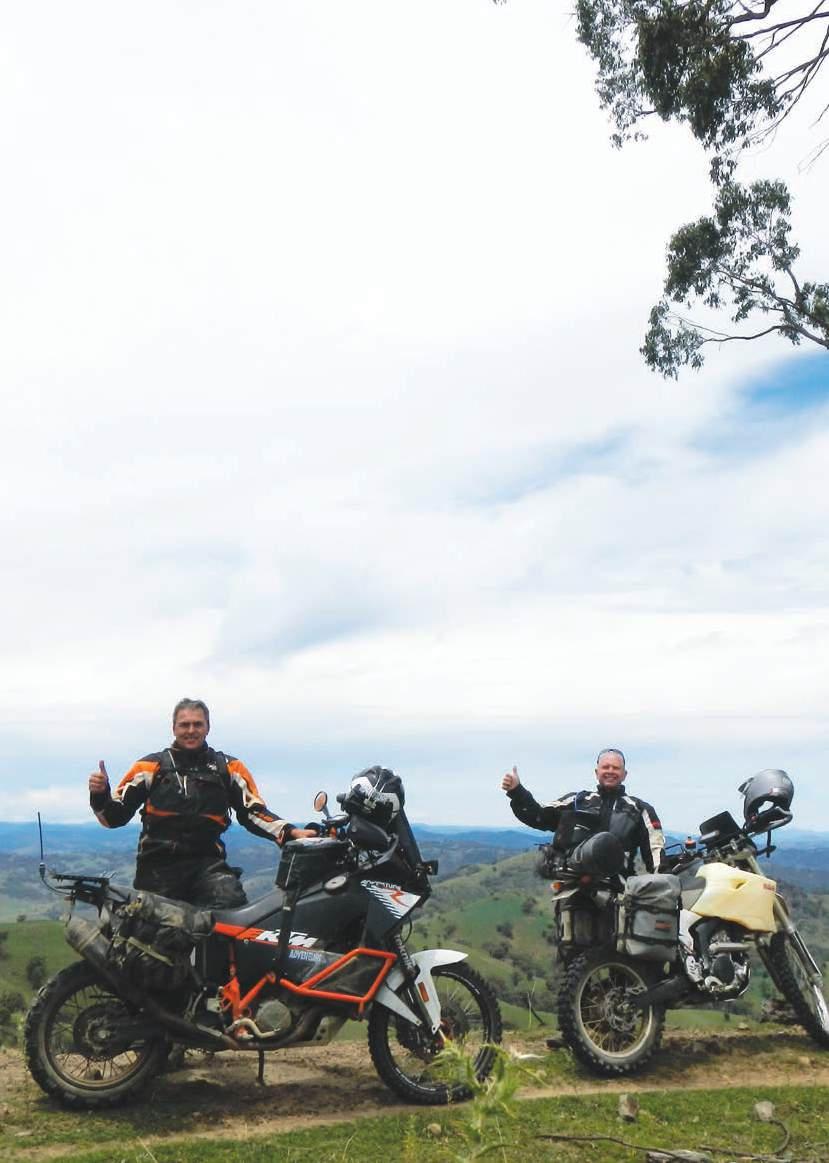

Above: The Peel Inn at Nundle was built in 1860.
Below: The publisher (left), Kurt, and the author, Darin (right, obviously), enjoy sensational views and room to think, somewhere between Bendemeer and Nundle. You can enjoy it, too.

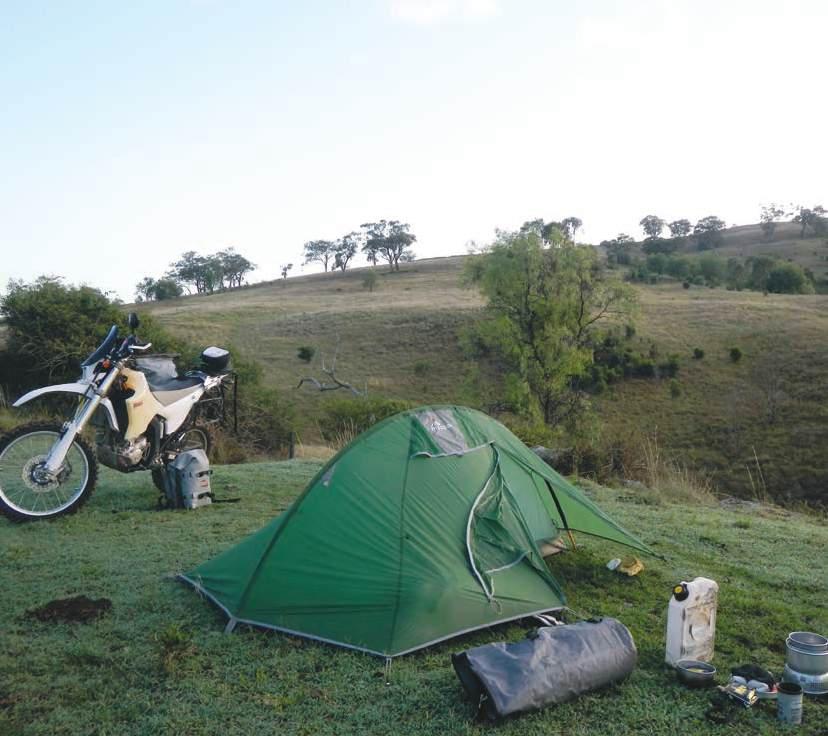
Above: The author camped at Muswellbrook on his way to the rendezvous.
Right: This is just a mud map. If you want the specifics and a set of GPS-ready files, log on to www.advridermag.com.au.
Ready to go again
We went to bed early and actually got up early, departing Nundle heading through Barry Station, Ellerston and arriving in Moonan Flat. We said our brief goodbyes with helmets on and engines running, and almost like horses who know they’re close to home, we parted ways. I returned to Canberra and Kurt found his way home to Sydney. We couldn’t have asked for a better four days. Fully decompressed, I launched back into domestic life, albeit with the next ride already planned.
22 advridermag.com.au
Feel like you’d enjoy this ride? Log on to www.advridermag. com.au/rides and you can download the entire trip as a GPX file with extra track notes – like section distances, accom and where to get fuel. Just load the GPX file into your GPS and retrace the Adventure Rider Magazine team’s every turn of the wheel, taking in the same scenery, the same dirt roads and enjoying the true meaning of the adventure-riding life. Normally the download will set you back $129, but seeing as this is the first one, and the publisher’s still glowing after his four days of supreme adventure riding, he’s offering an introductory deal at only $99.
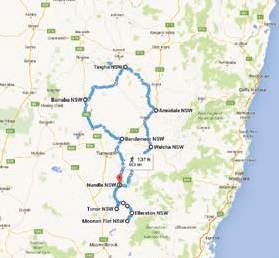
Get in quick before work catches up with him and he gets grumpy and jacks the price up again!
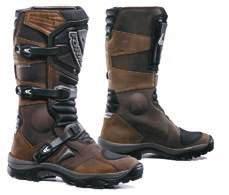
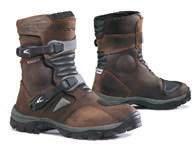

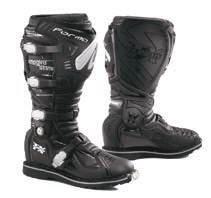

If it’s true an image of your life flashes before your eyes when facing your own end, then my riding companions and I agreed India promised to be an endless bloody slide show.

We’d come to India to ride locally made Royal Enfields from the Himalayas in India’s north to India’s southern tip, Cape Cormorin, locally known as Kanyakumari. Four old farts –Steve Thurecht, the least farty of us, Simon Richardson, quite farty, my brother Ian who was very farty indeed and myself who’s only moderately farty – arrived in Srinigar, Kashmir, to ride east across the Himalayas to Leh, before turning south and down through New Delhi and the centre of India to the southern coast. That added up to around 6600km in 30 days.
It was the first Great Indian Ride.
Catching a breath
After the success of the annual Great Australian Ride from Australia’s easternmost to westernmost points each year, which has over the last five years raised around $180,000 for Australian charity SIDS And Kids, organiser Stuart Ball decided to transfer the concept and launch an annual ride on the subcontinent to raise money for Plan India, a charity which helps Indian children.
In the end Stuart couldn’t make the inaugural ride so just the aforementioned
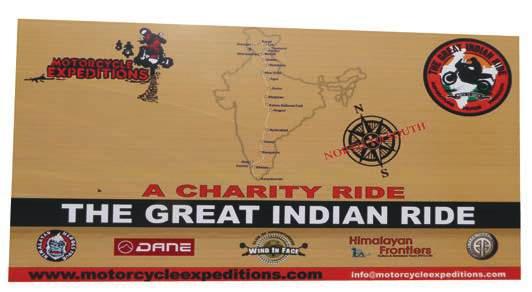
four found ourselves on a houseboat in Dal Lake, Kashmir, to acclimatise for a few days before heading off to higher altitudes and our 30-day tour of India.
For the first Great Indian Ride, Stuart had organised for the ride to be led and supported by Motorcycle Expeditions, a motorcycle adventure tour company based in Manali, India. ME provided the bikes, two guides, a support vehicle to carry our gear, a range of spares and a mechanic.
The latter came in very handy to repair the numerous flat tyres, replace broken clutch
cables, weld a broken frame and to change out the various bits and pieces that got scratched, bent or broken as we battled Indian roads and drivers.
We passed the three days waiting for the bikes to arrive by visiting the scenic foothills of the Himalayas at Sonamarg and were very quickly breathless from hiking
u

up to the melting ice at just 2800m. We also visited the sights in Srinigar where we were beset by local kids wanting their photograph taken before they were hunted off by their parents.
Finally September 15th arrived and with it our introduction to the bikes.
We did a lap of Dal Lake and found the joys of riding in Indian traffic, including dodging crazy drivers and the everpresent cows.
The next day we rode out to Gulmarg ski field and back to get the feel of the bikes.
Unknown to us, a youth from a village along the way had been found dead. Villagers claimed he’d been tortured and killed by the Indian Army, the fourth in the last week. India has some 300,000 troops in Kashmir as a buffer to Pakistan and to quell Kashmiri aspirations for independence. We were met with burning tyres and a large number of youths on the road, one of whom took a swipe at my helmet-mounted GoPro as I rode past, but no harm was done on an otherwise beautiful scenic ride. We were later interviewed by TV and newspaper crews to help promote tourism in Kashmir. The region had been hit hard by the GFC, perceptions that it’s unsafe and a flood which killed hundreds the year before. We pretty much had it all to ourselves and it really is a spectacular destination and well worth a visit.
Finally on the 17th we set off to start our ride properly.
The first stop was Kargil, 210km of spectacular scenery and some very shitty roads away. We negotiated a few rough, bulldust sections with big drop-offs, some high passes and flocks of very pongy goats. Kargil to Leh the next day was just as interesting, with 220km of winding, rough roads and high passes. Our guide took a spill on one corner thanks to poor bike design. A stomp on the brake in a righthand corner had the brake pedal and lever become the lowest point, but no damage was done.
With a lay-day in Leh we left behind our usual bikes and jumped aboard some Royal Enfields tuned to run at altitude and headed for Kardung Pass. This was literally the high point of the trip at 5600m. It claimed to be the highest motorable road in the world (Mt Kosciuszko is 2228m and Everest base camp is 5300m. Mt Everest itself is 8848m but you can’t ride up it so it doesn’t count). We’d all taken some drugs that the doc said should help us cope with the thin atmosphere and they worked very well. We had a great time. Apart from again being breathless with any exertion, none of us suffered altitude headaches or nausea.
u
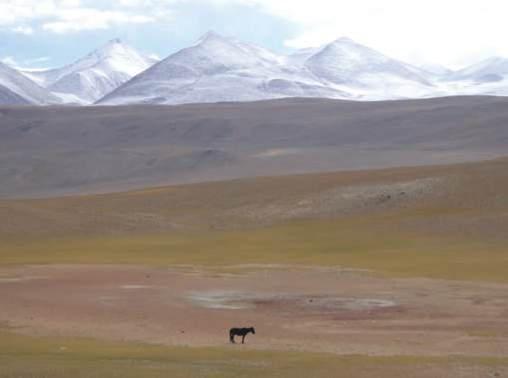
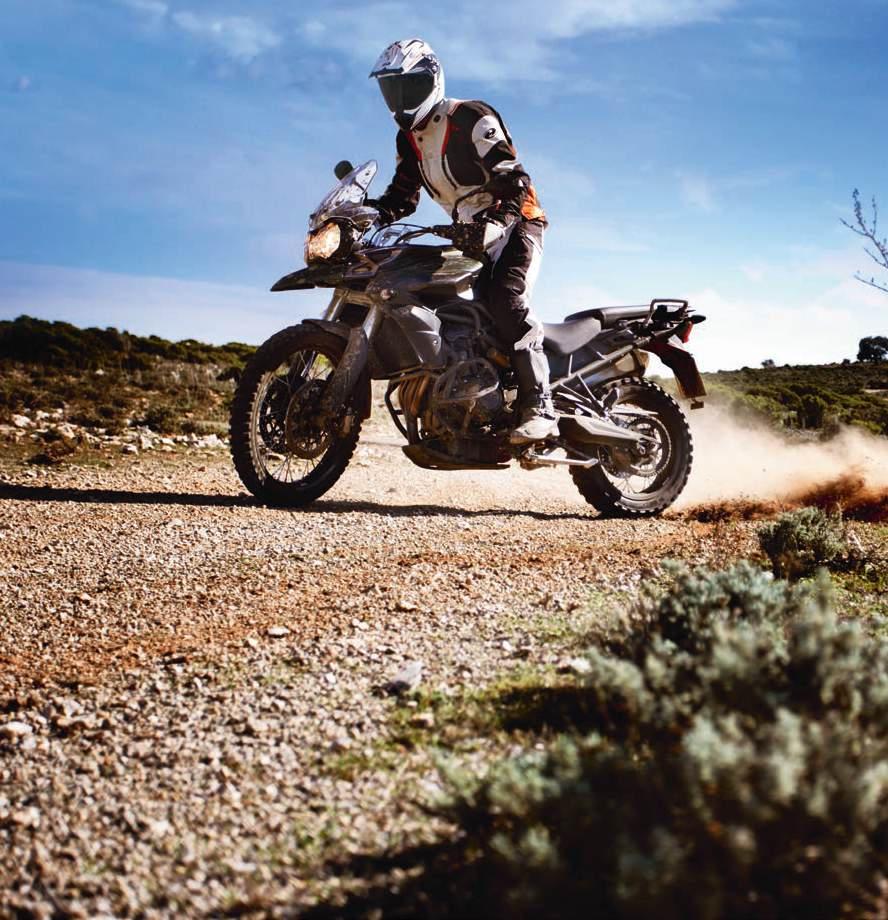



Held is thrilled to be awarded BEST BRAND in the Textile Clothing category for the first time in 2015

















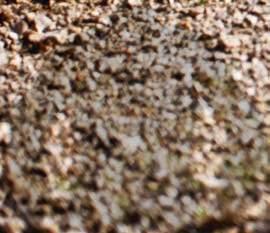




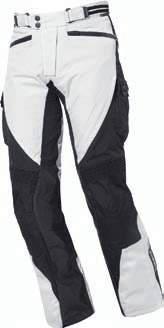



















Email: info@heldaustralia.com.au


Well-spent scent
Later that day we bolstered the local Leh economy by buying silk rugs and pashminas to keep the home fires burning.
The following morning we rode through increasingly barren landscape, yaks, cold, little horses, a few sandy patches and eventually light snow into TsoMoriri –which was freezing. Tits fell off and genitals retreated up into the warmth.
An ill-advised short and freezing stroll from our hotel to the lake, past cows eating cardboard boxes to survive, severed goat and sheep heads that were too cold to smell and a collection of pit toilets –which weren’t – and I was about done with sight-seeing for the day.
No thanks necessary
The next day of 320km from TsoMoriri to Jispa was a bit of a nightmare.
We left TsoMoriri at 7.00am and spent the next 13 hours at an average speed of less than 25kph bouncing our way over some particularly shitty roads all day and into the night, including snow-covered mountains and some passes at higher than 5000m, all the while freezing our tits off in rain and snow.
As we plodded on into the night our two-candlepower headlights only vaguely illuminated the flooded roads and water crossings. Luckily, my visor was completely fogged up and as wet on the inside as the outside, so the poor lighting didn’t make much difference. Despite all that, there were smiles all around when we finally arrived in Jispa. The feeling of the group was mostly surprise that we’d made it.
Despite our hotel beds being only 1.5m long – and all of us taller than 1.5m – we




Main: Kashmir Hills at Sonamarg.
Top left: Kardung Pass at 5,600m (left to right)
- Simon, Steve, Ian, Gopal (guide), Me.
Top right: Punctures were taken care of by the very capable crew.
slept like the dead. My very flash and expensive Klim riding gear had let in as much water and cold as everyone else’s gear.
shut to keep the ‘naughty monkeys’ out. We also got to meet Buddhi, the founder and owner of Motorcycle Expeditions.
The next day’s 150km ride from Jispa to Manali wasn’t a lot better.
Setting out in our sodden gear from the day before, it was still cold and it rained all the way for eight hours (averaging less than 20kph), now with the added joy of crashing thunder as we rode. Of particular interest were muddy, slippery roads with huge dropoffs and of course no safety rail to halt your slide to the Pearly Gates.
But then we had a glorious day off in Manali to sleep, dry out our gear and see the sights, not to mention a great hotel in a pine forest with warnings to keep our windows
Strolling the streets of Manali my brother and I met a snake-charmer who promptly whipped out a cobra and had it swaying to his flute in no time. Next he handed me the basket plus cobra for photos.
A little wee may have come out.
Rested, refreshed and dry, we set out from Manali to Dharamshala.
Bottom left: Finally photographic proof of the Yeti! u
Unsurprisingly, it turned out to be another long, wet day, topped up with two hours riding in the rain and dark, hitting every water-filled pothole along the way, but happily hitting not one cow, dog or person.
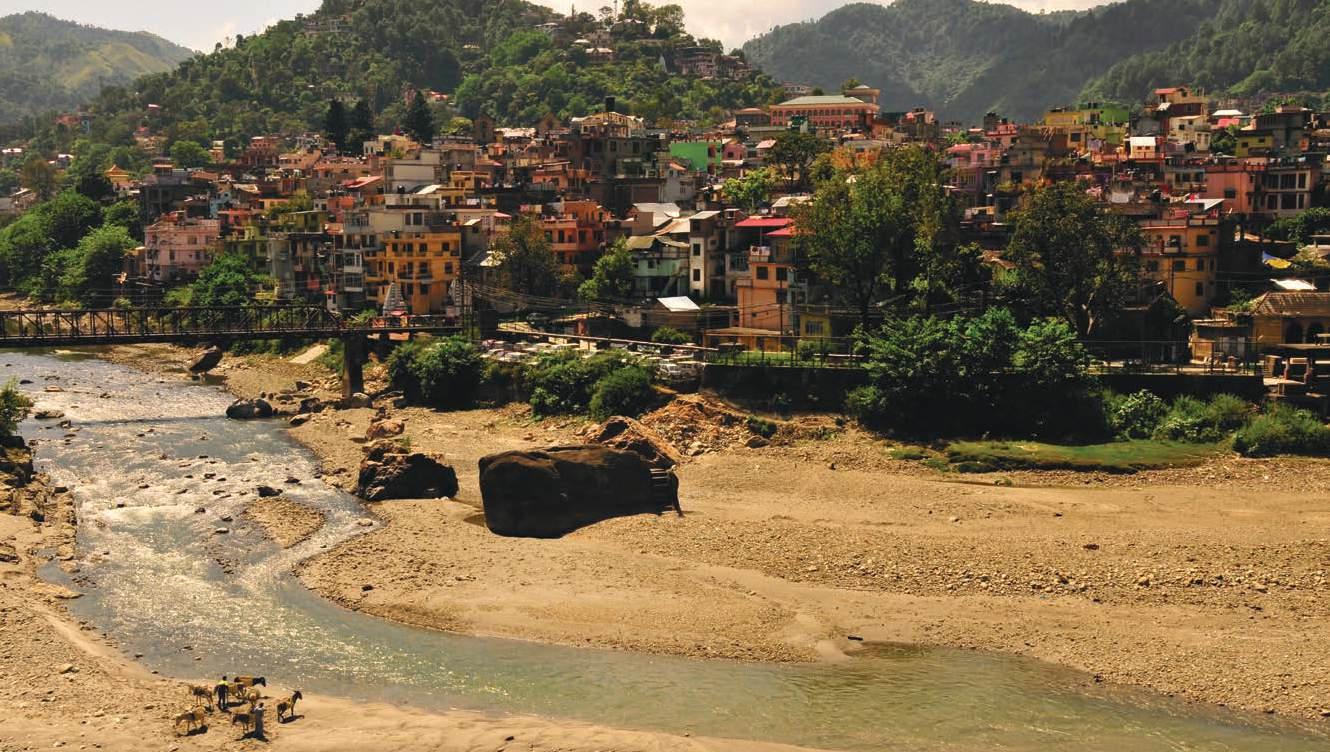
A walk the next day turned up a bunch of the happiest and friendliest people you could ever meet: Buddhists.
Every single one of hundreds of them smiled and said hello as they walked past on their way to their temple. Our hotel was within cooee of the Dalai Lama’s house, but he didn’t invite us over for a beer.
After a day’s rest it was on to Shimla –a hilltop retreat for the British and now for wealthier Indians.
It was raining as we left, but stopped as the day wore on, and wear on it did.
After ordering our lunch, various runners were sent out for the ingredients that were still arriving an hour later. This hold-up meant we arrived on the outskirts of Shimla as night was falling. A huge traffic jam going into the town took forever and then
our guide struggled to find our hotel. For the next hour we followed a very narrow, winding, one-lane road through the backblocks of Shimla. I was absolutely mesmerized by an unbelievable truck driver in front of us flying through these tiny roads, missing obstacles by centimetres and often having only a few centimetres of tyre on the road with the rest of his wheels hanging in thin air. That guy could drive –but Allah/Bhudda/Shiva/God help anyone coming the other way.
We finally arrived. We were warned of more naughty monkeys and the next morning enjoyed great views through the tree tops and fog.
This was the best road bit. Shimla to Rishikesh is 270km and about 100km of that is twisty heaven-on-a-stick.
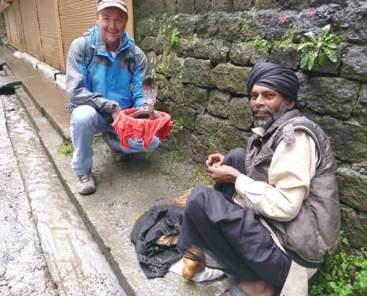
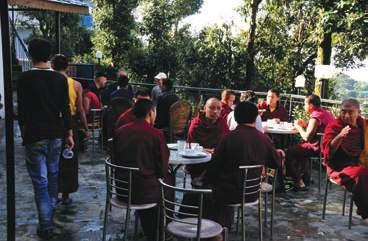
Main: Mandi on the road to Dharamshala.
Top: A snake-charmer in the streets of Manali promptly whipped out a cobra and had it swaying to his flute in no time. Hurry up and take the bloody photo!
On great roads and in a land where police don’t control speed you can go your hardest. The locals certainly gave it their best shot – even three-up. After that, the temperature rose and rose and we hit another massive traffic jam. I roasted in my gear and finally had to remove my helmet to cool off and rode the final 30 minutes into Rishikesh without it. At last I understood why the locals never wear them.
Dawn the next day saw us all in our budgie smugglers in the Ganges, which was chilly but very invigorating! After a day mooching around the town made famous by the Beatles, mixing with the hippies and patting some tiny cows, we went back to the banks of the Ganges for the evening offering of little burning boats and flowers.
The next morning we set off early on the 240km trip to Delhi, riding in fast traffic,
trying to avoid being run over by an endless line of crazy drivers weaving across the road to pass other bikes, cars, trucks, buses, rickshaws and plodding buffaloes pulling huge loads of bricks or sand (nothing ruffles a buffalo). We had to get to the Australian High Commission by 5.00pm to present our cheque to Plan India and do a number of TV and newspaper interviews about the ride and to kick off the relationship between Plan India and the Great Australian Ride. In the end we made it with plenty of time, performed like stars, declined an offer to swim in the High Commission’s pool – We didn’t want to leave a ring around it – and called it a day.
The reporting next day made us sound like absolute plonkers –they picked us in one!
Catch us if you can
Surprisingly, the road from Delhi to Agra and the famous Taj Mahal was a multi-lane freeway and we had it to ourselves – at last!
Like the irresponsible clots we were, we thought it best to flog the bejeesas out of the Enfields and end the argument about how fast they really could go. Through gritted teeth, wild vibrations and streaming eyes, we kicked our bikes into second gear and the race was on. I watched Rosie (I don’t know why called the bike that, it
Above: Breakfast with the monks. u
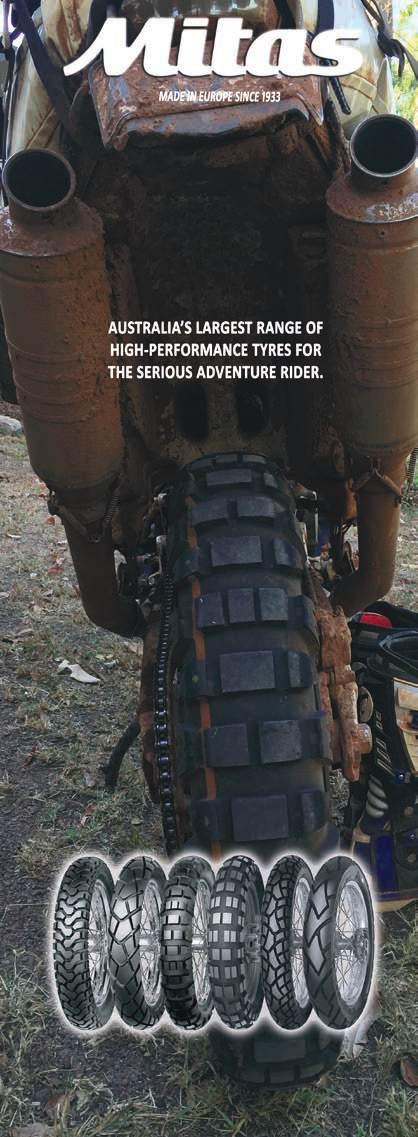
just seemed like a good name for her) headed into uncharted territory – 30kph then 40kph.
It was crazy!
Third gear – 50kph. 60kph.
Fourth gear and, like Burt Munro’s Indian on nitro, Rosie dug deep and we climbed, eyes blurring, wind whistling, a bit more wee and we reached 100kph!
But we weren’t done. As the minutes passed we searched high and low for Rosie’s power band as the speedo inched slowly upwards to finally hit 125kph! Rosie and me were done, but Simon wasn’t to be outdone and claimed 130kph. He has a photo to prove the claim.
If the Indian police would like his contact details, they should give me call.
On reaching Agra, we first visited Agra Fort, which at one time had two encircling walls: one a moat filled with crocodiles and the other one full of hungry tigers. It reportedly kept the Jehova’s Witnesses at bay for over 300 years – but not the Poms.
The walls of the palace inside were studded with diamonds and other jewels, which our guide told us were subsequently stolen by the ‘Britishers’ when they invaded. Then we went on to the Taj Mahal, which was truly spectacular. We, and several thousand Indian tourists, took it in as the sun set on another great day. Brilliant.
The following days to Jhansi, Khajurao and Khana National Park were easy riding on okay roads. Jhansi is named after India’s Joan of Arc who fought the British and died as a teenager, reportedly with a sword in her hand and her baby strapped to her back. Khajurao is famous for spectacular 1000-yearold temples with intricate carvings showing all sorts of erotic positions – including with horses!
The 400km ride to Khana National Park started on some rough roads that claimed Simon with a broken or bruised rib or three. Twelve hours later we rode into the tiger park feeling a bit like Meals On Wheels and prepared for some early-morning wildlife spotting. The park was full of deer, monkeys, peacocks, bloody huge gaur – India’s bison – and tigers. We saw heaps of them on David
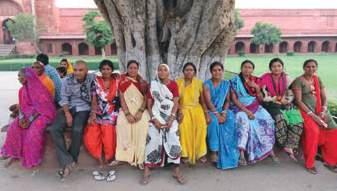
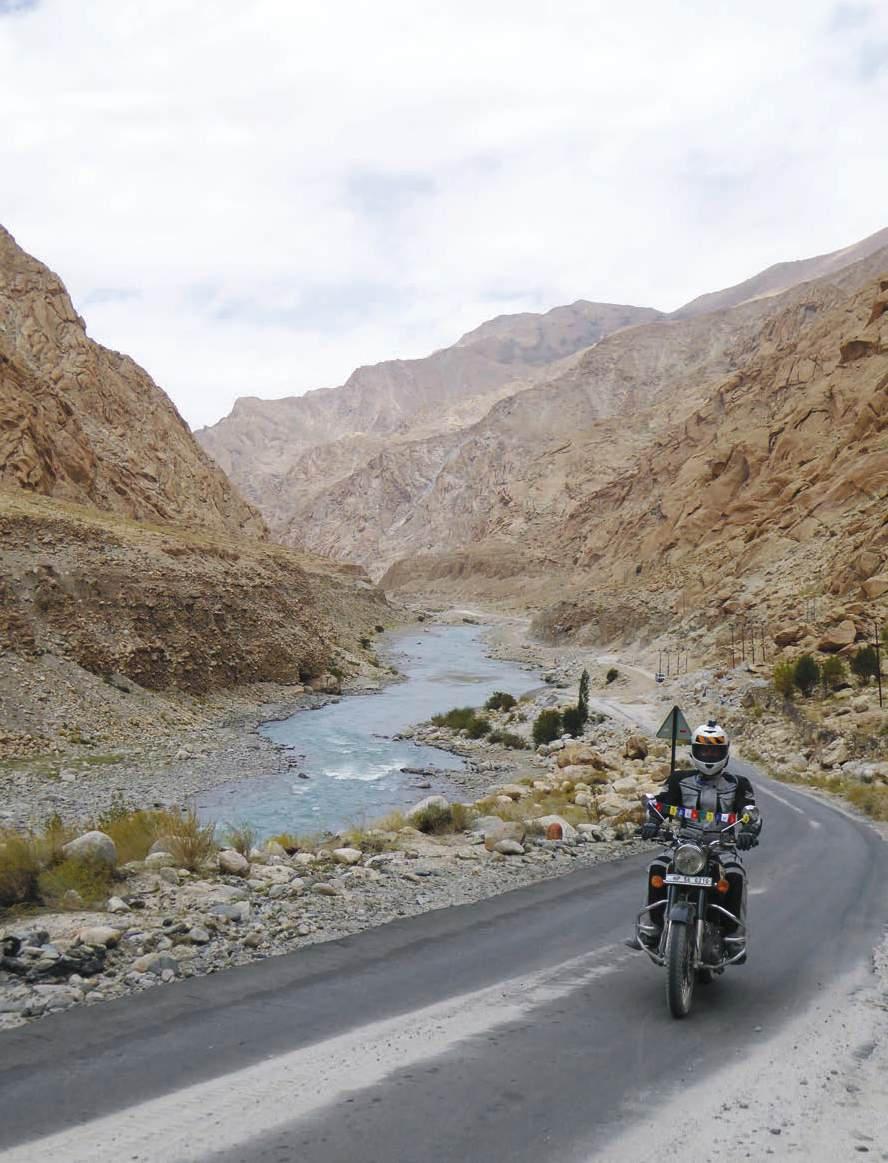
Right: Local Dharamshala girl.
Far right: Ian and a spot of goat-herding. He was pretty baaaaad at it.
Attenborough’s TV shows before we left, but the closest we got in the flesh was a set of still-wet tiger footprints leading out of a puddle. The abundant wildlife in this little protected park, and a huge treefelling exercise along the roadside afterwards, really drove home how much of the natural world we’ve lost through clearing for logging, farming, cities and civilization in general.


‘cut the cake’ – which then felt obliged to do. When in Rome…
After our dawn safari we set off for Nagpur 260km away.
On the way our guide told me of the Indian game of ‘cutting the cake’. The many cows and water buffaloes on the road leave some impressive cow pats. Rather than dodge them as I’d been doing out of respect for Rosie and our mechanic, the more sporting thing to do it seemed was to
The next day was our biggest, covering over 500km to Hyderabad, which we assumed would take us until midnight. But after a pre-dawn start and some initial crap roads, things improved out of sight and we got to Hyderabad by 3.00pm and set about touring the rat’s nest of spice markets, with eyes and noses running from airborne chili powder.
Despite some interesting sights, the
Hyderabaddies weren’t terribly welcoming, so we weren’t sorry to move on to Hampi the following day.
Oy vay! What a day It started to go wrong when I stopped to photograph a roadside cattle market. I was instantly surrounded by a thick and curious crowd, who among other things obscured the cattle market and the road. Realising I couldn’t get a photo, I made my apologies and set off to catch up with the other riders – for 120km. Finally realising

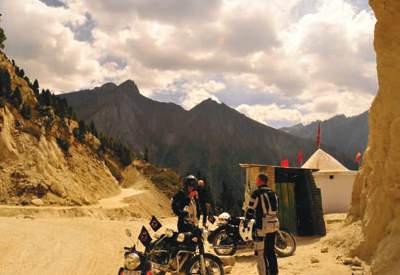
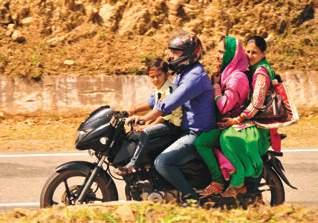
bikes on- and off-road made me realise just how agricultural the Enfields were.
We’d made it all the way from the Himalayas to India’s southern tip.
I was on the right and only road and that they must be behind me I stopped and waited for them. After an hour I started to head back, only to find them stopped a kilometre behind me.
Then our guide, using his phone stickytaped to his petrol tank as a GPS, was looking at it and not at the other bike and two passengers swerving towards him. The resulting stack was impressive, leaving three bodies and two bikes spread across the road. Our guide had dislocated a shoulder and perhaps broken his collarbone. The other helmetless rider had banged his head on the road and ground off part of his haircut. His son on the back was bruised but not obviously broken.
We quickly bundled everyone into the support car and headed for the local hospital where they sat until midnight waiting for a doctor who never appeared –including the other rider who was drifting in and out of consciousness.
There was no doctor, but there was a very keen accident lawyer who did his best to drum up new business. He was promptly told to f#@* off and all parties were satisfied after ME shouted the other rider a new bike and payment of his hospital bill. A doctor was found the following night to fix up our guide.
Stalled
While the guides were trying to sort out that mess and get some medical attention,
our support driver became the guide – and got hopelessly lost trying to find our hotel near Hampi.
To make it interesting it was by then pitch black and pouring rain. Only the lightning helped to illuminate our surroundings and show the likely edges of the now very flooded roads.
Finally we grabbed a three-wheeled taxi to lead us to our hotel, some 30km and 90 minutes away.
We enjoyed another very good night’s sleep. The ruins at our destination, Hampi, were said to be bigger and better than ancient Rome, but we didn’t see any of it.
The 340km Hampi to Bengaluru Road was mostly uninteresting, except when we all veered right onto an overpass into Bengaluru. Simon was out of sight on the wrong side of a bus and veered left and down into what looked like the bowels of the Earth below us. We took a quick look over the side at the dark alleys below, full of shady characters, rats and rabid dogs, decided we really didn’t want to go down there looking for him and headed off to our hotel and pool, reassuring ourselves he’d either find his own way out or would adapt to the situation and have his own roadside stall in no time.
If anyone sees him, please buy something.
The ride from Bengaluru to Ooty was 265km and a lot more interesting. There
were winding roads, lovely valleys, another national park – this time with a family of wild elephants crossing the road – colourful little villages, tea plantations and a great hilltop hotel!
The next day was 350km to Thekkady, but a 60km detour while lost turned into another very long and wet grind and another 8.00pm arrival. We rode through some really beautiful countryside though, so no-one really minded.
Thekkady to Alleppey the next day was a short 150km and saw us arrive by lunchtime and immediately board one of the woven hotel boats famous in this area. A night-time cruise and a few drinks was just perfect.
Finally, on October 12, we set out from Aleppey to head 230km to India’s southernmost point, Kanyakumari.
Along the way we struck another traffic jam, this time for a passing parade involving elephants, drummers and a guy doing a landed-fish impression. He was hanging from a long yellow pole on the back of a truck via hooks through the skin of his back.
We didn’t have a go at that. About halfway through the morning our guide and Simon got a good run through some city traffic while the rest of us didn’t. Ian, Simon and myself separately decided to make our own way to the hotel some 150km away, following the sometimes dodgey directions of locals. As we rode into Kanyakumari we saw the sea for the first time since we started.
Summing up
India is a very big and diverse country, so it’s hard to say anything that’s true across the board. It was freezing in the north and thoroughly cooked us in the south. We rode on some hairy, narrow, dusty, rocky, potholed roads through the Himalayas and on six-lane freeways between Delhi and Agra. While India is mostly Hindu, Kashmir is Muslim and Dharamshala is Buddhist. Christians and Sikhs dominated elsewhere. People everywhere – except in their vehicles – were friendly, helpful and interested in the bikes and us. We saw a handful of foreign bike riders in the Himalayas and literally none for the rest of the trip. We had no problems with theft or other crime and never felt threatened –apart from by other drivers. Apart from a couple of sensitive stomachs for a day, the dreaded Delhi-belly stayed away. Foreign tourists generally were a rarity except for small numbers in a few spots – Manali, Dharamshala, Rishikesh, Agra and Ooty.
All four riders had their share of close shaves, one resulting in Simon damaging a couple of ribs which left him too sore to laugh, cough or break wind – a necessity in curry-rich India – but he somehow managed. Both guides also came unstuck. Riding a bike in India is hazardous, mostly because of other drivers. If you plan to go, and I strongly recommend it, make sure you’re well insured.
The Enfields were a novelty for us, they copped a lot of very rough treatment through some very bad roads, but they got us there. Getting home and riding my own
But you couldn’t ride through India on anything else really, could you?
Motorcycle Expeditions did a terrific job of planning this first Great Indian Ride. It was their first north-to-south tour. The standard of accommodation exceeded our expectations.
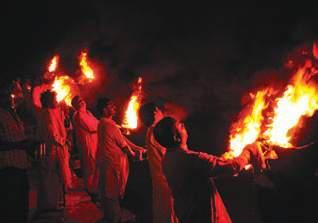
The guides put up with my endless crap and our unfathomable Australian humour – but it amused the buggery out of us – and they got us there every single time, despite the challenges. The support drivers and mechanic also couldn’t have been better, helping in every way possible.
Top: There’s a small vacant space on the petrol tank. Maybe they could fit a goat.
Night
Stuart will be organising the Great Indian Ride for a dozen or so riders this year, possibly with a few route changes and definitely with a few added rest days to make the last half of the trip more
relaxed and fun. The ride is planned for September 15 to October 14, 2016. All enquiries can be made via www.thegreataustralianride.com.
Meanwhile, the little group that did it this year – Steven, Simon, Ian and myself – are thinking there should be a Great Italian Ride in our future.
Bring on the Ducatis!

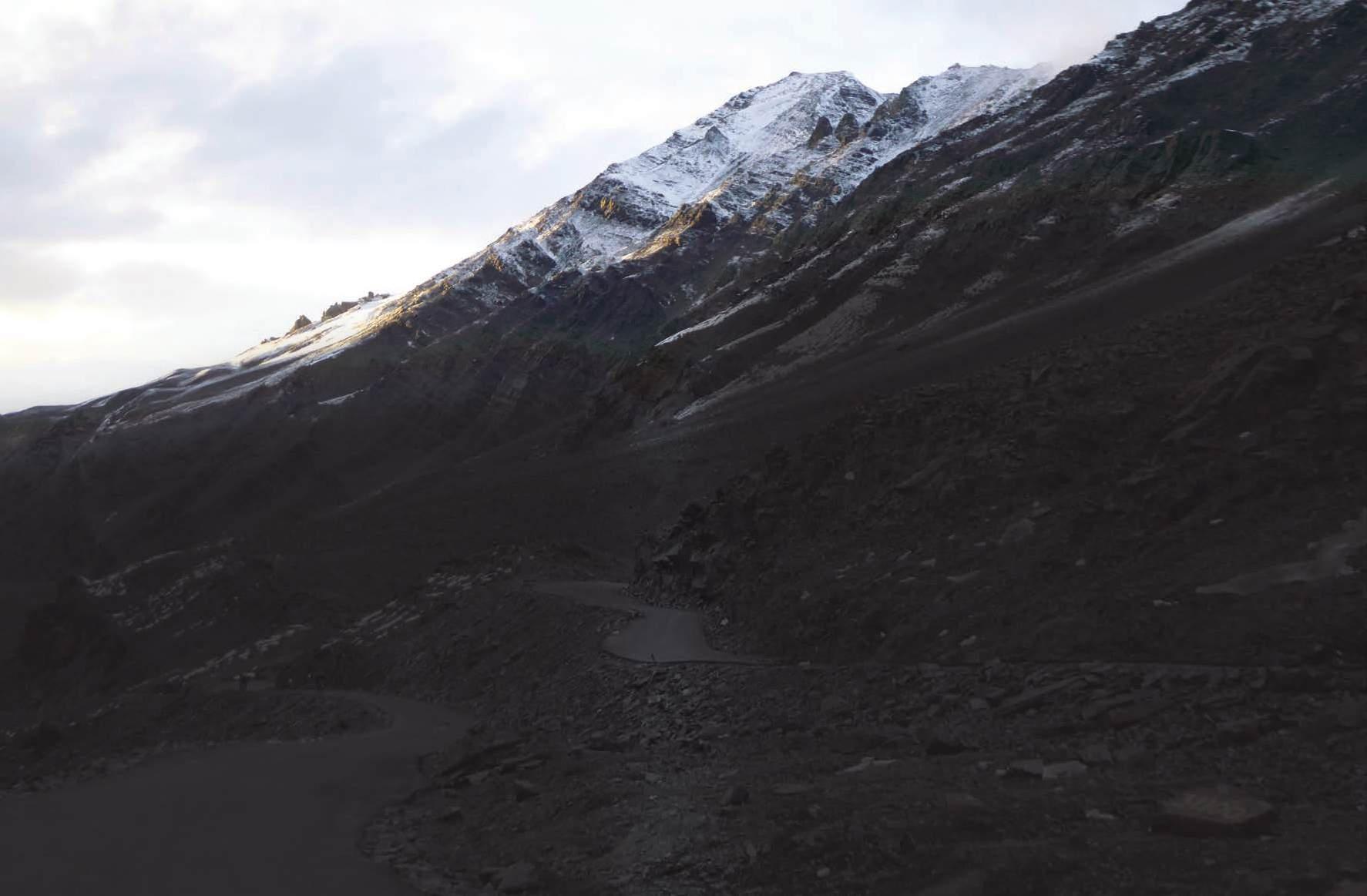
Innovative style and razor-edge performance are standard equipment on every Ducati, and the Multistrada Enduro looks set to offer adventure riders a taste of svelte, stylish, Italian exotica at its off-road best.
We were a little surprised to find Ducati’s new adventure bike at the Moto Expo in Sydney last year. We figured it would be one of those bikes that we’d only see in dreams and as images on websites.
But there it was, gleaming with European sexiness, in pride of place among all the very highest-performance road bikes that the company had on show.
Not only was the Enduro there on display, but Warren Lee, Ducati’s top man in Australia, wandered over for a chat and asked if we’d like a ride when the first shipment arrived.
We were struggling to answer because we were drooling a little, but holy suffering cats! Australia was getting the Enduro! And we were going to be invited to ride it!
We nearly wet ourselves.
Okay. We did wet ourselves a little bit, but we don’t think anyone noticed.
Ducati says it’s entering the adventure motorcycle segment with a motorcycle that combines traditional Ducati values in terms of advanced technology and highperformance, with long-range touring capabilities and true off-road ability.’
That’s an exciting thought in itself. When a marque with Ducati’s heritage and values builds a bike, it’s going to be an eye-popper. The Enduro offers four on-the-fly switchable Riding Modes, Power Modes, semi-active Evo Skyhook Suspension, Cruise Control, Cornering ABS, Vehicle Hold Control for uphill starts, Ducati Traction and Wheelie Control, Ride-by-Wire, Hands-Free Starting, full LED headlight with cornering lights and a Multimedia instrument panel with Bluetooth for integrated ‘infotainment’. Claimed power output is 160hp and dry mass 225kg.

“Ducati motorcycles always have a very high level of innovation and technology,” pointed out the calm and collected Warren Lee, a keen rider himself. “Often people aren’t aware or don’t understand all those features built into our bikes, and what those features can do for them in terms of advantages when compared to other brands and models. So our challenge in a way, especially with the 1200 Enduro, is to effectively communicate these advantages to potential customers so that when they are considering a new bike they better understand our bikes, can appreciate what the content and value proposition is and make a more informed purchase decision. We feel it brings levels of performance, safety and technology not seen before in the adv-touring segment.”
We can see how that would be the case. Still, as best we can interpret the information without riding the Ducati, it puts the Multistrada Enduro right at the top of the premium end of the adventure market, and with an asking price of near-enough $30,000, we were just a little concerned at how far we’d be
allowed to really test the bike.
“We want you to get the bike out there,” said Lee, with no apparent qualms. “Get it dirty. Take it to places where all those bikes go. We’re extremely confident that, under the same conditions with other multi-cylinder adventure bikes, the Enduro will outperform all of them.”
Ducati’s determination to back its bike in real-life adventure-riding scores a huge, “Phwoar!” from us, and we can’t wait for the chance to see how it stacks up.
As we write this the first shipment is just about to hit dealer floors, and we’re about set to explode with anticipation. Next issue we’ll tell you what we learn about the new Ducati after ‘getting it dirty’. While you’re waiting, bolt down to the nearest dealer and have a look for yourself.
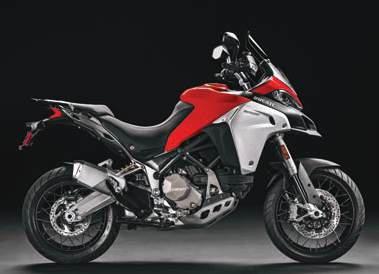
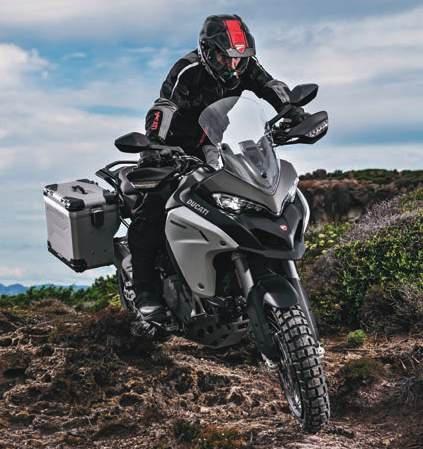
discs, radially mounted monoblocco Brembo four-piston callipers with cornering ABS as standard equipment
Rear Brake: 265mm disc, two-piston floating calliper with cornering ABS as standard equipment
Front Wheel: Tubeless spoked wheel in light alloy, 3 inches x 19 inches
Rear Wheel. Tubeless spoked wheel in light alloy, 4.50 inches x 17 inches
Seat Height: 87mm (890mm – 850mm with optional seats)
Wheelbase: 1594mm
Fuel Capacity: 30 litres
Dry weight: 225kg
Ducati Electronics: Vehicle hold control, Riding Modes, Power Modes, RbW, Ducati Safety Pack (cornering ABS + DTC), Ducati Skyhook Suspension Evo, Ducati Wheelie Control, Cruise control, Hands-Free, Ducati Multimedia System (DMS), TFT colour dashboard, Full Led headlamp with Ducati cornering lights B I ke spe
December 21 is the longest day of the year. Traditionally, on that day, a bunch of weirdos mount up and head into the desert in an attempt to get as far west as they can. In any group of weirdos mounting up, Phil Hodgens is a likely starter.
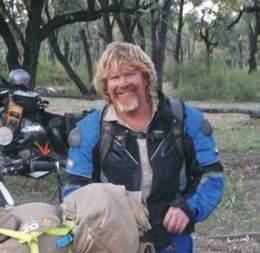
Longest Day has become a regular ride over the last decade. Legends have been made by names like Foster, Everson, Hartley and Crutch who rode a set route from Sawtell on the coast to Cameron Corner, and then some, between sunrise and sunset.
Over the years others have joined in, with names like big Paul Wright thundering over 1700km south from Mount Isa to the Corner, while others have ridden north from Sydney and Melbourne.
But some of the best stories have happened when things go pear-shaped.
As one adventure ends and another one begins...as we found out on the 2015 Longest Day.
The goal
“Ay, Bob. Wanna do Longest Day?” mumbled down the phone to my overworked mate, Bob Condon.
“I dunno,” Bob replied from his plush office in downtown Gympie. “It sounds like long, straight roads to me. Can we do something a bit more fancy? What about ‘Longest Two Days’ and we go somewhere a bit further?”
“Now ya talkin,” I mumbled. “How about two States in two days? We could aim for the WA border down on the Nullarbor.”
It was easily said, but not so easily done.
“We’d need something big and fast, with a massive fuel range,” said Bob “Don’t worry, mate,” replied. “I know just the bikes for the job.”
Motorbikin’ has a long history with Trumpy 800s, and their effortless cruising speeds coupled with a massive 30-litre Safari Tank make them one of the best mile-eating machines on the planet.
Mark Berger from Triumph had a pair of them available, although one bike needed some work as it had been in Foster care...
Tom Foster care that is. Adventure Rider Magazine’s editor had a massive off when he cleaned up a West Aussie ’roo during ADVX and Triumph burnt the midnight oil to get the bike ready on time. It was a rushed affair, but the bikes arrived in Queensland in the nick of time, just two days before departure.
As I cast an eye over my Safaritanked beast I noted the radiator guard was missing.
“Probably should do somethin’ about that,” pondered, then promptly forgot about it.
We decided to leave on December 20, aiming for 1400km to the Queensland Border before dark and the WA border before sunset the next day.
Our Tigers purred to life as the sun burnt the east coast of Australia with its first rays at 4.59am.
“Are you ready to ride, Bob?”
“Ready,” Bob squinted into the sun.
“Well let’s ride!”
Top right: The idea was to get from the east coast to the West Australian border in two days. Although things didn’t go to plan, the guys were home for Christmas. That means they get to try again next year.
Right: Clancy and Sue showed true outback hospitality at Thargomindah. They supplied fuel and refused payment and even offered the riders a beer.
The Tigers carved westward over the Great Dividing Range and two hours and 350km later we were pulling into Moonie for fuel.
“I’m just going to grab a coffee,” said Bob, reaching for his wallet.
“No time for coffee, Bob. We’re on a mission,” I ruled.
Bob’s eyebrows bristled and for a second and I thought he was gunna belt me, but he mounted up and rode on, leaving me with a nasty feeling that one day I was going to pay.
The servo was closed in Bollon so we pushed on for Cunnamulla, squeezing 500km out of the 30-litre tanks in threeand-a-half hours.
Thargomindah was baking in the midday sun when we rolled into town to find yet another servo shut...and this was where things started getting complicated.

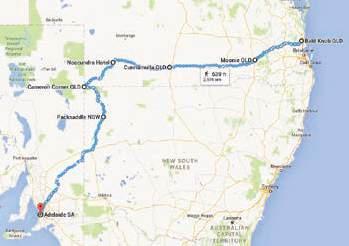
We maybe had enough fuel to make Noccundra, but were reluctant to risk it with the roads deserted in the blastfurnace temperatures.
Things were getting desperate when noticed a bloke down the street mowing his lawn. His name was Clancy, of course, and together with his girlfriend Sue they mustered up a jerry of mower fuel to propel us further west.

“You look like that Ed Sheeran fella,” Clancy drawled in his western Queensland accent.
“You should hear him sing!” chortled Bob, tipping the last of the mower fuel into his Safari-tanked Tiger.
They wouldn’t take any money and Clancy even invited us in for a beer, but the clock was ticking and we’d already burnt an hour of precious daylight in search of fuel. We wished them Merry Christmas and fanged west to refuel at Noccundra just after 2:00pm. We’d lost a lot of time but still had five or six hours of daylight up our sleeves.
We hit the gravel 10km out of town and the Tigers lofted gently off the raised

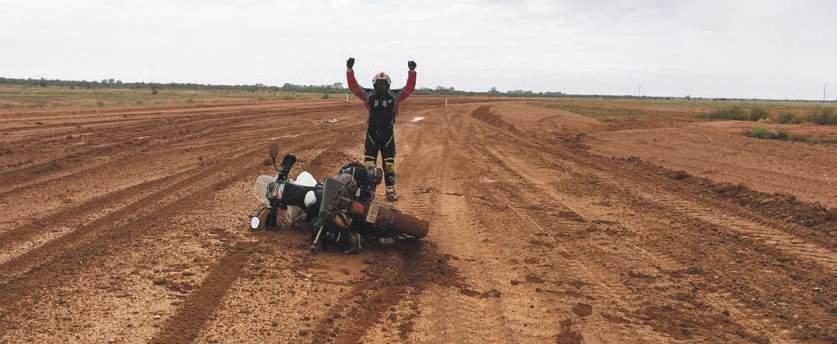
lip of tar and sunk their claws into the red outback dirt. Cameron Corner was in our sights and was casually admiring the massive eruption of roost from Bob’s rear wheel when I heard an ominous ‘thunk’ from the front of my Tiger.
“Wonder what that was?” I pondered, debating whether to pull over and check it when a red warning light started flashing on the dash.
A cricket-ball sized rock had holed the radiator and the last of the precious fluid was disappearing in the dry outback bulldust as I knelt down to examine the damage.
was going nowhere, so I lay down in the scant shade of the Tiger and waited for my mate to come back as the super-heated desert wind whistled through the spokes.
Working on the bike in that heat was way too dangerous, so we towed it back to Noccundra and set to work in the beer garden. The radiator was out in a matter of minutes and Bob filed the fins back from the hole and patched it with metal putty.
We had the radiator back in and full of water in under an hour. While the patch worked, the dash was still showing a warning light.
It was too big a risk to push on.
Our race was run, so we grabbed a couple of Bundys and laughed at the turn of events. Neil the publican gave us a number for the mail truck and a quick phone call scored my Tiger a lift to Adelaide for a few-hundred bucks.
The only problem then was how to get two riders and one bike out of remote western Queensland and home in time for Christmas and there was only one answer to that.
We were on the bike at dawn, abandoning all our gear and taking only the bare essentials: water, tools and tubes. It was a

moment we’d been dreading, and while we’re both married men and comfortable in our sexuality, neither of us were that keen on pressing our bodies together for the next 1400km over outback tracks to Adelaide.
Surprisingly, the Tiger had ample room for two large men to sit without touching and the stepped seat did of fantastic job of keeping Bob’s…err…front away from my… err…back.
The Tiger felt rock steady as we hit the dirt and even skipped from rut to rut over the loose mounds of gravel with barely a quiver.
The real test came around 100km out where the road turned to sand as it climbed over low, vegetated dune country. We’d both been dreading it, and I backed off to 80kph anticipating the worst. The Tiger rolled through like it was on rails.
I cranked her up to 100kph, then 120kph and the Big Cat loved it, roosting sand off the back wheel as the two grown men aboard hooted with laughter. But things were about to get serious.
Pub o’clock
Below:
We rolled into Cameron Corner to news from Fen, the publican, that heavy rain had cut most roads in the area with more downpours predicted. The road to

Tibooburra was open, but dark storm clouds were rolling in across it.
It was our only hope so we fuelled up and doubled on, crossing the border into New South Wales as fat raindrops splattered on our helmet visors. It was a frantic trip to Tibooburra, racing the storm clouds before they trapped us in the outback for Christmas.
We rolled into town about the same time as a lone rider on a black 990. His smashed helmet and mud-stained gear told the tale of a big crash on the road from Bourke.
A mud-splattered ute with a wild-eyed driver pulled in from the road to Packsaddle. The driver sprung from behind the wheel uttering news of a close escape from treacherous mud that bogged massive trucks to their axles. And all the while, big fat raindrops fell on the road around us.
Our door had shut. It was time to head for the pub.
Rain fell steadily overnight, but the road to Packsaddle was open... probably because the local policeman was stranded somewhere and couldn’t close it.
We decided to give it a shot, with our new mate Paul in tow on his 990, and hit the road south with Adelaide in our sights.
Twenty kilometres out we hit evil, red, tractionless slush that built up on the tyres as the Tiger fishtailed from lock to lock before skidding down the road on her side. We slid to a halt coated in red mud and howling with laughter at the absurdity of it all.
Paul on his 990 had also ground to a halt with mud locking the front wheel under the low guard and the spanners came out to remove it.
With traction control on, the Tiger found drive and we abandoned the greasy road and headed cross-country in search of firm ground. It was slow, laborious going, but the Tiger kept her cool and four hours later we’d covered the 80km to Packsaddle.
We’d escaped the mud and morale was high with the knowledge we’d make it home for Christmas.
patted the tank of the mud-caked Tiger and mumbled a quiet thank you to her for delivering us from the red, muddy purgatory and back to civilisation.
It had been a hell of an adventure, but as we doubled into the setting sun we had the niggling feeling of unfinished business.
The Tigers had been hauling some serious arse before we holed the radiator by forgetting to fit the guard. It seemed a crime against the honour of the big 800 Triple, so next year we’ll be back, fingers crossed, to set things right!

Phil’s adventure rides are legendary, and some of his most amazing and entertaining epics are featured on the Motorbikin’ series of DVDs. The discs are available from the Adventure Rider Magazine e-store. Last we looked the series was up to Motorbikin’ 19: Roof Of The World. If you enjoy Phil’s writing, his DVDs will rock your world.
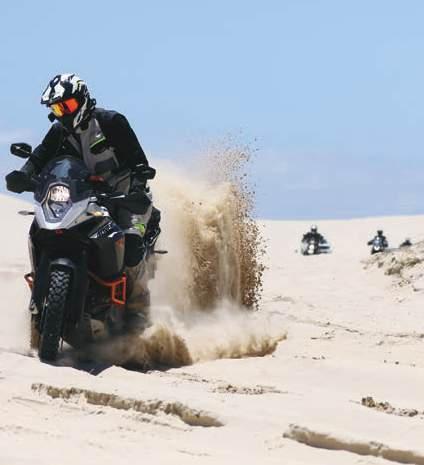
April
2-3 Sand Riding Bootcamp, Echuca VIC 16-17 Sand Riding Bootcamp, Noosa QLD 22-25 TransTerra 4 day VIC
May
14-15 Sand Riding Bootcamp, Stockton NSW
June
12-13 Finke Desert Race, Finke NT 13-25 TransTerra 2016, Alice Springs to Broome via The Kimberley
August
5-8 TransTerra 4 day ride QLD
September 1-14 Italian & Austrian Alps road tour 18-2 Oct Pyrenees, France & Spain road tour
October 14-17 TransTerra 4 day ride, NSW


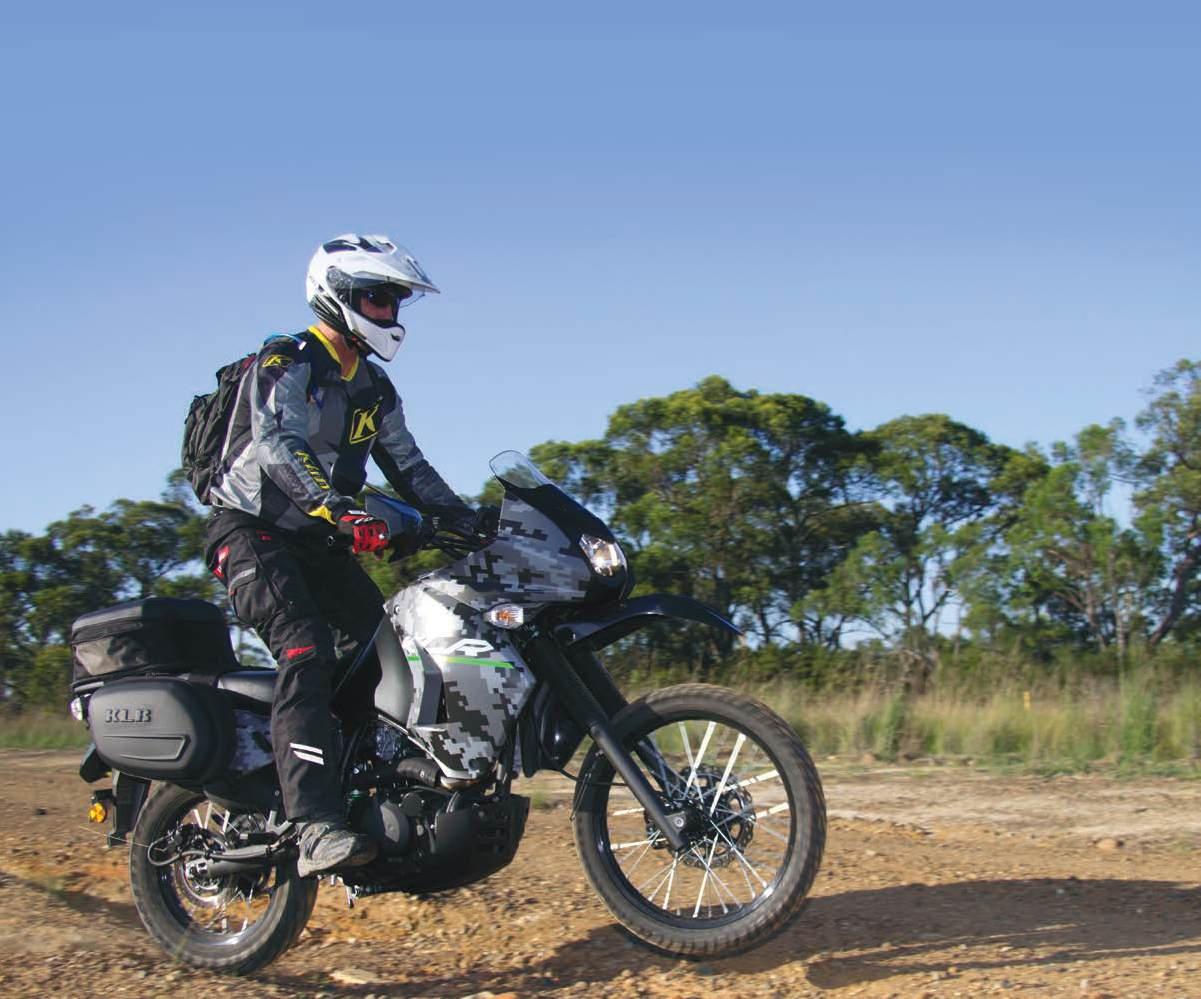
Sometimes a little creature comfort can make a good ride into a great ride.
Kawasaki’s KLR650 takes a sound basic formula: reliability (R) + versatility (V) = fun (F), and adds a high-level of comfort. The new, improved formula becomes R+V=KLR(F).
That’s a little mathematical humour there, and that’s what the KLR does to a rider. It’s so damned fuss-free and easy to ride, the rider spends his time off the bike smiling like a loon and making feeble jokes. He knows he doesn’t have to spend hours each night of the ride doing maintenance or worrying about the weather conditions for the following day. Whatever the terrain and conditions may turn out to be, the KLR is ready for it.
So there’s not a lot to worry about when you’re riding this bike. Just enjoy every minute in the saddle and at the end of the day, sit back and enjoy the other side of riding – bullshitting on with your mates and talking your way through the incredible things you felt and saw.
There’s nothing new to report on the KLR since we last rode it. You can check issue #06, but the same single-cylinder, liquidcooled, 651cc four-stroke single is quietly thrumming away in this 2016 model, a 40mm carby is still controlling the fuel mixture, and the suspension is the updated set-up we tried and enjoyed on the 2014 New Edition. The forks are 41mm conventionals with no adjustment, but feature heavier springs and revised damping over the previous model, and the single shock offers preload and rebound adjustment, and also has a heavier spring and ‘stronger’ rebound damping – that’s The Big K’s description. We interpret it to mean the rebound is slower. That’s what it felt like, and it’s a definite improvement. Clutch actuation is via a cable, so is throttle control and the seat features the new shape and covering we liked so much back then.
Twin-spot callipers handle stopping both front and rear, and the drive train includes a five-speed box, a chain, and a cush-drive hub.
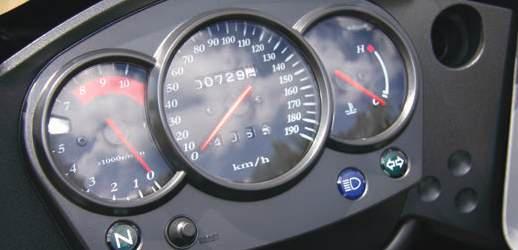
The obvious new feature on our test bike was the colour scheme, and it turned quite a few heads. Looking a little like a pixelated image, the colour scheme is called Matrix Camo Grey and it’s a head-turner. Pretty much every time we parked the bike someone commented on the graphics, and we didn’t hear a single negative. Everyone seemed to like it.
We have to admit it looks a bit lairy, and we’re glad Kwaka is still offering a good ol’ green KLR. It seems more natural to us grey-headed old riders.
Just for the record, the green is called ‘Candy Lime Green Type 3/Ebony’, and it’s pretty damn nice as well.
There’s a huge, old-school pleasure in touching the KLR starter, feeling that motor purr into life, selecting first, and pointing the front wheel at the start of a ride. The sheer rock-solid simplicity of the bike combines with a very polished feel to make the experience about as stress-free as adventure riding can be.
We picked the bike up from Kawasaki, trailered it to the start of an organised ride we’d never done before, rolled it off the trailer and went for it. It was the first time we’d even started the bike, let alone ridden
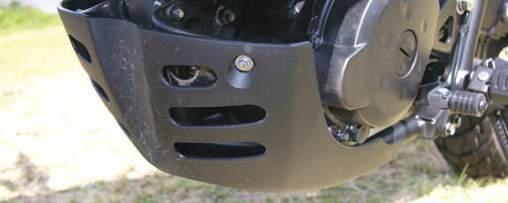
Above:
Below: Those tackling tough terrain may opt for an alloy plate, but this one is pretty bloody tough and offers great protection.
it, but as we joined the 990s, 1200s, 250s, 400s and just about every other bike imaginable, we never for a second doubted the KLR would hold its own. And it did, of course. Starting on the bitumen the bike purred its way out to the first trail section, and on the road the KLR is near faultless, especially when we found we had to cover 300km or so of freeway unexpectedly the second day. The bike is smooth, quiet and so very comfortable. The fairing keeps the rider in a sheltered bubble, and, as unlikely as it seems, the little screen deflects a great deal of wind away from the rider.
So it’s a cruise on the pavement, and long distances vanish in the kind of stress-free riding that allows daydreaming and encourages the humming of Born To Be Wild and flashing scenes from On Any Sunday
Off-road is where adventure bikes are really asked the important questions though, and we found that short of out-and-out enduro terrain, the KLR had the answers.
Our bike was 100 per cent stock. We didn’t set the ride height or even bounce it up and down to see how it felt. We threw a couple of nights’ gear in the panniers and tools and tubes in the top box, jumped on and started riding.
The suspension is good.
It’s not race-ready, and it’s not going to have riders drooling at the thought of passing big bikes around the outside
on the next set of corrugations, but ridden at sensible speeds it’ll steer straight over the rough ground, corner nicely, and cope with occasional unexpected few centimetres of air.
We reckon that’s about what Kawasaki intended the bike to do, and it certainly performs very well in those situations. Our test bike was fitted with a pair of Dunlop TrailMaxes, and as a compromise tyre they’re not bad. But there were times, especially in wet going, when we’d have preferred a tyre with a little more bite. Of course, when we found ourselves on some tight bitumen curves going like a cut cat, we thought the Dunlops rocked.
The tyres were also the limiting factor for the brakes, which we reckon were pretty damn good. The feel and strength are probably way better than the bike needs, and that adds a lot to the enjoyment of pushing on a little sometimes, both onand off road.
Still love it
We loved the KLR when we first rode it in issue #03. We loved it even more when we rode the New Edition in issue #06. We bought one. Is it any surprise that, seeing the bike’s changed very little, we still love it?
All this test proved to us was that what we said about the KLR last time we rode it was totally correct: “The KLR made us feel we’d reconnected with the uncomplicated pleasures of adventure riding again.”
There’s a huge array of accessories available to customise and tune the KLR, and we can’t help but notice that seems to be a common character trait of KLR owners. They do love to bling up their bikes. We even did it ourselves!
Main: The KLR is comfortable on or off road.
Below left: We still can’t cop the footpegs. They’re hopelessly slippery in the wet, and the hero pegs don’t make any sense at all on a bike like this one.
There are some great aftermarket ’pegs available.
Below center: The shock spring is green, and we thought it a little strange at first. Then we got used to it and thought it was awesome.
Below right: A supplied toolkit! Yes!
And it’s a good one. The sneaky little holder built into the rack is a nice touch.

But that’s one of the great attractions. On the review bike we had the Kawasaki ‘soft shell’ saddlebags ($330) and top box ($212.70). At $8099 plus ORCs, most owners are going to have the budget to spend a little on aftermarket accessories, and let’s be honest: who doesn’t love to bling out a bike?
Just as a ‘by the way’, as we were writing this the price on the Matrix Camo Grey graphic has been dropped to be the same as the green. So there’s a great option for the head-turners.
It’s not going to be easy for Kawasaki to improve on the riding experience the KLR offers for its intended dualsport and adventure use, but giving it the sexy Camo skin adds a new dimension to ownership. Now the bike looks horny and interesting as well as being a total pleasure to ride.

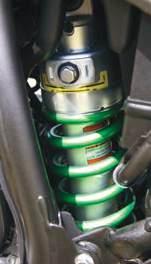



Web: www.kawasaki.com.au. Rec retail $8099 plus ORC
Engine type: Liquid-cooled, single-cylinder, DOHC, four-valve, four-stroke
Displacement: 651cc
Bore/stroke: 100.0mm x 83.0mm
Compression ratio: 9.8:1
Fuel system: CVK40 carburettor
Ignition: CDI
Clutch: Wet, multi-disc, manual
Starter: Electric
Lubrication: Forced lubrication, wet sump
Transmission: Five-speed, return
Final drive: Chain
Frame: Semi-double cradle, high-tensile steel
Front suspension: 41mm telescopic fork
Rear suspension: Bottom-Link Uni-Trak with five-way adjustable preload and stepless rebound clamping adjustment
Brakes front: Single 280mm petal disc with twin-piston calliper
Brakes rear: Single 240mm petal disc with twin-piston calliper
Fuel capacity: 22.0 litres
Length: 2295mm
Width: 960mm
Height: 1350mm
Seat height: 890mm
Wheelbase: 1480mm
Ground clearance: 210mm
Kerb mass: 194kg (including full tank of fuel and all fluids at correct levels)
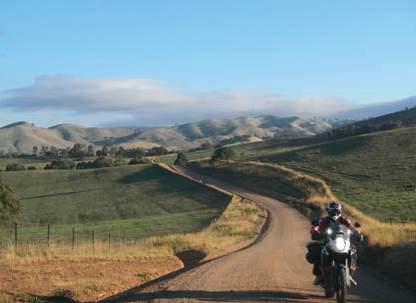
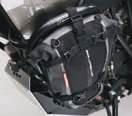

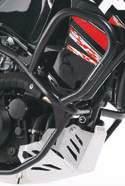
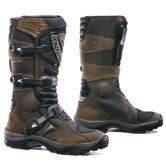
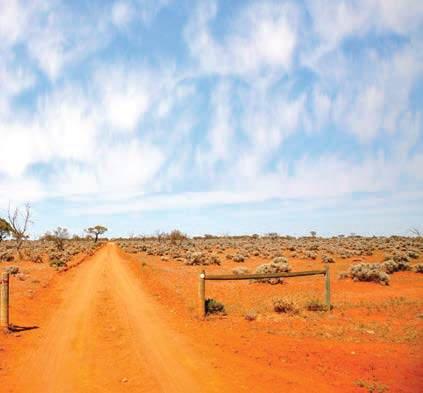


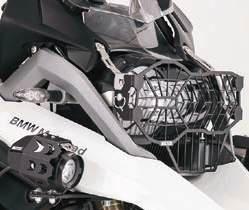
This bike has been around quite a while, and with very good reason. It’s totally reliable, inexpensive and offers what seems impossible versatility. Want a great, smooth commuter with enough stomp to blast past B-doubles on the freeway? Get a DR650. A trailbike with good road capability? DR650. Flat-tracker? Long-distance adventurer? Simpson-crossing bike?
A solid starting point to build the bike of your dreams? The DR650 can be all these things. It’s a diamond in the rough –except the standard bike isn’t all that rough at all. If anything, it’s a smoothie that’s waiting for an owner to buff up the final polish to suit what he’s chasing.
There’s not too many air-cooled motors left in the adventure-bike world, but Suzuki’s DR650 has one, and it makes you wonder why there aren’t more of them. The 644cc single has been running in its current form – give or take some minor changes and updates – since the mid1990s, and in that time it’s proven itself over and over. It just doesn’t have any inherent faults. It’s incredibly smooth, quiet, and easy-to-live with. If it doesn’t have the arse-tearing horsepower of the more modern, high-tech bikes, it still offers plenty of snap when the throttle’s wound open and doesn’t need a degree in electronics to keep it serviceable. Power delivery isn’t intimidating, but there’s no real shortage, either. Thanks to some clever and careful design, there’s hardly any vibration of any kind makes its way to the rider, and the stock exhaust is incredible. The office coffee grinder is louder than the stock DR650. It’s carburetted of course, and if you feel
that might cause you a problem, you’re a mug. The smooth power delivery is as good as any bike we’ve ridden, and making adjustments for different pipes and airbox configurations is within the mechanical scope of most owners with a little patience and some basic tools.
A five-speed box shifts fast and fuss-free, and the cush-drive rear wheel finishes a smooth, trouble-free driveline.
Climbing on board the DR650 will have most riders feeling a little cramped – we Aussies being such big, hairy-knuckled bruisers an’ all.
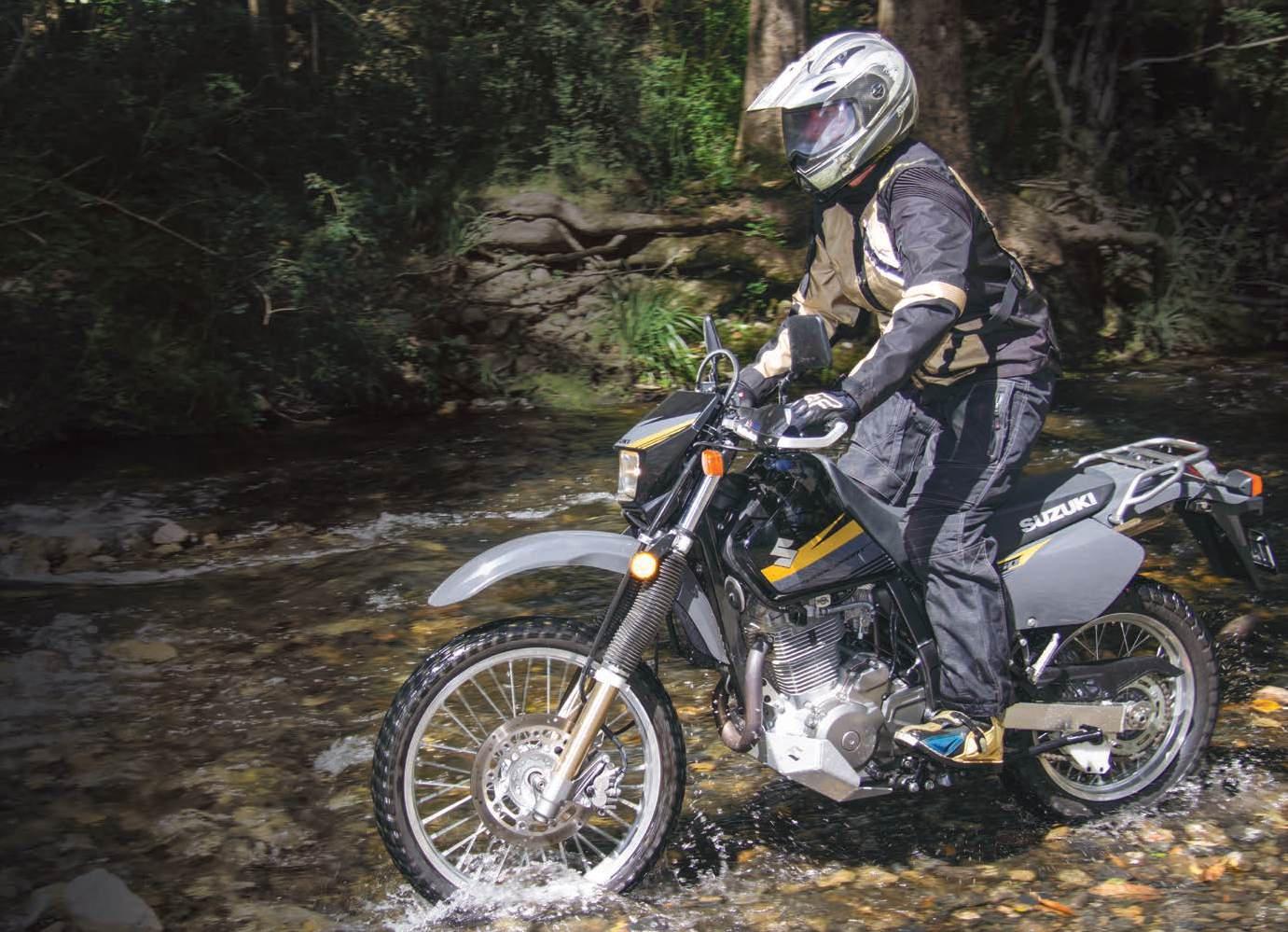

Main: The DR650 is well capable of tackling just about anything as it rolls off the dealer floor. We really liked the Suzuki bashplate and rack and the Barkbusters that had been thoughtfully added to our test bike.
Above: Toolkit supplied! There are bikes twice the price that don’t come standard with a toolkit, let alone one as comprehensive as this one. Airbox access is good, and an oiled-foam filter is standard.
Above right: The standard exhaust is very quiet, but still allows the motor to work well. It’s a stainless-steel system by the way. Try and figure out how Suzuki can fit that in the price.

We’ve ridden so many modified DR650s we’d forgotten just how low the standard ’bars are. Not only are the ’bars low due to a fairly flat bend, but the footpegs are mounted highish. We’re dead-set against lowering footpegs usually, but there’s scope to move the DR650 ’pegs without having them below the frame.
A taller set of ’bars, or perhaps some risers, will have riders of average height – say, around the 175cm mark – instantly more comfortable and confident on the DR. It’ll also make standing up to ride a viable proposition. The stock set-up makes standing up difficult because the ’bars make the rider bend over way too far forward. Lowering the ’pegs just a smidge also allows the rider to start taking aggressive charge of the bike, and when that happens, the DR650 offers eyebrow-raising performance. It’s not that the DR650 will leave litre-class bikes in its wake in a standing-start drag, but it’s surprisingly nimble once the rider has some room to move. The extremely manageable motor teams up with good handling manners and a very compact feel to offer a sharpish package that, when the going gets tight, will leave a lot of far more expensive and more powerful bikes wondering where the DR650 went.
The biggest surprise from the DR650 was just how much fun it was. Simple as that. This bike rages along, gobbling up freeways, crossing rivers, conquering hills and coping with really challenging conditions of all kinds and seems to love doing it. The suspension actually works okay at sensible speeds, braking is good, handling is better than average and, most of all, it’s as reliable as a hammer. If you want to ride it up and down the Hume Highway for a week or thrash it across The Simpson and back for a month, it’ll do it, and short of blunt-force trauma from an oncoming semi or the rear tyre being chewed off by a deranged camel, it’ll give no trouble and it’ll never quit. When we first fired up the bike and hit the dirt we were struck by how short and
compact it felt. Thinking about it, that’s probably because we spend so much time on luxury, hightech, big-horsepower bikes. The more we rode, the more we realised just how much we were enjoying ourselves. We tried to keep ‘intended purpose’ in mind, but the DR650 just conquered everything we aimed it at. The more it did that, the more we asked of it. The more we asked, the more it delivered. It never let us down.
It’s not going to be easy to understand, but the DR650 is an ideal bike for both newbies and seasoned, hard-core adventurers.
The newbies will find themselves on a capable bike that can do just about anything and will forgive them a huge range of mistakes and lack of maintenance. So that’s a good thing.
The seasoned rider who knows what he wants will tune and build any bike, no matter how much he pays for it, to suit what he wants. With the DR650 he’ll find a bike with incredible reliability and good handling manners crying out to be personalised. A phone call to Vince Strang Motorcycles and he’ll be able to buy just about every conceivable aftermarket accessory he could ever want, along with tech advice to shape the bike into just about any format from super motard through to quarter-miler. Australian Safari Tanks has a couple of great options for the hard-core distance guys, and Nick Dole at Teknik has a suspension package that’ll have the bike ready for anything anyone can throw at it.
Speaking of accessories, we were very impressed with the Suzuki bashplate. It was as solid as a rock and hardly resonated at all. Barkbusters are a sensible addition to any bike and felt great on the Suzuki, and the rack was a ball-tearer. As this bike arrived at Adventure Rider Magazine, it was a really excellent set-up for someone having their first look at adventure riding.
Our photo rider for this test showed up on his own modified DR650, and we reckon his thoughts sum up the DR650 better than any other we’ve heard.
“It’s a bike that may not be exceptional in one area, but it’s good in every area,” he offered. Amen to that, we say.
All that in a bike that retails for just $8,990 ride away.
Hallelujah. We’re believers.
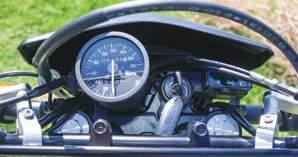



Web: www.suzukimotorcycles.com.au. Locate stock at www.suzukimotorcycles.com.au/range/off-road/ trail-enduro/dr650se/availability
Engine: Single-cylinder, OHC, four-stroke, air-cooled with SACS
Capacity: 644cc
Bore and stroke: 100mm x 82mm
Compression ratio: 9.5:1
Fuel system: MIKUNI BST40, single carburetor
Transmission: Five-speed
Front suspension: Telescopic, coil-spring, oil-damped
Rear suspension: Link-type coil spring, oil-damped, springpreload/compression
Front brakes: Twin-piston caliper, 290mm floating disc
Rear brakes: Single-piston caliper, 240mm disc
Start: Electric
Seat Height: 855mm
Length: 2255mm
Width: 865mm
Height: 1195mm
Wheelbase: 1490mm
Ground clearance: 250mm
Fuel capacity: 13-litres
Wet weight: 166kg




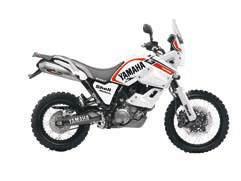




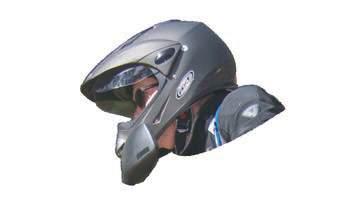
Abrief history recap: The SWM RS 650 R is basically the 2011 Husqvarna TE630. Husqvarna engineer Ampelio Macchi put together the backing needed to take over the Husqvarna factory in Lombardia, Italy. Macchi was instrumental in the design of the TE and under the revitalised brand SWM is prepared to back himself and the bike in today’s fast-growing adventure market.
After a bit of thrash around, a few coffees and a run along the bitumen, we’re backing this bike as well.
If you’re looking for a light, fast-handling bike that’ll do comfortable road miles as well as carve up on trails, look no further. The SWM is calling out to you.
The single-cylinder, 600cc, liquid-cooled four-stroke motor is fuel-injected, but that’s pretty much where the electronics stop. There’s no ABS, no traction control and no switchable fuel maps. The digital gauges are about as technical as the electronics get. The throttle body is connected to the rider’s right hand via a cable, and rain, hail or shine, the power characteristics and delivery stay the same.
Marzocchi USD forks and a 21-inch front wheel do the bizzo at the front with an 18-inch wheel and Sachs shock at the rear. Brembos handle the stopping both ends and the six-speed box drives a chain which runs through a guide that’ll have greyhaired old enduro riders misty-eyed with nostalgia. In an interesting design feature, the rear hub isn’t cush-drive. The clutch itself has a cush-drive set-up.
Despite the bike being supposedly ‘a 2011 model’, it won’t look dated or out of place on showroom floors – or as part of an adventure-riding pack, come to that.
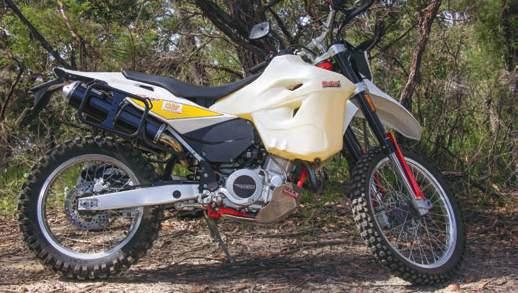
The initial impression of the SWM is ‘dirt bike!’
The 900mm seat height, the firm, shaped seat and the flare of the radiator shrouds straight away evoke feelings of the enduro and trail bikes of years past. There’s no beak or screen and the switchblocks are uncomplicated and straightforward. The markings on the fork tops remind the rider forks have rebound adjustment and if it needs to be changed it takes a screwdriver. The shock is fully adjustable, and if a rider wants to get his screwdriver in to the clickers he’s going to have to hunker down!
Being a single, the SWM feels fairly slim and the ’bars are possibly a little narrower than an out-and-out dirt bike, but the refinement of the European fittings is very nice, and the width of the ’bars is pretty good for the bike’s intended dualsport use, we reckon. Everyone will have their own ideas on what they consider comfortable or appropriate, but that’s what we thought.
Snicking the bike into gear and easing out
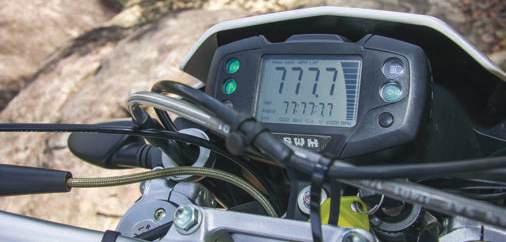
Left: Plenty of polish, but still old school enough to set hearts thumpin’.
Above: The Mojo Motorcycles (importer of SWM) development bike is a step up again. There’s an extra four horsepower and two kilos less weight thanks to the Barrett pipes, pannier racks, a Safari Tank and an accessory seat. The work is ongoing, and everything seen in this pic is available over the counter. Below: The digital instrument has a surprising array of alternative displays and was easy to use.
into the western-Sydney traffic yielded a few nice surprises.
The SWM is very, very comfortable on the road. The dual exhaust is far from loud, but it chuckles along with an understated snarl that makes a rider feel good. We also remember the Husky TE630 as having a unique feel in corners, but that wasn’t apparent on our test bike at all. Compared to the original Husky, the SWM has 27mm less travel in the forks and 14mm less in the shock. SWM says this is to achieve a more ‘adventure-bike’ feel and less motocross- or enduro-type behaviour, so that’s bound to have made a significant change from the bike we remember. Whatever. The bike handled traffic and open-road running with no fuss or bother.
We were actually surprised at how little buffeting there was for our 175cm rider at freeway speeds. We thought that without a screen we’d be in for a pummelling, but it wasn’t so. We can only think the headlight surround was deflecting a fair amount of the windblast around or over the rider’s helmet. The ride wasn’t as smooth as a well-screened bike, for sure, but we were surprised at how smooth it was.
Where we really fell in love with the SWM was on the dirt.
The motor delivers a very predictable drive at its strongest in the middle of the rev range, and thanks to the suspension doing its job really, really well and the brakes being even better than the suspension, carving along a bush road filled our hearts with all the fun and fantasy we used to enjoy so much on trail bikes when we were younger. The ‘feedback’ from the SWM to the rider is really excellent. The rider gets plenty of indication of the rear letting go or the front ploughing or locking or whether or not the bike’s going to loft its front wheel and fire a wall of roost from the rear at the same time. That just makes a rider do all those things, all the time. It was glorious.
Braking is really first class with great feel and good stopping power, and although we did manage to bottom the forks once, it took a lot of hard work to make it happen. We didn’t get the rear to bottom at all, but after the excitement of the front-bottoming exercise we got a bit coy and calmed down a little.
The suspension works on the SWM. It works the way good suspension should, allowing the bike to be pushed fairly hard and still leave the rider in control. That’s almost another old school thought these days when we see so many riders tuning suspension for comfort. For the older generation, good suspension meant good control, and we were transported back to younger, faster days when the SWM offered plush, firm response from both front and rear that begged us to work the bike harder.
Another advantage of the SWM’s history is that there are good adventure accessories available already. There are a couple of good bashplates, Safari Tanks has a fuel cell available, and Jason Barrett has both pipes and pannier racks.
The SWM gets a big thumbs up from us. It won’t be for everyone, because there are plenty of adventure riders who’ll never want to tackle a tough bush track and who love the technology and comfort that’s available on modern bikes. But for those out there who come from a dirt-bike background and who love the blur of the bush passing at speed or the challenge of some tough terrain, the SWM is gold.
Main: Riders with an off-road background and a love of pushing hard on a bush track will fall for the SWM.
It’s comfortable and well-behaved on the road too, and we reckon longdistance would be no problem.
Below left: Adjustable suspension front and rear. It takes a screwdriver, though. There’s no sitting there and pushing a button.
Below right: Brembo make great brakes, but the units on the SWM are especially good. Great feel and good strength.

We also felt – and we mean this as a huge compliment – the SWM is a true, refined, capable trailbike. In saying that we’re harking back to the days when a trailbike was the bike you rode to work on every day – because your wife had the car for the kids – then would do duty as the smile-inducing recreation machine on the weekends, and then, once a year or so, head to Cape York or Fraser Island with mates for a cut-loose, ride-the-edge annual holiday.
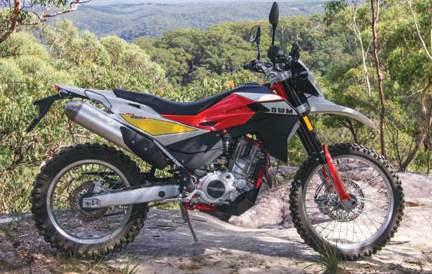
That’s what we reckon the SWM is about. And all at the totally unbelievable price of $8,999 plus ORC.
We had to check that twice, and it’s true. Check it out for yourself. You won’t be sorry.
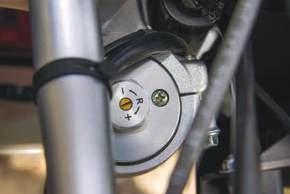

There are some good accessories available already. Our test bike had a Force Accessories bashplate, but there’s a typically gorgeous B&B plate available as well.
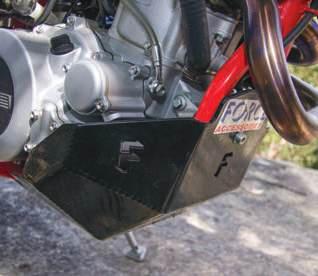
Web: www.swmmotorcycles.com.au
Engine: Liquid-cooled, DOHC, four-valve, single-cylinder four-stroke
Capacity: 600cc
Bore x Stroke: 100mm x 76.4mm
Transmission: Six-speed
Clutch: Wet, multi-plate with hydraulic control
Ignition: GET Athena
Fuel system: Mikuni EFI
Start: Electric
Front suspension: 45mm Marzocchi fork with 210mm of travel
Rear suspension: Sachs shock with 270mm of travel
Wheels: 18/21-inch front and rear
Seat Height: 900mm
Wheelbase: 1505mm
Ground clearance: 250mm
Fuel capacity: 12-litres
Weight: 144kg

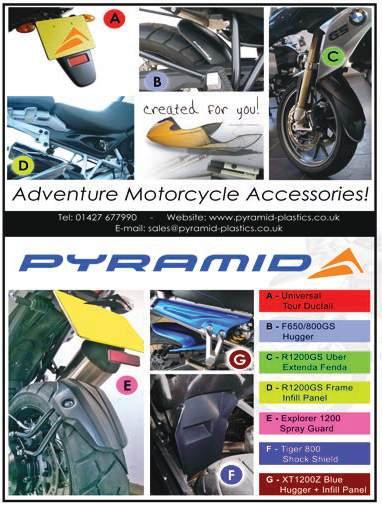
Very few will face the starter and race Dakar and even fewer will complete the race. Dale Margetts did the next best thing. He hired a bike and followed the event as a spectator.

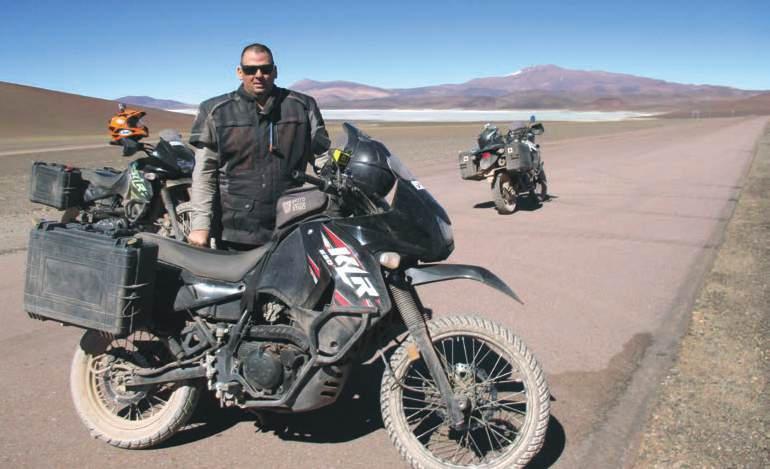
Ibooked a tour just after the 2013 Dakar. watched Dakar 2014 and couldn’t wait for my chance to see Dakar 2015 and follow it on a bike. My wife and boys were glad to see me go as I drive them mad at Dakar time.
On Christmas eve 2014 I received an email to say the bike-hire company in Buenos Aires had done a runner. They’d sold the bikes, grabbed the deposit money and disappeared. It was a separate outfit to the tour company I’d booked with, and full credit to that tour company for organising
Left: Toby Price seemed surprised to hear an Aussie voice at the end of the ninth stage in Chile.
Top: Author Dale with his hired KLR on top of the Andes.
Below: High in the Andes at the Chile/ Argentina checkpoint.
KLR650s from a hire company in Santiago, Chile, so my ride could still go ahead.
But the race started in Buenos Aires, so after flying in for new year’s eve, we spent a day at the Telopolis Exhibition Centre watching scrutineering. It was amazing. Even just the number of Dakar organisation vehicles was staggering.
During scrutineering I met a Swiss bloke working on a Husaberg 450, getting it ready for the rally. It was his first time in the rally doing it Malle Moto – probably the toughest way of tackling the world’s toughest off-road motorcycle race. The Malle Moto class is for privateers who pay their own way and basically receive no help. Their fuel and basic gear is transported for them and that’s the sum total of their
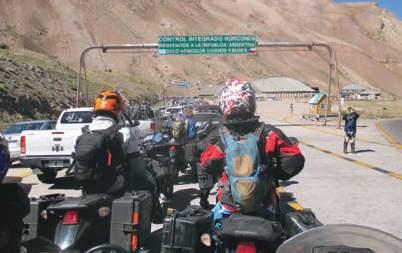

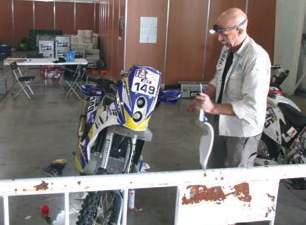

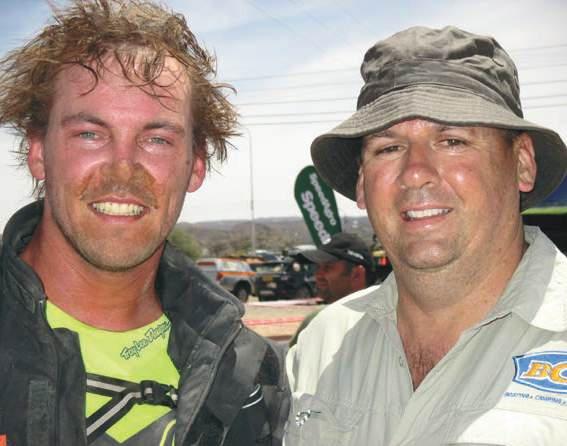
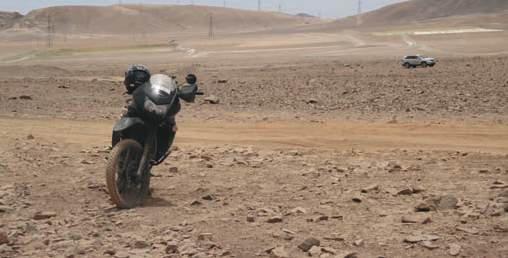
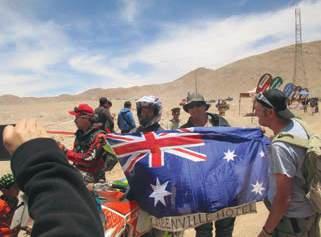
riding as well, and this was going to be the
That same day I met the boss of
We missed the start of the race as we had to fly to Santiago to pick up our bikes, then ride to catch up to the rally. That meant crossing the Andes and the ChileArgentina checkpoint.
After two days we caught up with the event at the end of the second stage and it was the first time I met Toby Price. He pulled up and took off his helmet and you could tell it was damn hot out there. I yelled out
Top left: Price is always happy to chat to supporters, no matter how big the occasion.
Left: Dale’s KLR coped with everything, including the high altitude of the Andes.
Below: Watching the racing.
Above: Author Dale and his mate Steve were rewarded with Toby Price signing their Aussie flag and helmet.
Top right: The bike was from the 2014 Dakar. The rider had been helicoptered out and the bike had been left behind, finally to be recovered 12 months later.
Right: Tyre repair.
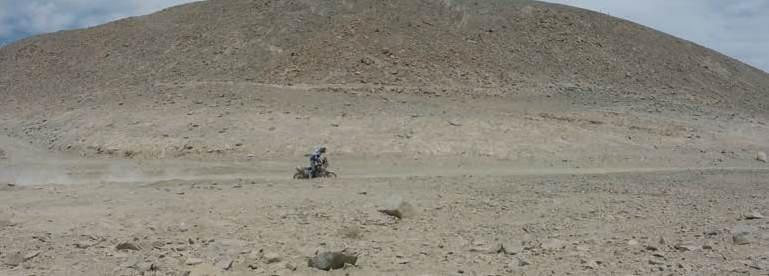
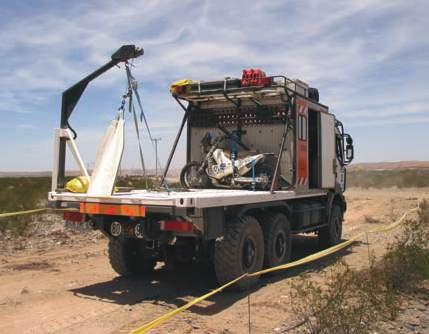
his name and he seemed surprised to hear an Aussie voice. He got off his bike, came over for a chat and seemed over the moon to see us there. This wouldn’t be the last time we’d catch up.
While we were watching the riders come in we noticed a sweep truck parked up with a bike on the back. A chat with the driver revealed the bike was from the 2014 Dakar. The rider had been helicoptered out and the bike had been left behind, finally to be recovered 12 months later.
Unfortunately a rider passed away on the second stage of the 2015 Dakar.
We went to fuel up, only to find I had a flat front tyre. In my excitement at hearing the bikes for the first time I’d made a rookie mistake and ridden directly through the desert scrub to get a vantage point. I didn’t realise the scrub was full of big thorns. There was a local behind the refuel who had the most basic of workshops for fixing flats, but he knew it was a winner. With a nod to each other and a look at the tyre the local man set to work. What a gem he was.

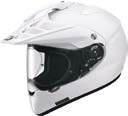
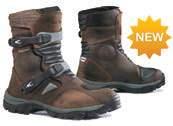





We headed back over the Andes at one of the most basic border crossings from Argentina to Chile and the landscape was so
u






bare and beautiful it’s hard to describe. We followed the rally to Copiapo, Antofagasta and Iquique, catching up with our hero Toby Price, who really seemed happy to have some Aussie support there. Unfortunately we didn’t get to go into Bolivia. That would’ve been exciting on its own. With the bike-hire laws we couldn’t ship the bikes back to Santiago from
Buenos Aires, so this was the end of us chasing Dakar. Or was it?
We had to ride our bikes back to Santiago, a 1760km mission. The coastline of Chile is spectacular as the desert, sea and mountains all come together and it’s
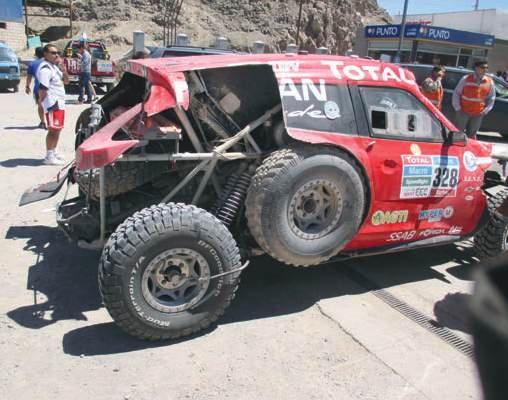
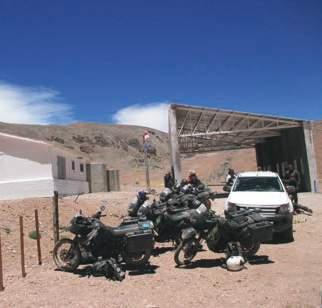
something could never have imagined. One of the best things about the rally was that all rally vehicles have to fuel up in the local communities to give something back, so all service stations are a hive of activity and a great place to see all the race vehicles. To ride on the road right beside Dakar competitors in their liaison stage is a big buzz. The competitors seemed to love it as well, because they’re on cloud nine competing.
Another bloke on the ride, Steve, and myself would sit down at night where there was some free wi-fi and check all that day’s stage results, of course keeping a close eye on Toby Price. As it neared the pointy end of the race we logged on as early as we could, only to see Price had had won stage 12 and looked likely to make it on to the podium! And here we were in Chile, on the wrong side of South America.
Our return of bikes and flight back to Buenos Aires was booked for the day after the podium, which meant we’d be 1500km away in Santiago. We decided we had to do something about it.
The fun began.
We’d just ridden more than 500km to our accommodation, leaving approximately 270km to get back to Santiago. It was about 4.40pm and I said to Steve, “Stuff this. We
Above left: These guys were looking for guidance. They’d wandered off the course and were having trouble finding their way back.
Left: Refuel at service station.
Above: Check point Argentina to Chile.
Top right: Chicken Man helped navigate through Santiago.
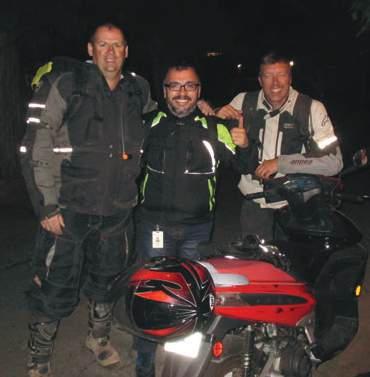
may have Toby Price on the podium and here we are in Chile. I want to be in Buenos Aires.”
We started to look for earlier flights from Santiago to Buenos Aires. Bingo. We found one leaving at 9.00am the next day, arriving in Buenos Aires at around 11.00am. The podium was due at around 2.35pm, so it looked good.
contacted the bike-hire place to see if we could drop the bikes off that night at around 10.30pm and they said, “Sure.”
We pushed our luck and begged for one other favor. “Can we sleep in your office?”
“No problems,” came the reply, “and we can organise a taxi to the airport for you.”
How good was that!
Next we had to tell the tour guide we weren’t staying, but were riding on to Santiago. This went down okay. His only concern was for us to be extra careful. The tour guide also booked our hotel in Buenos Aires a day earlier than scheduled.
Pronto!
As we’d had a support vehicle for our luggage we had to fit all our gear on our bikes. We also had an address for the bike-hire company but no GPS, so our plan was to ride into Santiago (population 5.1 million), pull up and use free wi-fi to get directions.
After a number of tolls and some heavy traffic we stopped somewhere in the capital at around 9.30pm. Across the intersection was a chicken shop, and I noticed a little bloke coming out and heading toward a scooter. I quickly got off my bike and went over to him asking, “Do you speak English? Can you help us?”
To our relief he could speak a little English so I showed him the bike-hire address.
“Can you tell us where it is?” I asked hopefully. “Better than that, if I pay, can you take us there?”
After a phone call to his wife – I think she said, “Do what you want,” – around 35 mins and one more stop for Chicken Man (I found out he was a computer programmer) to get more directions, he had us at the hire place. What a feeling! One part of our challenge in getting to the podium was over. I was very happy to pay Chicken Man quite a lot of Chilean pesos.
u



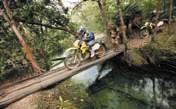









It was well worth it.
The bike-hire company was great.
We did our return paperwork, had a drink and somehow got our bike gear to fit in our bags. Sure enough, the bike-hire company had booked our taxi for 6.00am and a roll-out mattress and couch were our beds. Our flights went to plan, and we felt like cats on a hot tin roof trying to get off the plane
Above: The podium. It took huge commitment from the author, and his mate Steve, to get there.
Left: Sonik winner of the quads.
Below: Toby at the podium
Top right: Last bike to finish: 76 place
Right: No way! It’s Simon and Llewelyn Pavey! They’d just become the first father-and-son team to complete Dakar.
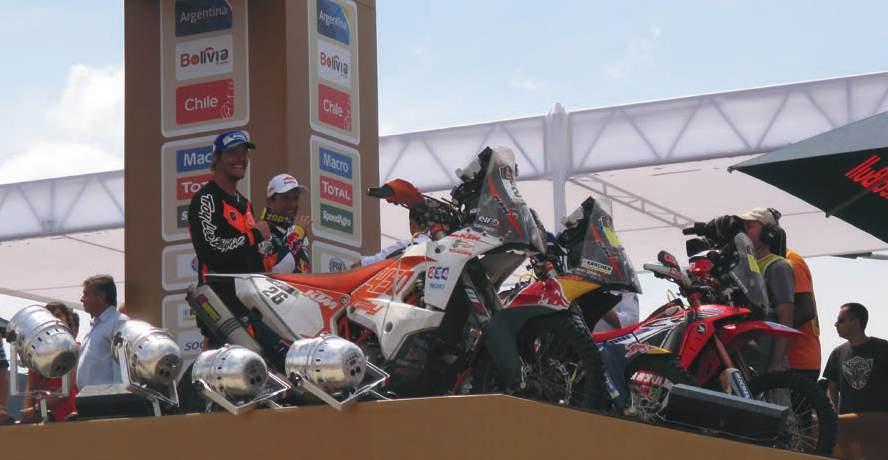
and collect our gear. My bag was the last on the luggage carousel and by then it was about 11.30am.
Time to get a taxi!
We got a gem. We let him know we had to get to the Dakar podium, but first to our hotel to drop off our bike gear and luggage. Steve and I said kindly to the taxi driver, “Pronto! Pronto!” He changed from mild taxi driver to a full-on Ayrton Senna in 10 seconds. I mean, we were doing around 140kph in car like a Holden Barina, swerving in and out of traffic all the way in to the centre of Buenos Aires. A couple of times Steve and I looked at each other and wondered if we should we put our helmets back on.
After dropping our luggage at the hotel the taxi driver had made a phone call to a mate of his for a traffic report. Apparently the main route to the Telopolis was heavy with traffic and we’d need to go the back way.
We said. “Okay, mate. Pronto! Pronto!” Ayrton Senna was reincarnated again and away we went at 140kph.
We knew we were getting close as we’d been to the Telopolis for scrutineering. Plus, barriers had been erected. But we were coming in the way the Dakar competitors would arrive at the back of the Telopolis.
Our taxi was stopped at a road block.
We don’t know what the taxi driver said to the policemen, but they checked us out in the back seat. I was wearing a Red Bull shirt from the V8 supercars and Steve had on a KTM shirt. The police waved us through. kid you not, we got stopped at four road blocks and then were waved through right to the back entrance of the Telopolis.
After paying the taxi driver and thanking him for his help we saw we had one hour before the podium was due. Steve and I decided to try our luck once more and attempted to walk through the back of the Telopolis right up to the podium, but with no success.
“No wristband, no entry,” was the stern verdict.
We needed to get to the front entrance, and that was a 30-minute walk.
As it happened we made it with half an hour to spare. Boy were we pumped! And we were only spectators. To do the Dakar and finish must be mind-blowing.
It was worth paying the extra airfare from Santiago to Buenos Aires to see Toby Price up there with Marc Coma and Paulo Gonçalves on that podium. Toby stopped
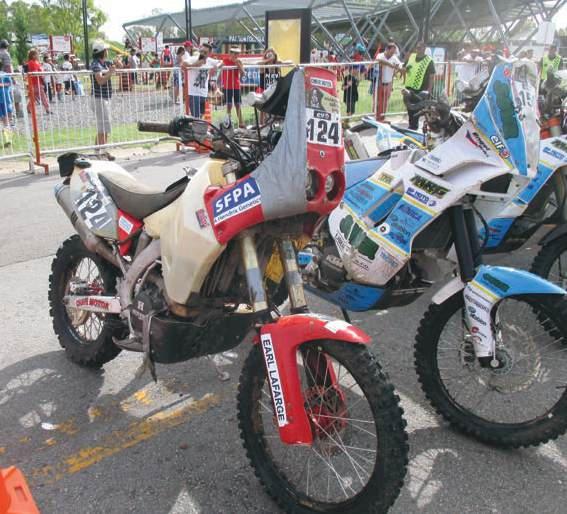
on his bike after his media commitments to have one last chat with Steve and myself, and we congratulated him on his riding. He mixed it with the world’s best and was lucky enough to be there. Thanks to Toby for signing my Aussie flag and helmet and just for being him.
Huge cheers also to see Rafal Sonik, winner of the quads, Nasser Al-Attiyah, winner of the cars and Airat Mardeev winner of the trucks. It was party time for everyone who finished the Dakar 2015.
A couple of nights later some of the tour group had gone home and there were six of us left, so out for dinner we went in Buenos Aires somewhere, talking about the trip and
our experiences and maybe feeling a bit sad it was over. Just as we ordered our first drinks Simon Pavey walked in with his family and friends for dinner as well. Our low moods vanished as we chatted with both Simon and his son Llewelyn on the riding over the past fortnight. They were the first father-and-son team to ever complete Dakar.
Remember the Swiss man and his brother I met at scrutineering? Remember they did it Malle Moto? They both finished – about 40hrs behind Marc Coma, for sure, but that doesn’t matter. They did it. Awesome.

Depending on where you live and ride, water crossings can be a novelty or a nuisance. They can be fun or challenging, and they’re definitely something that can be messed up with severe consequences. Miles Davis has dealt with some slippery situations.
Maybe it’s because it’s very common for mates to pull out cameras or because there’s a chance for a nice splash, but it’s way too common for riders to go too fast and take risks, all for the sake of a good pic or ‘bomb-in-the-pool’ type splash.
As with everything, experience is a huge advantage. A lot of riders have seen someone stack in a water
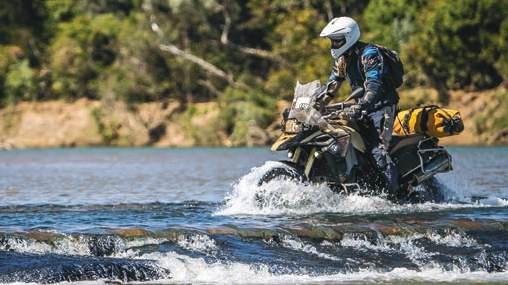
crossing, or drown their bike, or both. And knowing the risks involved you should really take even the smaller water crossings seriously and strategically.
If you’re riding in remote areas, especially up north where there are lots of creeks, rivers, dips and water, you need to take extra precautions. If you stuff it up you find yourself, literally, up the creek in the middle of nowhere.
There are some key points you need to consider, especially if the span is more than a couple of bike lengths.
Can you see the bottom? Do you know the depth? Did you see another rider go through to understand the depth and best – or worst – line?
If you don’t have the previous rider as a reference, the water isn’t clear and you can’t see the bottom, you should really assume the worst. It’s the only safe way. That might mean either checking with a stick or walking out into the water to check for depth and obstacles. Having wet boots might seem like an inconvenience, but it’s nothing compared to a drowned or bogged bike.
If you feel that the depth is suitable for you and your bike, give it a go, maybe have some mates standing in
the creek as spotters. If you decide it’s too deep for you or your bike, one option is to walk your bike across with the engine running in first gear. You can take it slow and be ready to pull in the clutch or hit the kill switch if things get messy. The other way is for you and a couple of mates to push the bike across with the engine off. This way you’re not risking the engine sucking water through the intakes. You can destroy an engine by filling it with water. A hydraulic lock can mean a bent conrod, and you can kill your big end with caramel milkshake for oil.
some heartache. Look where you want to go and be ready to adjust as required.
Sometimes creeks and rivers are pumping, sometimes the crossing is dead still. Know what you’re dealing with so you can approach and cross from the best side. If the flow is from right to left, try to start from the right, so you are working with the flow, not against it. If it’s flowing too hard don’t attempt to cross.
You’ve heard these terms before and it’s so important! Sometimes the best line is the upstream edge, or the downstream edge. Sometimes there are gibbers in middle of what would be the best line. Plan for the worst, hope for the best and you’ll avoid
Above: Sometimes the beautiful concrete surface is a blessing, smooth and grippy. Other times it’s a booby trap, just waiting to put someone underwater.
Left: A textbook standing position isn’t always ideal. Seated can sometimes be a safer option.

Getting washed down a flooded waterway can be dangerous – or even fatal.
Speed versus momentum
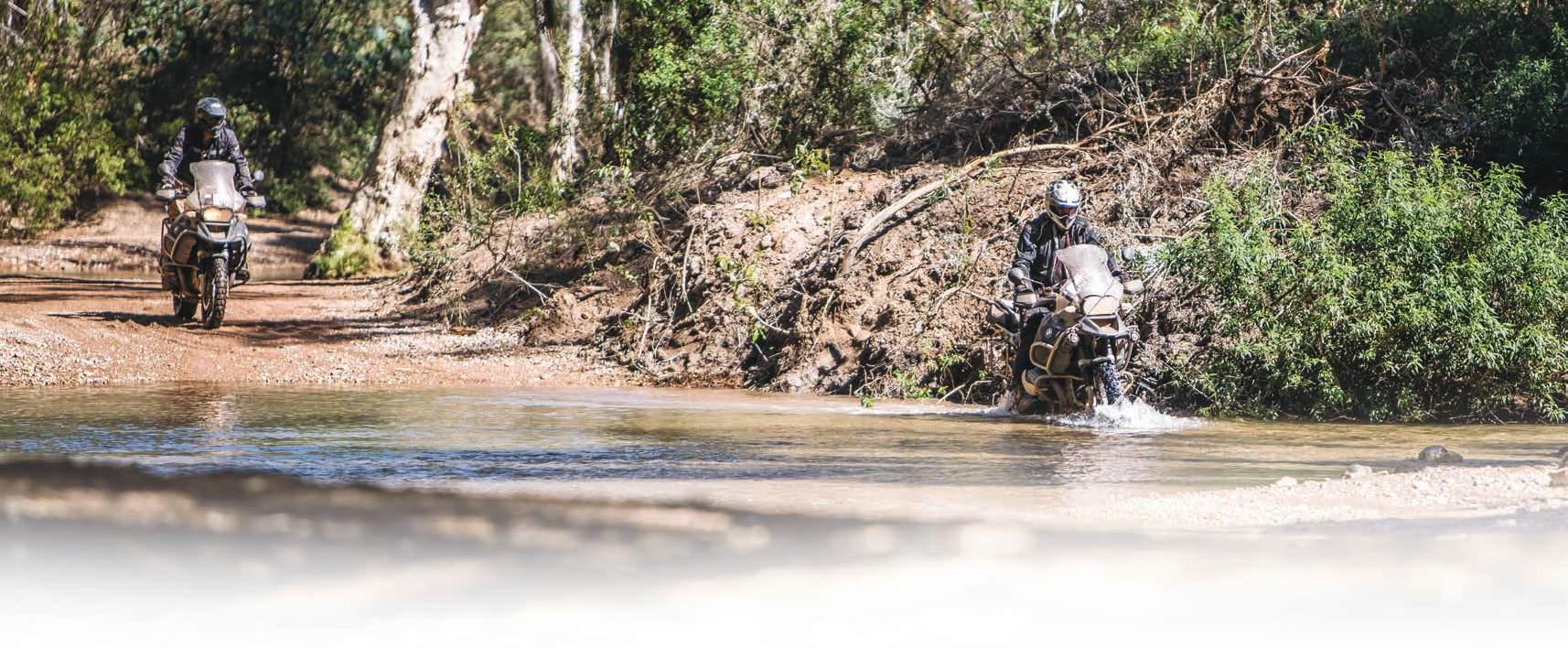
I’ve already mentioned this one, but for some reason a lot of riders substitute skill or strategy for speed. It can work, it can be spectacular and it can all too often go very pear-shaped. It’s true you don’t want to stall or get bogged, but that doesn’t mean you just twist the throttle and hope. It means you need to understand the surface.
Right: It’s way too common for riders to go too fast and take risks, all for the sake of a good pic or ‘bomb-in-the-pool’ type splash. u

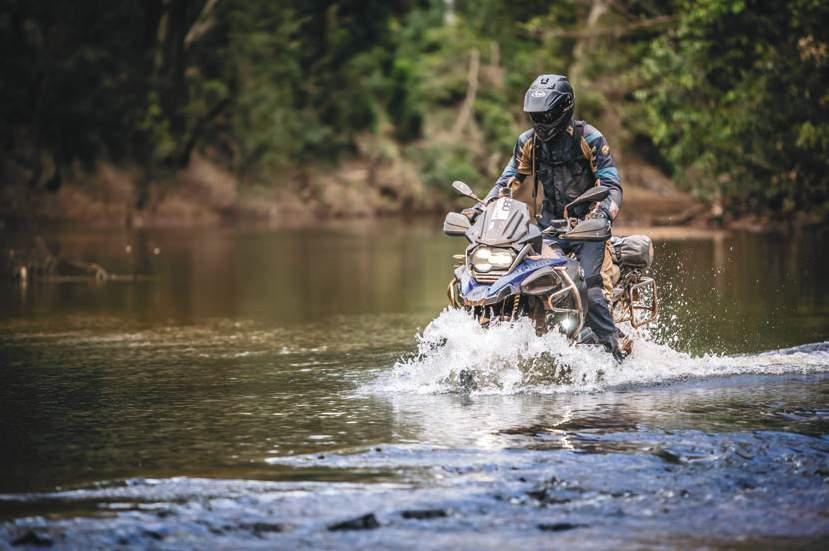
Is it soft and sandy? Or gravel? They’ll both drag momentum out of the bike. Or is it rocky and loose and wants to deflect the front wheel?
I’d prefer to be the guy who goes slow, trials-riding style, slipping the clutch slightly with the revs on a high idle and ‘feel’ my way across, adjusting throttle and clutch to
keep a nice, positive momentum without bogging down or launching, deflecting off a rock and ending up under the bike.
You might like to approach technical obstacles like creek crossings in the standing position, textbook style.

TC can be a great thing and helps many riders in many situations, but soft-based water crossings aren’t the places to have it switched on.
I’ve seen many riders try to ride through a crossing, heard their TC kick in and it’s brought them to a stop. You need to understand you may need some controlled wheelspin to get through a crossing, and TC in some modes just won’t allow wheelspin. At all.
Hopefully you can select the right mode or turn TC off easily to make sure it doesn’t stop you in your tracks.
You’ve heard this before too: have a plan, look ahead and execute well. You’ll have a much better chance.
Fixate on the front wheel and you’re a passenger. You might make it, but it’s more likely you won’t.
A causeway is like a game of Russian roulette. You just don’t know what you’re going to get.
Sometimes the beautiful concrete surface is a blessing, smooth and grippy. Other times it’s a booby trap, just waiting to put someone underwater. Again, I’m happy to be the boring, cautious guy. Slow down, creep across the causeway and try to understand the grip levels.
There are two main ways I would do this. The first is to pull in the clutch and dab the rear brake. If the surface is slick the back will let you know pretty quick.
That’s fine, even admirable, especially if the conditions are moderate and you’re confident you’ll make it across. But it doesn’t always work that way. If your textbook line goes wobbly and you stall, lose balance or hit a big rock and stop, you might be swimming before you can get a foot down and/or flick the kill switch. I’ve seen it way too many times. A rider goes for textbook, mucks it up and flops their bike into the water with the engine running. Then it’s a mission just to get the bike running again, and it means draining all the waterlogged oil.
A safer option could be to sit down, feet hovering off to the side of the footpegs, ready to contact the ground if required, and slowly ride through the creek. If things go wrong you simply pull in the clutch and put a foot down, simple as that. Even if your mates have to come and help push out, at least you didn’t drown your bike.
Above: An experienced rider will often opt for a slow, trials-riding style, slipping the clutch slightly with the revs on a high idle.
Left: If the flow is from left to right, try to start from the left so you’re working with the flow, not against it. If it’s flowing too hard don’t attempt to cross.
Right: Sometimes it pays to slow down and creep across the crossing, trying to understand the grip levels.
The other thing would be to do a very subtle throttle blip, just partially, to see if you get grip or slip. Depending on what these taste tests tell you, you’ll know how cautious you should be. If you know it’s slick you need to be very gentle. Simply turning the throttle from 10 per cent or 15 per cent to zero can be enough to make the back end overtake the front. Every control use needs to be precise and planned. Simply approaching the causeway at a rolling speed and pulling the clutch in can be a good idea. No engine brake to turn you into a 180degree bandit.
On the recce for the 2014 GS Safari Enduro, we had to cross some very intimidating water crossings, we were the first bikes heading across from Cooktown to Karumba after the wet season and the crossings had received no maintenance (ploughing of the wet-season sand drifts that block the entry and exit). The locals were telling us that the water was too high to cross, but we checked them out for ourselves and made good calls crossing by crossing. It was pretty intense and we took each crossing very seriously and made it through 15 to 20 crossings without incident. Sometimes the guys pushed bikes with no engine, sometimes we rode, but not one bike went under. A drowned bike wasn’t an option. We were too far from anywhere. A drowned bike would have been a disaster for the recce.
The positive of all of this was the rush of making it through. When we returned a month or so later, the water was much lower, the crossings had been graded and it was much easier. But because of complacency from some riders in the event itself we did have a few drowned bikes, which was disappointing. But I can tell you that most of the riders learnt a lot that week.
There’s no substitute for firsthand experience, and it’s just nice when you don’t have to make as many mistakes along the way to gain that experience. Happy trails.


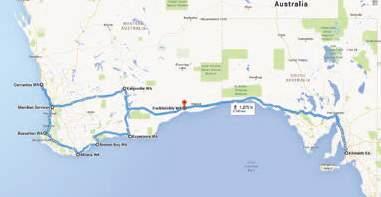
But then, from Cocklebiddy, having company was good, too.
“Vic and I headed down towards Twilight Cove, but on the way there I screwed up my shoulder,” said Lefty, matter-of-factly.
“From Cocklebiddy it was like the Nullarbor Plain. It was limestone with washed-out sections. Then the dunes started. The first couple were nothing much to speak of, but they got deeper and longer and steeper. I was going down like hot chips at the beach being thrown for seagulls!
“I was only going walking pace, but my legs were pretty much knackered because I was paddling through the sand the whole way. Vic was helping me pick up the bike, but I ended up pretty fatigued.
“We had one of many breathers, then went to head west, but most of it was rock with some sand in amongst it. That was it.
That was a far as I could go.”
He staggered up a sand ridge to find phone reception and the folks at Cocklebiddy sorted out a 4WD recovery party.
In all the falls and bike manhandling, Lefty ran into a problem specific to his prosthetic arm.
“Where my arm goes into the prosthesis, up the very top,” he
When we last spoke to Graham Bosenberg –‘Lefty’ to his mates – we found him building his KLR to tackle one mofo ride and he was asking whether any Adventure Rider Magazine riders wanted to join him.
A long-distance truckie by day, Lefty’s nickname comes from the absence of the lower part of his right arm. A head-on with an over-
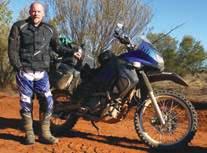

taking, speeding driver in 1986 made the change from ‘Graham’ to ‘Lefty’ in short order. As Lefty himself explained, “I went from being right-handed to being left-handed in about an hour-and-a-half.”
See issue #11 for the background and the bike build. What we wanted to know was how the ride went.
A few readers had responded to the call out in issue #11, so we figured Lefty would’ve had a manageable group to start.
But we didn’t know how many.
“None,” said the 54-year-old.


“I left by myself on October six and met Vic Bullman at Cocklebiddy on the following Friday. Vic stayed with me until Bremer Bay, and then left to head off home to Albany.”
That meant Lefty covered the first few days and around 1700km – about 450km of bitumen, the rest dirt – on his own. We reckon that’s a pretty
gutsy start. Lefty found riding for the first couple of days a total blast, especially along the Bunda Cliffs of the Nullarbor, The Basin outside Eucla and the Old Telegraph Track.
He’d been warned about stray lengths of wire on the old telegraph tracks, and south of Madura a good length finally grabbed him by the centrestand and threw him on the deck.
“I had to pick up the fully loaded bike on my own,” he chuckled.
“It happened twice, so I knew I could do it.”
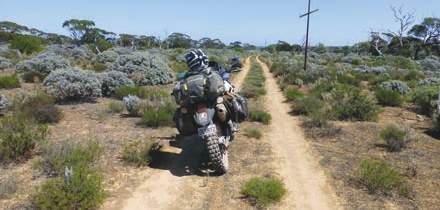













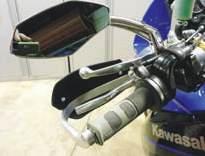



outlined, “it cuts in just over the rotator cuff and sits on top of the clavicle, or collarbone. On one of the falls I went down on my right-hand side and hit the windrow with my shoulder. The full impact was transmitted through the top of the prosthesis and onto the clavicle.”
Despite the pain, Lefty pressed on, but once he eventually pulled up, he knew he couldn’t have ridden out that day or the next.
With the recovery party on its way, Vic headed back to Cocklebiddy under his own steam while Lefty unloaded his KLR, made a campfire, and sat down to wait it out.
With himself and the bike back in good shape after a short break, Lefty set off to cover the 660km to Esperance on his own, where he again met Vic and propped for the night. The next morning the pair headed off following the coast towards Hopetoun, through the Fitzgerald River National Park, ending up at Bremer Bay from where Lefty again carried on alone.
After Bremer Bay Lefty and his custom-modded KLR tracked along through the Stirling Ranges, back down to Albany along the dirt, then barrelled through Denmark, Walpole, Pemberton, Augusta and along the coast to Busselton. The scenery and riding became even more glorious with a run through Nannup, Bridgetown, straight up to The Pinnacles, Cervantes and across to Morawa. Lefty caught up with the guys at Mach 1 Motorcycles at Midland, then backtracked to Merredin.

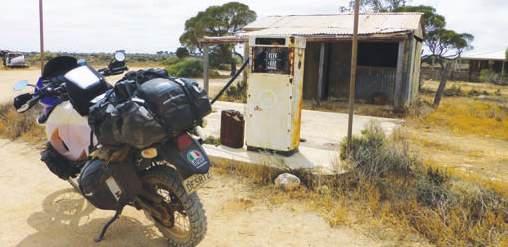
u
It was about this stage of the journey the temperature climbed up into the high-30s, and rolling into Kalgoorlie was a big relief. From Kalgoorlie it was back to Cocklebiddy – where it was 44 degrees –back to the border along the dirt, the old
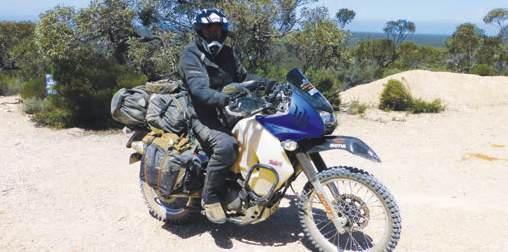

highway, Ceduna to catch up with friends for a couple of nights, Wirrulla, then north to meet Mark Welsh, 62, on his DRZ and Chad Hewitson, 35, on a BMW F800GS.
The was a lot of sand and corrugations to cope with on the way to Kingoonya, before heading across to Glendambo on the dirt, Pimba on the tar, Roxby Downs, up to the Oodnadatta Track, Maree, Copley and then back to Blinman, where things ground to a halt.
Lefty hit Blinman in company with Mark and Chad and the blokes came out in the morning to find the bearing in the sprocket carrier on the KLR was pretty much destroyed.
There was nothing could be done about it in Blinman, so after a quick phone call, Lefty’s son and daughter-in-law drove up with a trailer. After all he’d been through, Lefty finished the trip in a family car.
“I had to drive,” laughed the KLR adventurer. “The kids had been to a Halloween party and although they’d sprinted up early to make the pick up, they didn’t figure they should have to drive back as well.”
Total distance was 8031km, covered over 26 days. Lefty was in the saddle for 22 of those days, and the mighty KLR averaged 18.5km per litre.
From that whole epic journey, Lefty rates the second day as his favourite.
“It was a big day. When I left Mount Ive heading for the Nullarbor I did 602km and out of that only five kilometres was bitumen. I got to the Nullarbor just on sunset and it was absolutely beautiful riding. You could not wipe the smile off my face with a scourer.”
That’s probably as good a description of the joy of adventure riding as we’ve ever heard.
Lefty made his dream ride a reality. What’s stopping you?

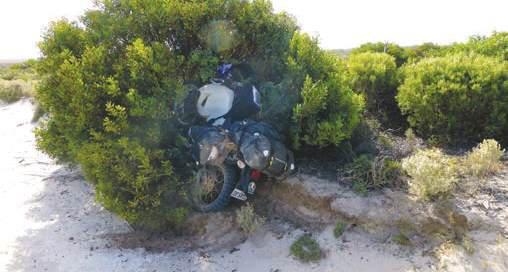

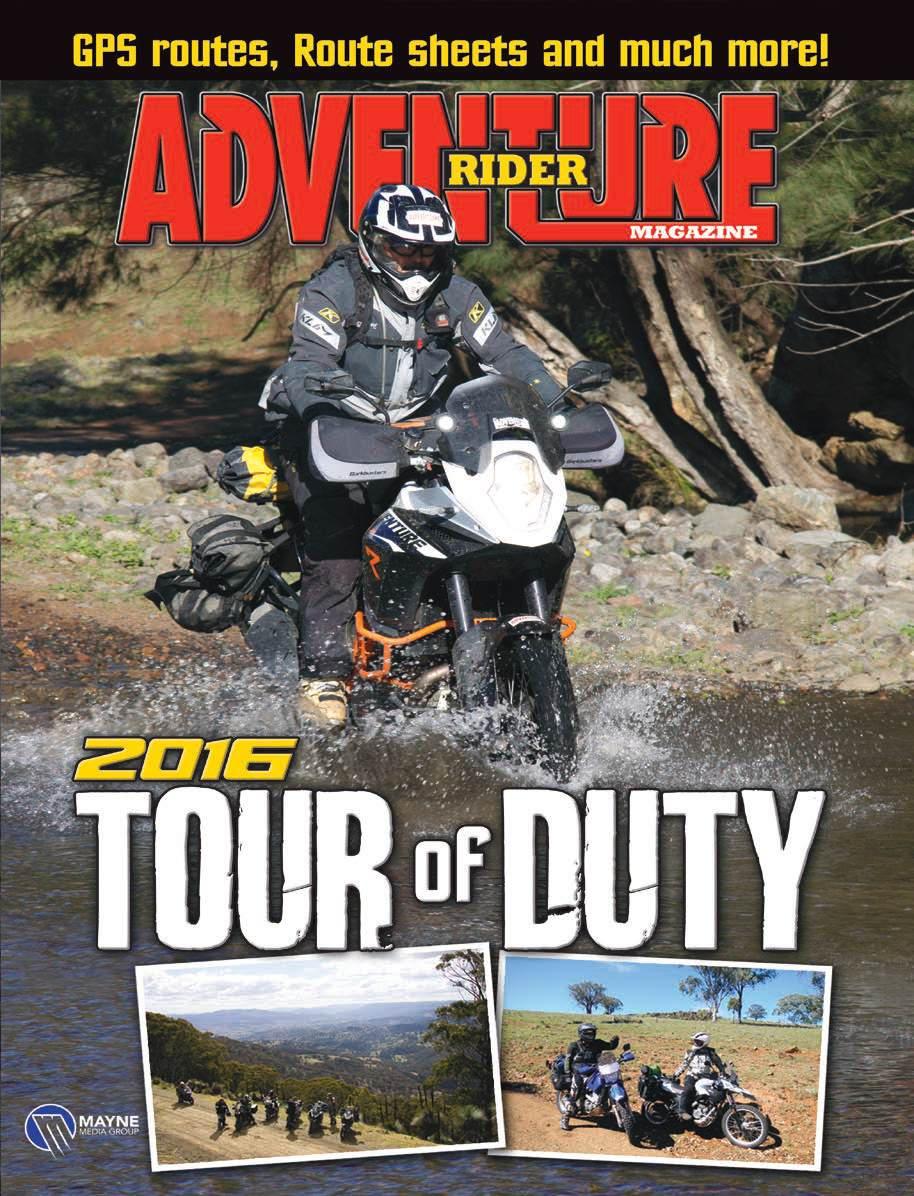
Rider training gets a lot of coverage these days, with everyone keen to improve their skills ahead of their next big adventure ride. But there’s little, if any, information on the task of carrying a pillion passenger or, perhaps more importantly, what’s required of the person sitting on the back. Touratech Australia’s Robin Box thought he’d delve into the dos and don’ts of riding two-up.
Words: Robin Box. Images: Pete Whitten.

Fun shared is double the fun, which is probably the main reason to take a pillion passenger. What can be better than sharing something you love with a good friend?
Many riders won’t be comfortable with someone on the back of the bike, but for those who aren’t interested in riding themselves, yet want to experience the joys of riding on the open road, being a pillion can be the perfect outlet.
The ability to connect with the outside world is something unique to motorcycle riding, with changes in temperature and the smells of nature – both good and bad – something that you can’t really experience fully in a car.
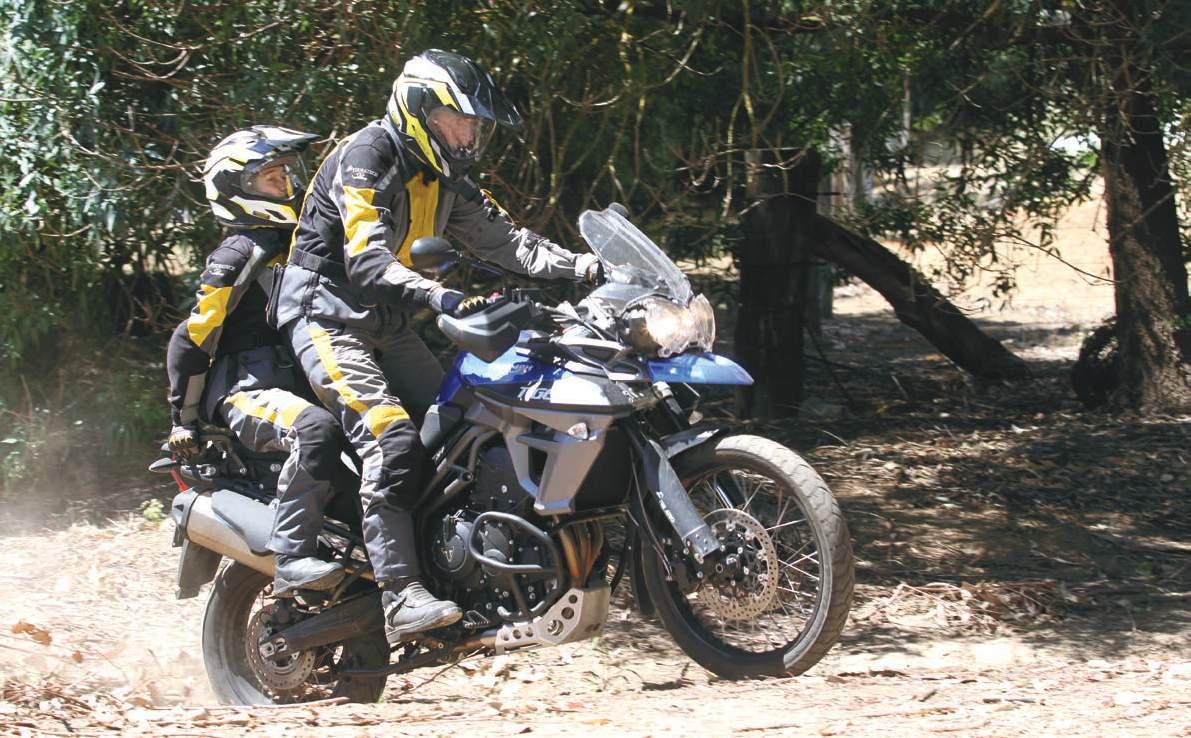
As a rider, you see things from a different angle when riding with a pillion. You’ll be more aware of your surroundings, spread your vision and be more smooth and predictable, and you’ll be able to point out highlights of the ride to your passenger.
Of course there’s a heightened responsibility that comes from riding with a pillion as you’re carrying more weight and need to leave extra distance for braking, as well as ensuring you’re riding smoothly and giving your pillion no cause for undue concern. As the pillion, the excitement of a bike’s faster acceleration can be a real high point, but this also needs to be tempered with an understanding of both the bike’s capabilities, and that of your rider.
Most experienced riders are capable of riding safely with a pillion on the back in most conditions. If you have the ability to control a bike well, the only limiting factor will be how you work as a team in a pillion situation.
Good communication is essential, with
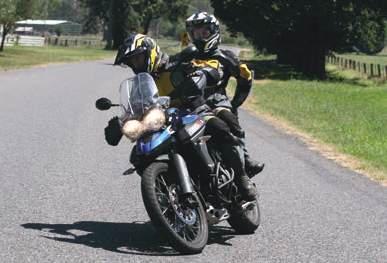
much weight strapped to your bike. But remember, they must work with you. Drunk people are very hard to carry –especially if they’re a rider – as they’ll try and ride for you, which is never a good idea.
open discussion between both parties the key to a successful partnership. A bad experience – either as a rider or as a pillion – can destroy your confidence and your enjoyment.
Talk to each other before your ride. Discuss what’s expected and what to expect. Discovering the pillion is moving around too much during the ride can be too late, so be sure to communicate clearly. As a rider, don’t ride at ten-tenths. Riding with a pillion is not the time to demonstrate your abilities – that’s the best way to destroy the whole experience for the pillion. Ride with quite a lot in reserve.
Sudden acceleration or braking lurches weight forward or backwards on the bike, making it unstable and scaring the hell out of your passenger.
You can ride fast, but make sure your riding is progressive with no sudden movements. And if you want to ride faster or try something different, communicate it with your pillion first.
Just like putting panniers, top boxes and things on the bike makes it heavier and changes the riding experience, so too will having a pillion on the back.
You’ll need to allow longer braking distances, corner more smoothly, and restrain from snapping the throttle on quickly or braking heavily. Riding with no sudden changes is the key. Where you put the load and how heavy the load is will also have an effect. It’s much easier to carry a pillion working with you as a team than it ever would be to carry that
Use driving with a loaded trailer as a reference point when carrying a pillion. Remember how this affects the handling of your car, and the same will apply with riding two-up.
The pillion’s perspective
A pillion passenger needs to hang on so they feel secure, as well as dealing with the braking and acceleration of the bike.
Keeping lateral or side-to-side movement to a minimum is important, and don’t clamp your legs to the rider – you only need to have comfortable contact. This shows the rider how you’re feeling and whether you’re relaxed or not.
Sit with one hand on your rider’s hip. That will give the rider an indication if you are paying attention (especially if the pillion is getting sleepy). You should be fluent on the bike and certainly not hanging on for grim death.
Keep your shoulders in line with the rider, and don’t lean into the corner. Similarly, don’t sit up straight mid-way through a corner as this makes the bike much harder to control and upsets the weighting of the bike.
When entering a right-hand corner, look over the rider’s right shoulder, and over the rider’s left shoulder for a left hand bend. It’s as simple as that.
Relax and follow the rider’s lead. Have one hand on the rear rack and the other on the rider’s hip. Talk to each other and give feedback, both positive and negative, of what you feel comfortable with and what makes you uneasy.
The communication between rider and pillion can literally make or break a ride.
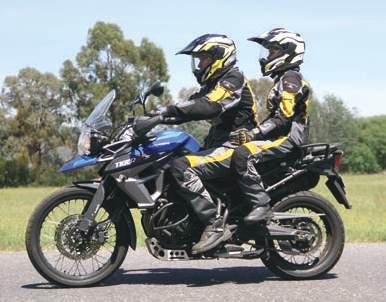
When riding with a pillion, and on gravel roads, you have to be more conscious of the extra weight changing direction as you corner, accelerate or brake.
If you’re an experienced rider, you’re used to how you weight the bike. You’ll know that putting your weight on the right peg initiates and right turn, and vice versa. You have to weight the bike carefully and gradually. Put the weight on the inside going into a corner, and the weight on the outside peg when accelerating out of the corner. It’s a common riding practice, but do it more consciously with a pillion because of the extra weight you’re carrying.
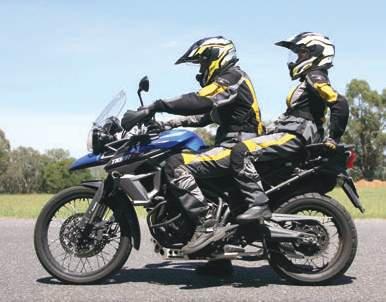
get the bike to steer on a tight corner. You absolutely need to be comfortable to do this, and should practice it before you’re in the situation where you require it.
Practice it in first or second gear on a safe surface, advising your pillion, “This is what it will be like when I stand up”.
When you’re standing it will be less comfortable for the pillion, but you’ll need to do it. The pillion needs to take some weight off their backside during these short periods, which are usually only for a minute or less.
Remember that standing up blocks the pillion’s vision, and makes it more difficult for them to see the road ahead and anticipate what’s coming up next.
hopping on a horse. They need to get their weight as far over the centre of the bike as they can.
Place a foot on the ’peg, lean your shoulders right over and spring off with your grounded foot, keeping your weight as close to the centre of the bike as possible.
Importantly, wait for the rider’s cue before mounting or dismounting, or you could both end up on the ground!
We’ve probably only touched the surface here, and experienced riders and pillions will have their own ideas on what works and what doesn’t. However, if you’re a novice at either and you use our information as a guide, you’ll at least get started on the right foot. Enjoy your shared adventure riding experience.
R If your position as rider or pillion doesn’t feel secure, work out what’s causing it to happen (rapid acceleration, pillion unprepared…whatever)
R As a pillion, don’t exaggerate your movements, such as sitting up straight in a corner. Follow the rider’s cue
R On loose surfaces, the pillion should take some weight off their bum and put more on their legs
R If the pillion is nervous or cold, they will clamp their legs on the rider, ending up with sore muscles and making for an uncomfortable experience
R Communicate
R If something works well, tell each other. Lift visors and chat about conditions, road surfaces and so on
The pillion should never have their hands on the rider’s shoulders or with two arms around your waist. This makes it even harder for the rider, who is then essentially hanging on for two people.
Top left: A well-placed pillion will sit with one hand on the rider’s hip and the weight near the centre of the bike.
Above right: A pillion with both hands on the rack or seat handles will often have their weight well back, making bike control difficult for the rider.
If your pillion is ‘riding’ the ride with you, their weight will naturally and sub-consciously shift to where it needs to be. Having their weight too far back doesn’t help with the stability of the bike.
Below 1: Mounting needs practice for the pillion. Place a foot on the ’peg, lean the shoulders right over the bike…
Below 2: Spring off with the grounded foot, keeping weight as close to the centre of the bike as possible.
Below 3: Let the rider know when you’re in position and comfortable. Wait for the rider’s cue before mounting or dismounting.

If you’re familiar with gravel, you won’t be too worried about the bike moving around a little. But your pillion might be. You need to ride fluently and let the bike move a little. This can be off-putting for a pillion though, as it doesn’t feel natural or comfortable.
The pillion still needs to ride the ride with you, and not sit like a frozen lump. The passenger should ease some weight off the seat, with more weight on the legs, and hold more weight on the rear arm. Take some weight off the bum and the pillion will feel a lot more comfortable. While doing this, the passenger’s hand should stay on the rider’s hip, and there should be less seat pressure. It’ll become second nature very quickly.
In difficult situations, the rider will need to stand up – such as on steep hills, or loose, rocky surfaces and sometimes to


In these instances the pillion either uses both hands on the rear rack, or sometimes may still put a hand on a tall rider’s hip – this allows the pillion to still move and keep in line with the rider.
As the pillion, keep your weight upright, and don’t go with the bike, let the bike do it’s own thing
Getting on or off shouldn’t be overlooked either. The pillion does it as they would for


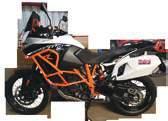
Robin Box grew up on a farm where there were more riders than bikes, so ‘dinking’ was a regular occurrence. Under-suspended, underpowered bikes like Suzuki 185s and Yamaha 250s were the order of the day.
Over the years he’s continued riding two-up with family and friends and has done a lot of ferrying of photographers at major cycling events. He admits to feeling very comfortable riding two-up, and says he gets longer tyre life and better fuel economy because he rides more smoothly two-up – all while maintaining a decent average speed.



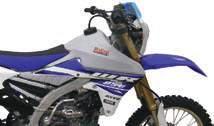
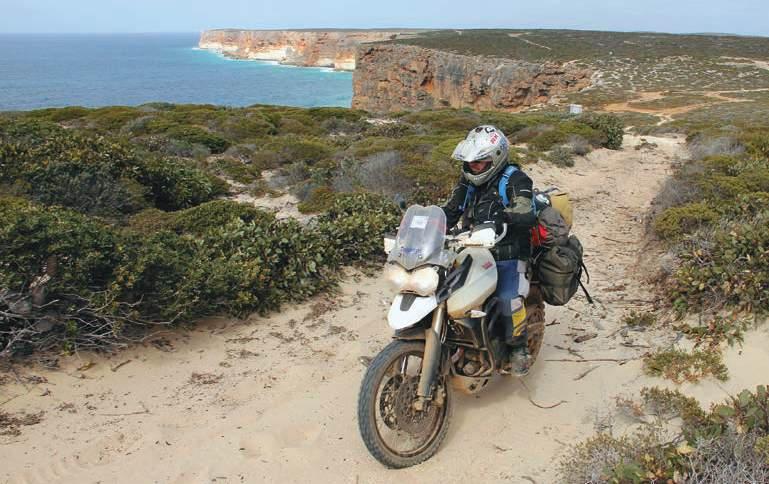

For a mix of brilliant organisation and serious off-road adventure challenge, BMW’s GS Safari enduro pretty much sets the pace.
There’s been plenty written about the BMW’s GS Safari. Adventure Rider Magazine alone has written plenty and there’s no doubt it’s a fabulous riding occasion. Organisation is excellent, comradeship among riders and organisers is fantastic and the course is designed specifically for the bikes the riders own: BMW GSs.
As much as we love the GS Safari, there’s an event we love just as much – the GS Safari Enduro. The GS Safari is the bigger of the two events, catering to everyone with a wide variety of terrain. The GS Safari Enduro runs more challenging, technical terrain, longer days and usually more remote locations.
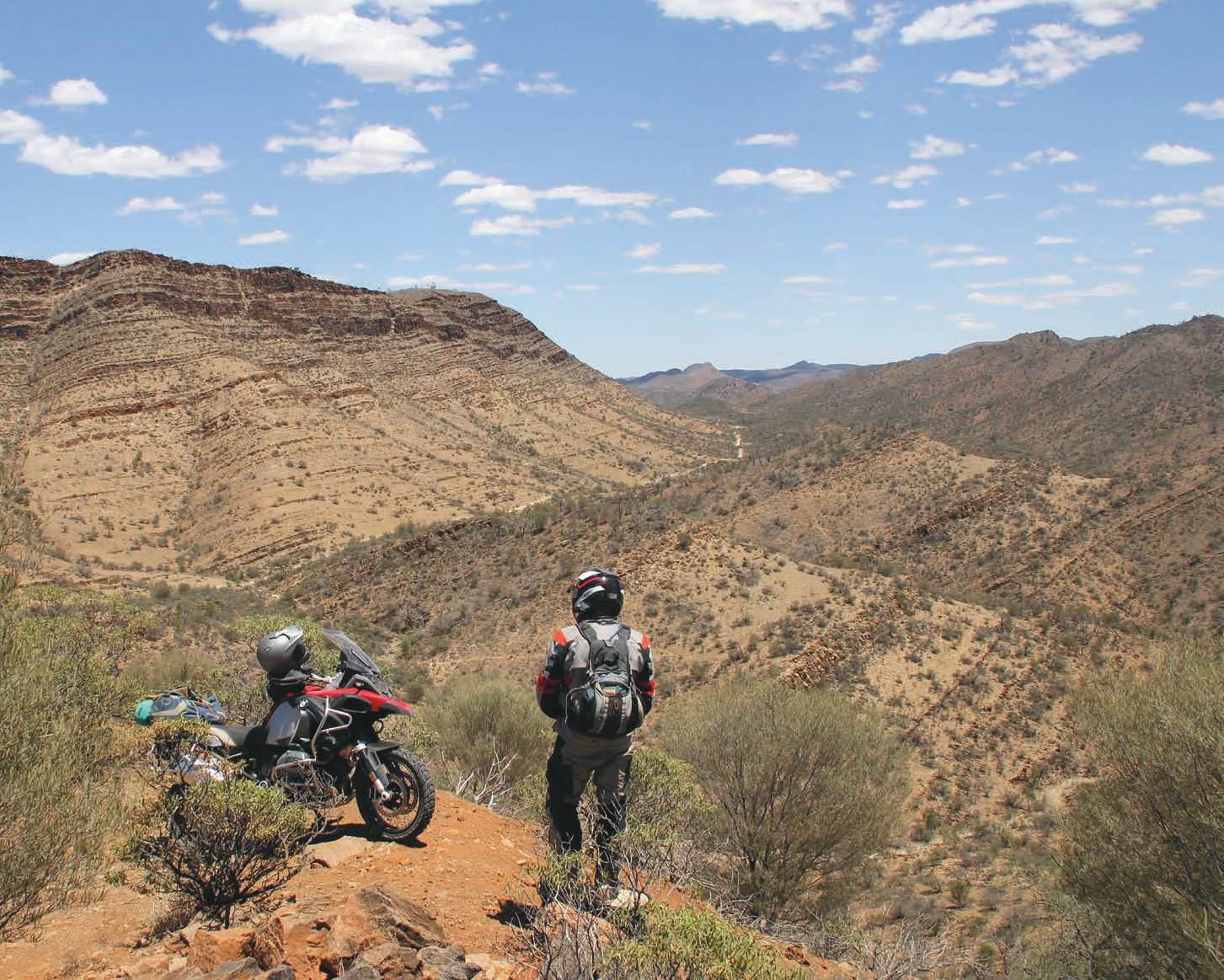
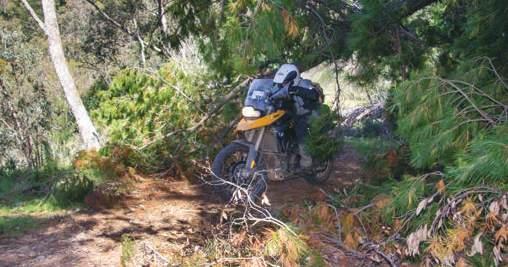
The next step
The GS Safari is designed to suit the GS range. The focus is of off-road, but when required there are some great twisty roads thrown in. There are plenty of opportunities for sightseeing and always a great meal and a beer at the end of the day. It’s what the GS bike is all about.
But for those who like to be challenged, the GS Safari Enduro routes include far more technical terrain aimed at riders with off-road experience and who are physically ready for it. The longer days, tougher terrain and remote locations mean riders need to be prepared for a far more serious undertaking.
Below left: The history to be found just weathering away in the Flinders is fascinating.
Below right: The riding on a Safari Enduro is meant to be more challenging than a GS Safari. Riders need to be experienced and physically prepared for longer and more challenging days on the bike.
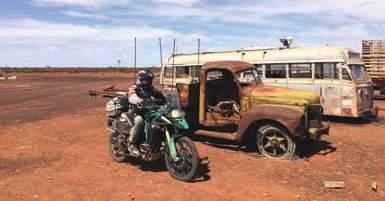
We’ll never forget the incredible riding and brain-wrenching scenery of the 2013 Safari Enduro. Between paddling across creeks and torqueing our way up loose, rocky hills, we scooted an F 800 GS through the Victorian high country and were left in awe of just how beautiful was the scenery, how enjoyable the riding, and how fantastic the bike. In the evenings we slurped ice cream and dined in style at places like Bright, Dargo and Mt Baw Baw and during the day we raged around, hurling the 800 at some rugged and breathtaking countryside.
In 2014 the event guided riders on a 3500km outback run from Darwin to u
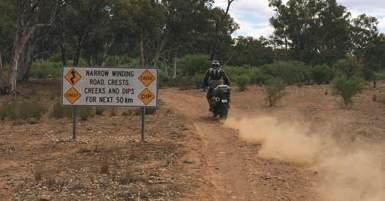

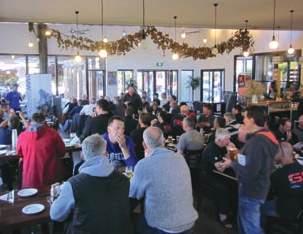


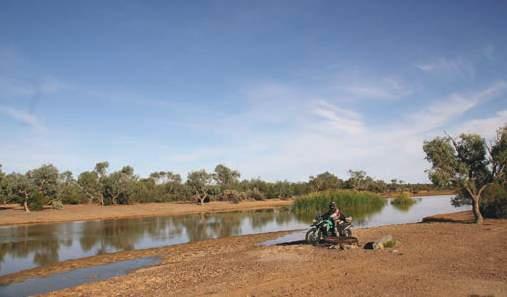
Palm Cove, near Cairns, through some of Australia’s most iconic landscape. In 2015 the BMW off-road specialists kicked off in Bourke, NSW, and followed the Darling River towards Mildura, camping at amazing stations along the way. The route wound its way through the Murray Sunset Desert National Park, tackled the iconic Border Track between Victoria and South Aussie and followed the Murray River to its mouth, close to Victor Harbor in South Australia. There’s some glorious video from all those events. You can find teasers on Youtube. It’s not that the Safari Enduro sends riders into ridiculous, impassable terrain, but a lot of the ground covered is just a tad more trail-oriented, and tests a rider’s off-road competence a lot more than the regular GS Safari.
There’s a mix of BMW models in the Enduro. It doesn’t matter if you ride a 650 or a 1200 GSA, but you need to be able to handle your bike when the terrain gets challenging.
And now there’s been a new Safari Enduro announced for 2016.
This year’s event will kick off on July 24 and run from Streaky Bay in South Australia. Riders will head up through the Flinders
Above: There’ll be plenty of opportunity for taking in the countryside.
1: Adventure Rider Magazine discovered the Safari Enduro in 2013 when we were lucky enough to ride the Victorian High Country. We’ve been busting to do another Safari Enduro ever since.
2: Great catering and strong mateship is part of the deal.
3: Geez. The course must’ve been a bit much for this guy. Mt Freeling Station is another popular sight in the Flinders.
4: There’s some wild sights to take in. Coober Pedy in northern SA has some interesting landmarks. Below: Everywhere you look and ride is gorgeous.


Ranges, taking in Lake Eyre, Arkaroola, Wilpena Pound, and after six glorious days, wind up in Broken Hill, NSW.
That’s a glory list of adventure destinations right there, and having experienced the route-finding prowess of the BMW folks several times, we’re backing this event to be life-changing.



We mean it. We’re backing it. We’ve signed up and can’t wait to get to Streaky Bay to make a start.
BMW has volunteered a new 2016 F800GS, the boss has hinted we might be allowed to use the office swag (as long as we leave a deposit), and we’re going to live lavida loca on what we expect to be



one of 2016’s premium rides. By the time you read this registrations will be open, so log on to www.bmwsafari.com/ events/2015-bmw-gs-safari-enduro/ and get yourself signed up. Meanwhile, we hope to bring you some set-up info on the bike next issue. Man! We can’t wait for this one!
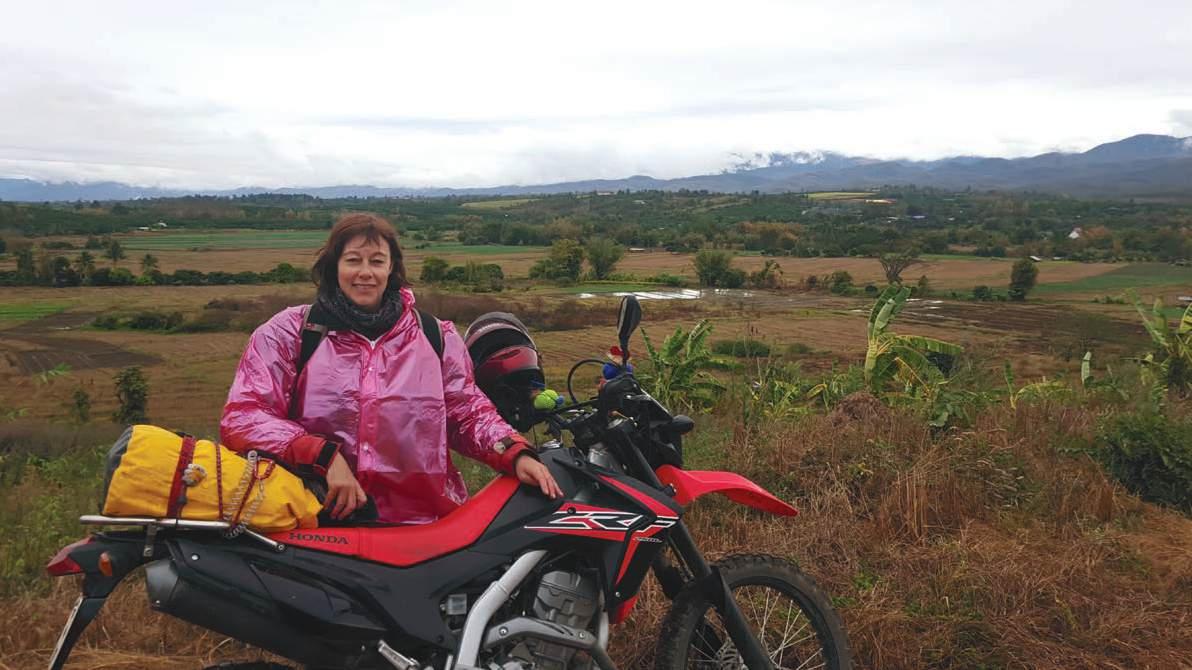
I’ve got this romantic notion that Dave and I headed off on our recent two-week riding trip in northern Thailand completely winging it. Except that’s far from the truth. Old travel hands will know all of this, but for anyone contemplating their first overseas adventure, this may give you a starting point.
You’d be surprised how many of my friends hadn’t realised most countries require you to have six months remaining on your passport on entry (perhaps that says something about the company I keep?). While there are countries
such as Thailand where Australian passport holders don’t need a visa in advance, others have varying requirements, including payment of the exact total in a particular currency. I had a bit of a panic arriving at Bangkok airport when I saw the visa-on-arrival queue and hadn’t checked visa rules for Thailand for a number of years. For me, smartraveller.gov.au is a great starting point for different countries’ requirements. With all the natural and manmade events going on in the world, I also chose to register our trip on that site too.
For those inclined towards vaccinations, some need to be given
six months apart before your trip. Reading some of the recommendations to avoid typhoid, it seemed everything that makes overseas travel so interesting is no good: avoid ice (how else can you get your beer cool?); avoid eating at street stalls (I’m not spending my time in a foreign country having restaurant-chain meals); wash your hands after going to the toilet (okay, hand sanitizer will work here...when you remember to have it with you); or only eat fruit and vegetables you’ve peeled yourself (that would mean missing pineapple with chilli salt). think you need to exercise common sense, and it probably comes down to pot luck too.
Apparently not. Obviously there were different rules for the bloke on our flight carrying his helmet. We stuffed ours with our gloves and the armour from our pants (which we wore over on the plane with our boots), wrapped them in in our jackets and put them in a suitcase. We also had a first-aid kit and two waterproof bags for the bikes in there. We each took a backpack with our clothes, a pair of shoes, toiletry bag and GPS as carry-on.
We took local currency and Australian dollars as cash (changing at a money changer) and a debit card loaded with Thai baht. We never used EFTPOS, mainly because most of the places we went didn’t accept cards. ATMs were everywhere, so it wasn’t hard to get money out to last quite a few days. Keep an eye on the local withdrawal fees though.

karen Ramsay
for only booking five days to start with was, if there were any issues, we’d only lose a small deposit. However, I’d also flagged with the bike-shop owner that we may want them for double that.
We flew into Bangkok where I’d pre-booked a sleeper on the overnight train to Chiang Mai. Looking at it now, the only thing I left to chance was where we were going to ride.
Now this is only my opinion, but I think you’d need to have rocks in your head or be very rich if you’re riding overseas and don’t have travel insurance. Just check the insurance covers the actual size bike you’ll be riding. While I’ve never needed to make a claim and I’m sure there are people who’ve got horror stories, I’d sooner have it than not. When we got home, but our bag containing my boots and both our motorbike pants didn’t, travel insurance was looking like a wise investment. Thankfully the bag turned up a week later.
I thought I’d do the right thing and check with the airline if we were allowed to take our helmets as carry-on luggage.
We chose not to go with an organised tour – partly because I’m a tight-arse, partly because I don’t like people making my decisions for me and partly because we like the freedom of choosing where and when we’ll ride. So while that gives independence, it also has its drawbacks. I’m sure there was plenty we missed out on seeing. Also, there were lots of things we saw and didn’t understand – like the procession coming down the road from the temple meeting up with another procession from town, with lots of music, dancing and a young monk on the back of a ute. The fact we were riding around the countryside looking for a missing purse meant we didn’t stop to enjoy the occasion and without a guide we didn’t get to find out later what it was all about.
Being peak season, I pre-booked two CRF250Ls for five days and hesitantly paid the 50 per cent deposit online, hoping we wouldn’t turn up to find a Go-Go bar where the bike shop used to be. The main reason
For this trip we didn’t worry about taking any tools with us, figuring in Thailand we’d never be too far from someone who could to help us out. We did get some spares off the bike shop to carry with us: two tubes, a clutchand brake lever and a gear-selector shaft.
Before going, I introduced myself on a local forum. As a result we created contacts who have since become good friends. We also bought a couple of maps and used a local SD card in the GPS to help us navigate off the main tracks.
As far as costs go, the bikes were $32 each per day. Fuel was around $10 per day per bike for our average of 200km each day. Other than the touristy places, accommodation in average-to-nice places was between $15 and $20 each night. Food and drinks varied between $15 and $50 each day for the two of us.
See issue #17 for the full story of Karen and Dave’s Thai adventure ride!
R Anyone who travelled before the internet has my deepest respect
R Anyone who embarks on any adventure, large or small, has my respect too
R When the kids ask if they can have a party while you’re away, it’s best not to ask to see photos
R Obviously you need to check your bags four times before you’ll find your missing purse
R We’ll definitely be riding overseas again!

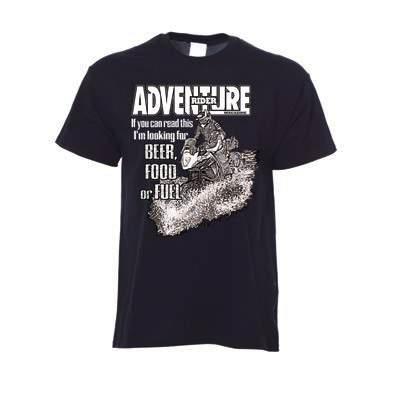

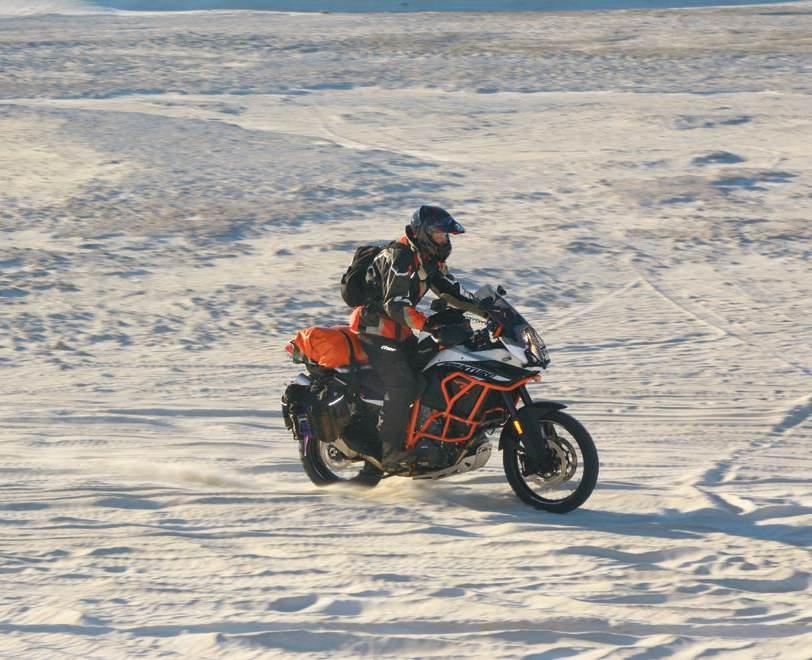





There’s some great new gear around. Get in quick before the tax bill arrives!
AltRideR duAlContRol bRAke system
Improve your brake control without breaking the bank.
R Enhance braking control and reaction time
R Made of three components available separately or as a kit
R Stainless-steel bottom plate and hardware to endure the abrasions of off-road riding
R 100 per cent designed and manufactured in the USA
R 22mm and 32mm riser heights available
R Pins provided with enlarger for enhanced grip, extras included. Enlarger and riser available in black or silver
RRP: $135 plus postage

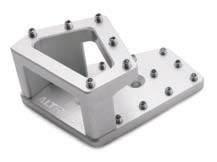
foRmA teRRAin tX enduRo boots
shoRty bRAke And ClutCh leVeRs
R Made out of
R Six reach settings so you can adjust
R Available in seven anodised colours
R Available for a huge range of different makes and models
RRP: Regularly $229. On special now for $179
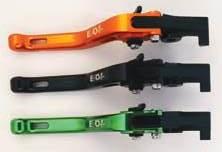
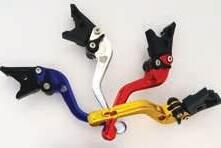
Available from: Rad Guard Phone: (02) 6658 0060 Web: www.radguard.com.au
tRiumph tRek suit
For the Tigers and Explorers!
R 600D Polycordura and micro rip-stop combination outer shell
R Removable, CE-certified D30 protectors
R Removable TriTex waterproof liner. Can be worn as a separate casual jacket
R Stretch flex zones
R Superfabric ceramic laminated panels
R Side adjustment zipper
R Reflective panels
R Zip-opening ventilation in the jacket
R Connection zippers for jeans and pants

olympiA
A
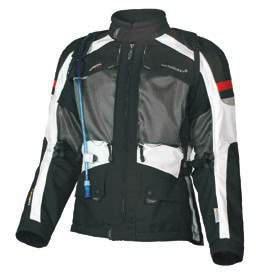
Jacket RRP $550
Pants RRP $395
Available from: AdventureMoto Web: www.adventuremoto.com.au bikeRz ChAiR
See more at: www.triumphmotorcycles.com.au
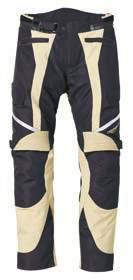
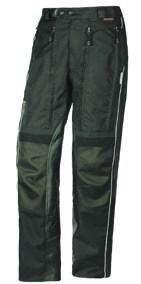
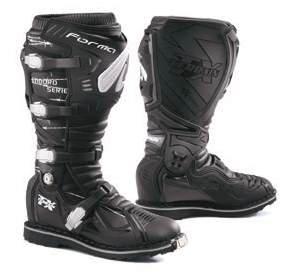
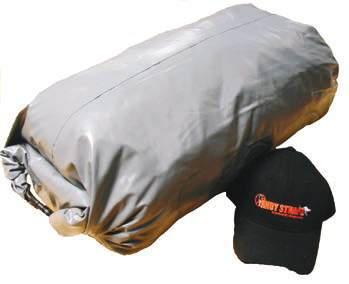
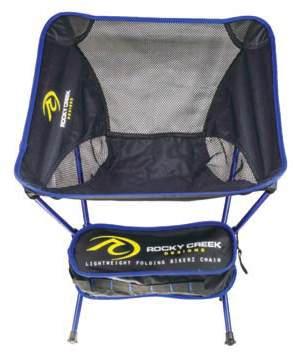

duCAti touR hV fAbRiC jACket
Italian style and performance!
R Light reflective fluorescent yellow high visibility 450D polyester
R Removable thermal lining
R 100 per cent waterproof and ventilated
R Adjustable arms, neck and hip fasteners to offer comfort
R Adjustable vents on arms, chest and back for max internal air flow
R Jacket to pants zippers for compatibility with riding trousers
R Reflective prints for greater visibility and safety
R Four outer pockets, Three internal pockets
R CE protectors on the shoulders and elbows
R Suitable for use with back protector (purchased separately)
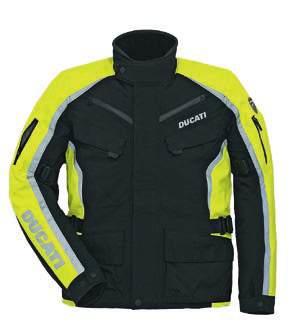
ReV’it CAyenne ii
jACket And p
Hot-weather Hard-core Adventure Apparel.
R Dutch ‘Engineered Skin’ design
R Super ventilation via aero cool 3D SchoellerDynatec mesh panels
R Super protection featuring Seeflex CE Level 2 shoulder and elbow armour and Seesoft back protector
R Detachable in-built kidney belt
R PWR Shell 750D construction with Telfon coating and leather elbow reinforcing

R System upgrade available: Adventure neck brace, Hydra Bag insert, cooling vest, multiple thermal inner-jacket options
Effective protection.
R External high abrasion resistant mesh
R Tenax Polyamide reinforcements on arms and back
R Certified Forcetech internal protectors on shoulders and elbows
R Warrior back protector
R Warrior chest protector
R Five outside pockets
R Ready for H2Out waterproof membrane
R Arrangement for thermal padding

RRP: Jacket $699. Pants $499
Available from: Overlander Adventure Equipment Phone: (08) 9250 5559 Web: www.overlanderae.com.au

supeR ténéRé Alloy sump GuARd
Simply replaces the standard plastic skid plate.
R Helps the bike to glide over obstacles
R Provides protection for the lower frame and engine components
R Made from three-millimetre high strength alloy
RRP: $264.64
Available from: Your local Authorised Yamaha Dealer or Y-Shop Web: www.yamaha-motor.com.au

bmw np2 RAllye suit
Optimum protection and an improved fit.
R Specially developed for off-road use
R ProTechWool combination of materials
87 per cent polyamide, 13 per cent wool
R Jacket with removable sleeves
R Trousers with stretch inserts and leather patches
R Removable NP2 protectors at the shoulders, elbows, back, hips and knees
R Silicon strip on insert seam prevents suit riding up
R Stretchable, breathable mesh lining
R Ventilated in various places
R Fully adjustable
R Breathable, windproof and waterproof CARE climate membrane (removable)
R Reflective material
R SVEN jacket pockets, back pocket for TrinkPak, three trouser pockets
R Connecting zip (40 cm)
R Sizes: 46–66 / 98–118 (Grey/Blue). 46–60 (Black/Red)
RRP: Jacket $1200. Trousers $900
Available from: From all BMW Motorrad dealers Web: www.bmwmotorrad.com.au
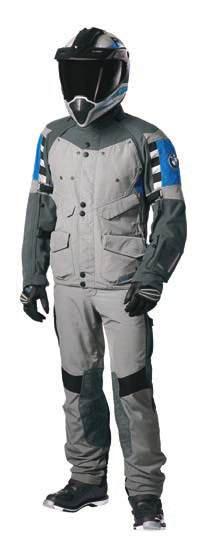
ktm 690 enduRo 2007-2016 And husqVARnA 701 enduRo 2016 pRe-CleAneR kits
A complete pre-cleaner kit that replaces the top half of the air box.
R Improve airflow
R Remove 90 per cent or dust before it reaches main filter
R Improves sealing of the main filter to the base of the airbox
R Kit includes one powder-coated aluminium air-filter bracket, one inner support cage and two pre-filter foams
RRP: $105
Available from: Your local dealer Web: www.uniflow.com.au and www.ficeda.com.au
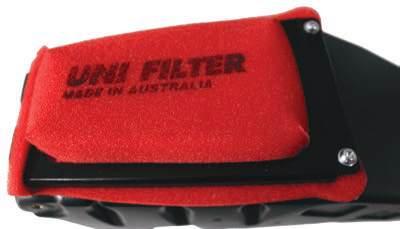
held hAkunA jACket
Another top-shelf Held product.
R Coolmax mesh lining
R Detachable waterproof, windproof and breathable HUMAX
Z-liner inner
R Four external pockets, two inner pockets. Back pockets
R Air-vent zippers in front, back and arms
R Zip-off side panels
R Dual arm adjustment
R Hip adjustment
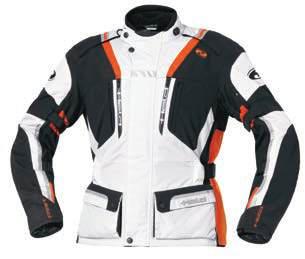
R Stretch panels at shoulders
R Soft collar
R Vent channel behind main zip
R Sizes S, M, L, XL, XXL, 3XL only in grey-black 68: 4XL, 5XL, 6XL R Colours
R SM Pro Platinum rims, made from high quality 7116 series aluminium
R Heavy duty-zinc plated carbon steel spokes
R Nickel-plated brass nipples
R Hand-built in Australia.
R One-year warranty on hubs
R Moto-Master, aftermarket discs available
R Wheel sets do not include sprocket- or disc-bolts
RRP: $1595 per pair
Available from: Your local dealer Web: www.jtr.com.au


Discs
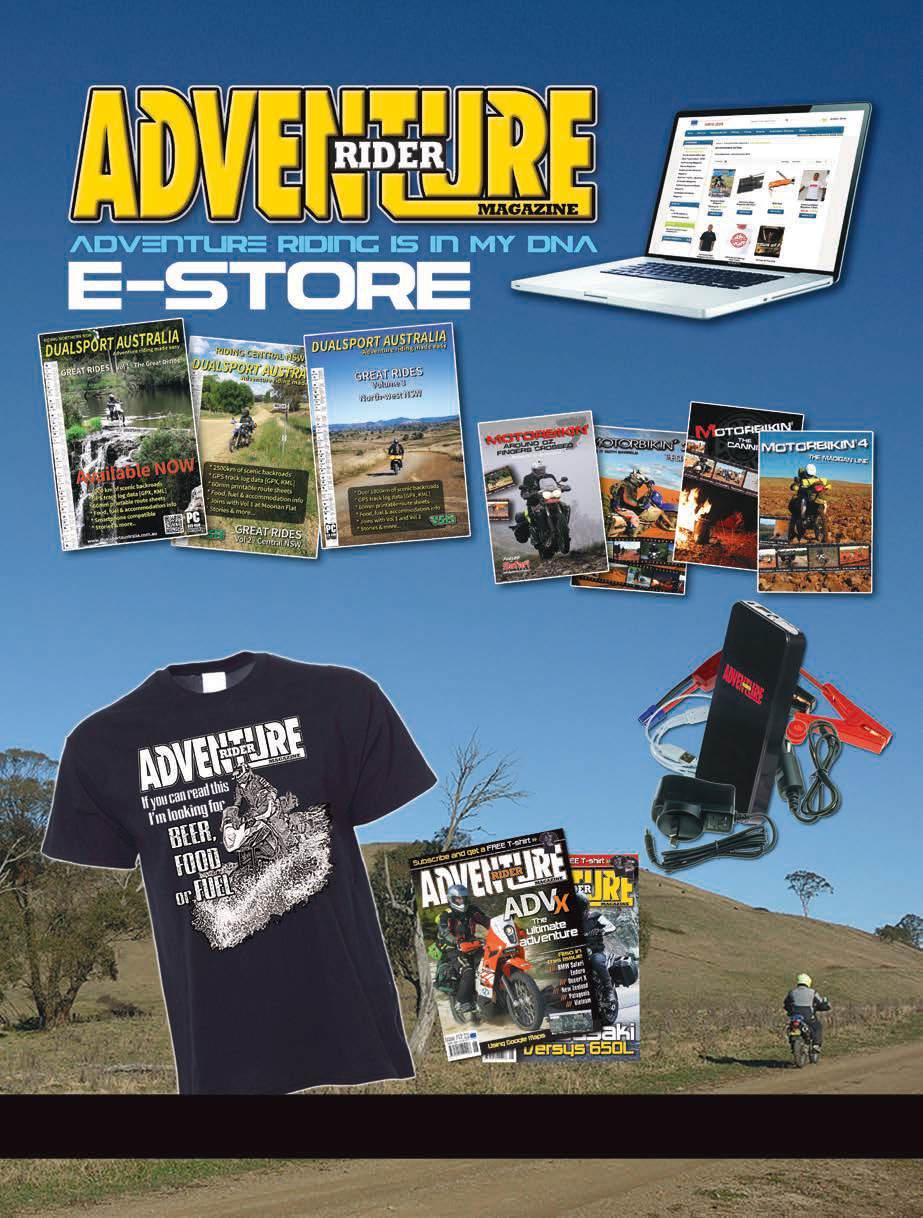


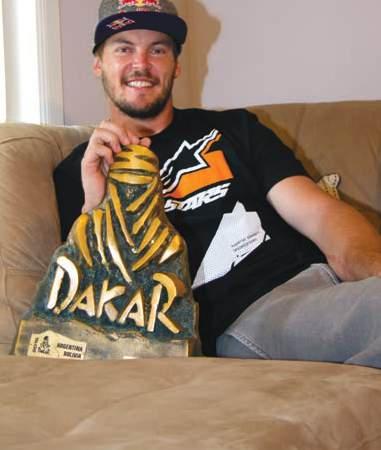
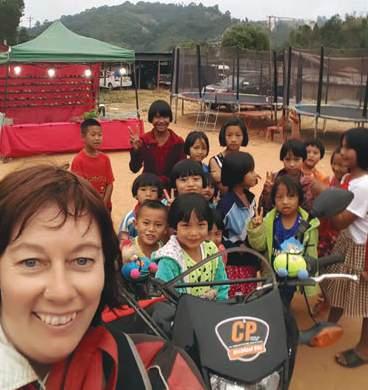
The Africa twin is here at last! And, as expected, Motorrad Garage has already kitted out the big Honda. The Motorrad Garage folks have all the inside info from Europe before the bike was released here, and this is what they reckon we’ll all be looking for to kick off. Go to www.motorradgarage.com.au/index. php?route=product/category&path+457 to keep up as the list grows.
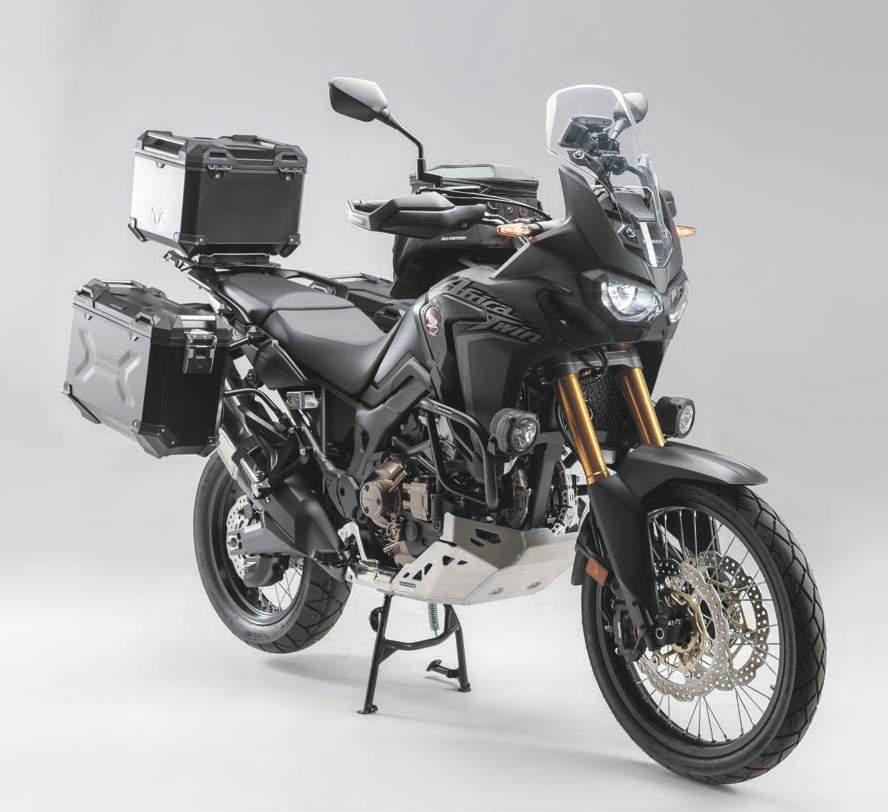
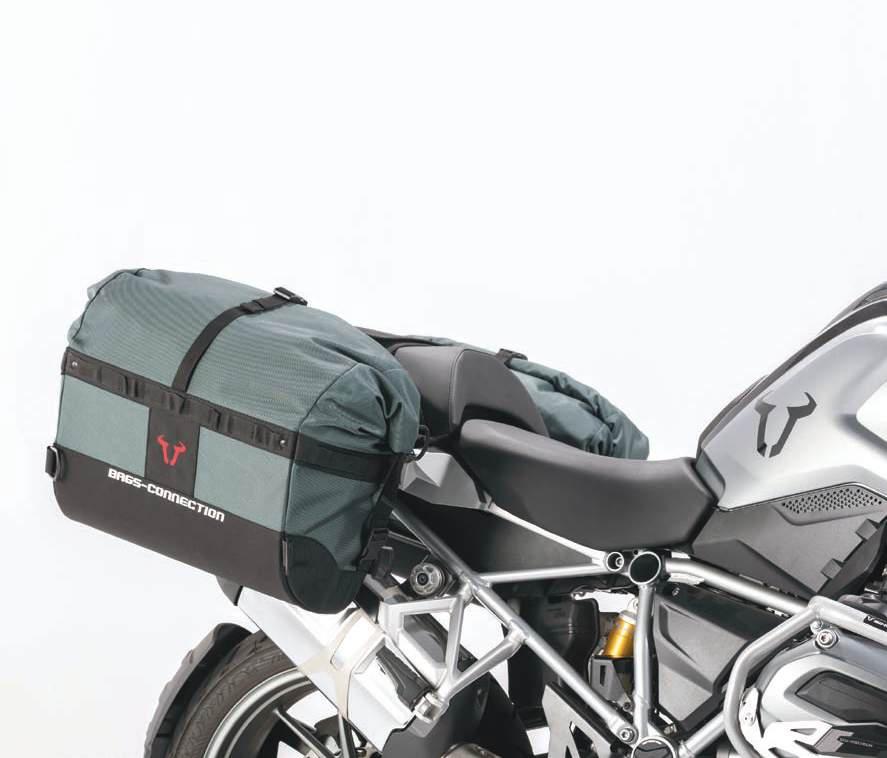


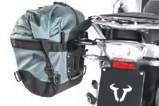
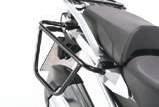
Regardless how hard you ride or what the terrain is like, DAKAR Panniers are made to survive and are sure to impress with their design and functionality.
The two-layer system of the bag combines a tough exterior outer layer with a waterproof inner layer, and together with the waterproof Velcro roll closure, you have a super-durable dry bag. Each bag offers a volume of 32 litre and weighs 1.6 kg. DAKAR Panniers are available as a bike specific and universal version. Visit our website for more info.
Around the corner or around the country, the KLR650’s incredible versatility and rugged go-anywhere attitude make it the ideal commuter for negotiating the city streets and the perfect travelling partner for clocking up countless kilometres across this great country. The KLR650’s mountains of torque and huge carrying capacity will take rider and passenger beyond where the pavement ends and to where adventure begins.
• SLIMMER, IMPROVED MULTI-CONTOURED DIMPLED SEAT COVER
• LARGE REAR CARRY RACK POWERFUL DUAL GLOBE HEADLIGHTS
• SMOOTH, TORQUEY LIQUID COOLED ENGINE
• LARGE 22L FUEL TANK FOR EXTENDED TOURING IMPROVED HIGH-PERFORMING FRONT AND REAR SUSPENSION
• LOADS OF GENUINE ACCESSORIES AVAILABLE

Need help deciding…? ask the Kawasaki Expert www.kawasaki.com.au/kawasaki-expert
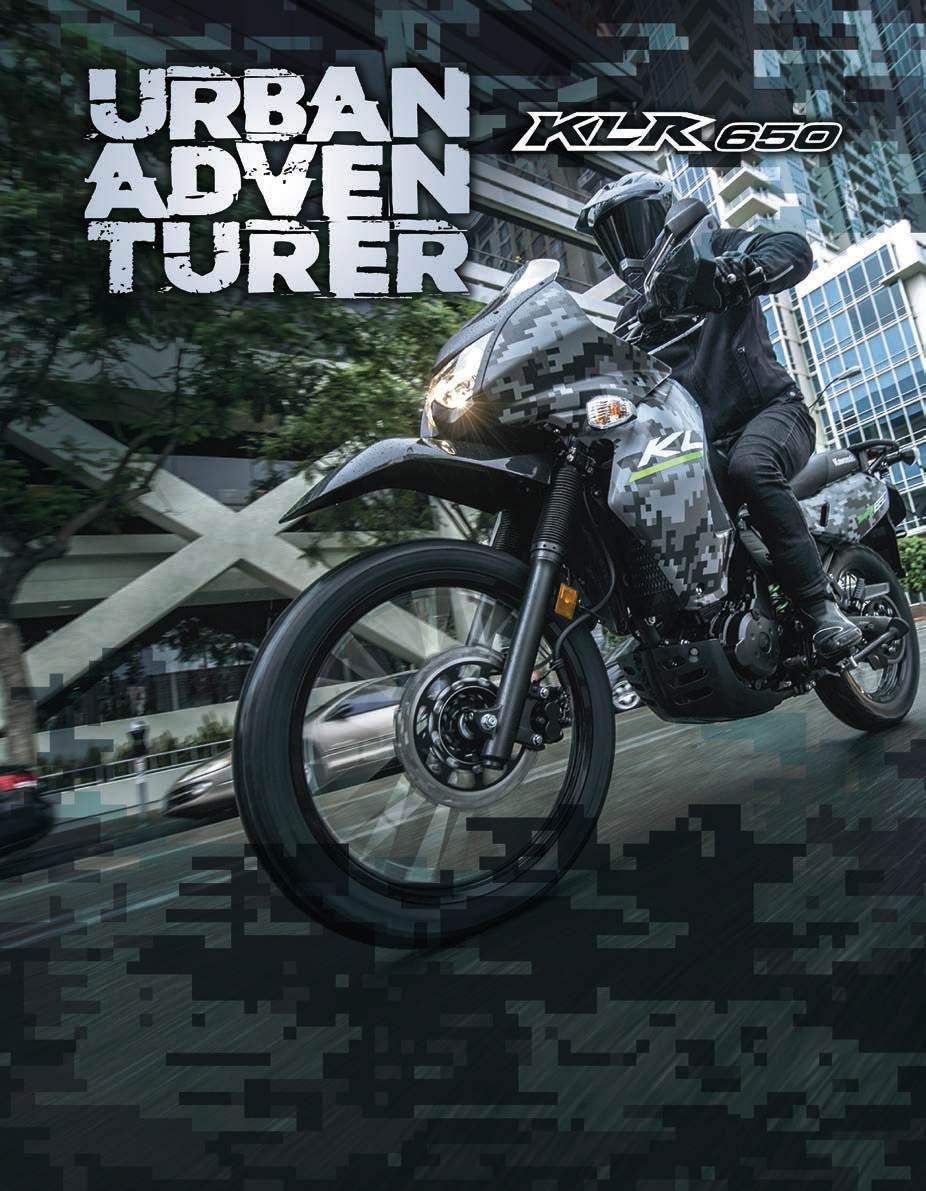
kawasakiaus

www.kawasaki.com.au